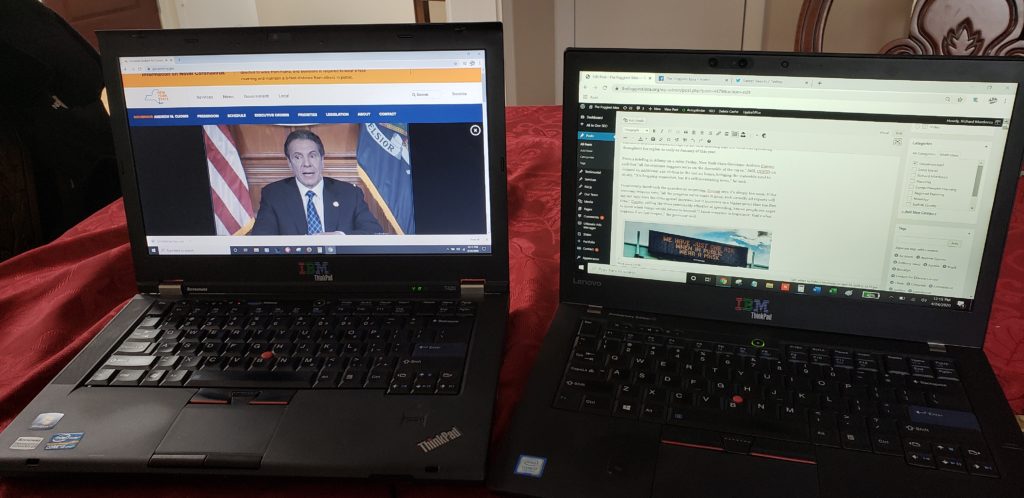During times of emergency, The Foggiest Idea provides original reporting and consolidates the reports of various news outlets to provide accurate, timely, and useful information to help reduce the spread of misinformation that jeopardizes timely response.
Sources of consolidated updates include the offices of local and state elected officials, agencies such as the National Weather Service and Centers for Disease Control, and publications such as the New York Times, Washington Post, Wall Street Journal, and Newsday.
Given the unprecedented nature of the response to the coronavirus/COVID-19, TFI is keeping a running thread of the latest developments and policy analysis. Please be mindful of the time and date, highlighted in bold, of each update.
By Richard Murdocco
UPDATE AS OF THURSDAY, MAY 28th, 2020:
From Richard Murdocco, founder and publisher of The Foggiest Idea
Since March 13th, The Foggiest Idea has published regular updates on the impacts of the coronavirus throughout the New York metropolitan region. The goal of this effort was to ensure direct communication of essential information regarding the virus’ spread that was relevant, useful, and accurate.
Totaling over 43,000 words, these coronavirus updates were written during the course of the last 76 days. Collectively, this work is the by-product of hours spent researching, drafting, editing, as well as capturing photos of a region in the midst of a pandemic.
Even as the news grew darker, readers were kind enough to share with me their words of support in regards to The Foggiest Idea’s daily efforts. These thoughtful messages offered encouragement during uncertain times and inspired me to keep writing each day.
With both the rate of new coronavirus infections locally slowing and the majority of New York State now proceeding with a phased reopening process, it is no longer necessary to provide regular recurring updates through TFI. In the coming days, you can expect more of the award-winning reporting and analysis of the land use, environmental, and development-related issues that this platform is typically known for.
That being said – if the virus once again flares up in the New York area, TFI will proceed to shift to emergency messaging as has been done during these past two months.
I’d like to express my gratitude to the hardworking local journalists who kept the public informed and made TFI‘s work possible during a crisis, to the first-responders and essential workers that continue to keep our region going, as well as you, the readers, for your continued engagement.
Thank you for your support – and for continuing to #GetaFoggyIdea from The Foggiest Idea.
RJM
UPDATE AS OF 2:30 PM, WEDNESDAY, MAY 27th, 2020:
After an extended shutdown that lasted for over two months, Long Island’s regional economy is beginning the cautious process of reopening. All non-essential businesses in both Nassau and Suffolk counties have been closed since March 22nd.
Long Island’s reopening means that people can now pick up their retail purchases in stores or at curbside, and work can restart in both the manufacturing and construction trades throughout the majority of the state. Meeting five of the seven coronavirus benchmarks, New York City remains the only area to remain on what Governor Cuomo has labeled a “pause.” City Mayor Bill de Blasio has expressed confidence that the five boroughs will hit the seven benchmarks required to reopen by mid-June.
Hospital leaders on Long Island told Newsday that they are prepared if a second wave of COVID-19 emerges in the coming weeks. “We’ve seen people go out the last few weekends, and maybe throw caution to the wind a little bit,” Dr. Joseph Greco, NYU Winthrop Hospital’s chief of hospital operations, said. “We haven’t seen the numbers go up. Luckily, we continue to see a decrease. But if that changes, and there is a surge of some kind, we will be ready.” Since the pandemic’s peak around April 10th, area hospitals have seen an 80% decline in the number of coronavirus patients being treated within their facilities.
Across New York, reopened businesses are to follow a strict set of guidelines established by the state, including requirements for stores to provide both customers and staff with personal protective equipment, space to allow for social distancing, among other measures. You can review the industry-specific guidelines that apply to non-essential businesses in reopened areas here (https://forward.ny.gov/industries-reopening-phase). Local leaders expect there to be at least two weeks between each of the remaining reopening phases, so that proper monitoring of the pandemic can continue. The additional phases include:
Phase II: Finance, Retail, Insurance, Real Estate
Phase III: Restaurants, Hotels
Phase IV: Theaters, Schools
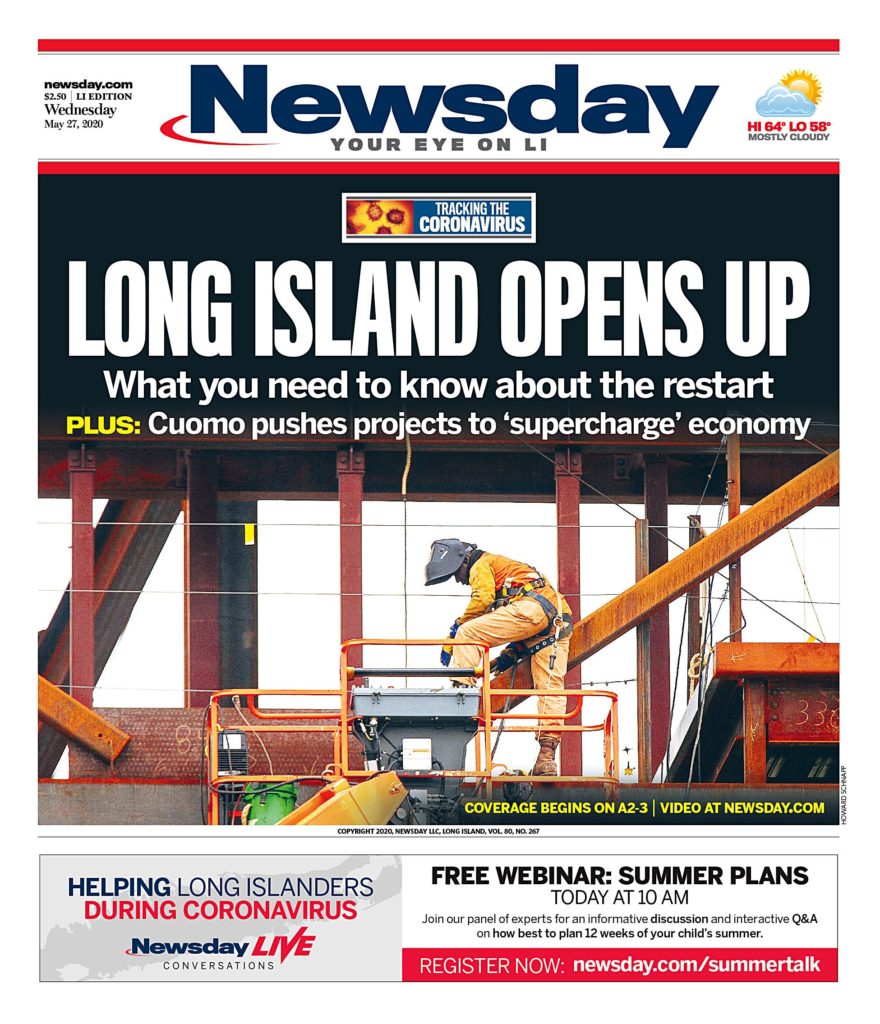
Pictured: The cover of Newsday on Wednesday announces the gradual reopening of Long Island’s economy. Nearby New York City, the hardest-hit by the pandemic, remains the only region in New York State that has not begun to reopen. (Photo Credit – Newsday)
With the suburbs formally reopened, the Metropolitan Transportation Agency plans to expand service on both the Long Island Rail Road and Metro-North systems, with both commuter railroads putting additional trains in service for the first time since the agency’s “essential service” plans went into effect. Riders using mass transit are required to wear a mask at all times and engage in social distancing when able.
New York State Governor Andrew Cuomo met with President Trump at the White House on Wednesday afternoon, and the men, both Queens natives who have had a roller coaster relationship since the pandemic began, discussed additional spending for infrastructure projects in the downstate region. During Cuomo’s daily press briefing from the National Press Club in Washington D.C., the governor shared some details about the sit-down.
Noting that there are well-documented political differences between the President and himself, Cuomo said that the meeting was about large-scale projects such as the Gateway Tunnels beneath the Hudson River, the Second Avenue Subway in Manhattan, and the LaGuardia AirTrain. “It was a good conversation, the president is from New York, so he had all of the context,” Cuomo explained, adding that both he and the president will talk again next week.
Projects from other regions of the state, including the expansion of sewer networks in Suffolk County, were not mentioned. “No, I didn’t want to give him too long a list. I didn’t want to seem too aggressive,” Cuomo said in response to a Newsday reporter’s question on the subject.
In addition, the governor stated that hospitalizations and new COVID cases continue to drop throughout New York, and an additional 74 have died from the virus statewide. “Only in this time of crisis would 74 deaths be anything less than truly tragic news,” he remarked.
Using his D.C. venue as a national platform, Cuomo didn’t hold back his thoughts concerning the role that the federal government should play in assisting states. “I understand that states are responsible for the reopening,” Cuomo said. “There cannot be a national recovery if the state and local governments are not funded.” According to Cuomo, a lack of federal support to localities will result in cuts to essential services like hospitals, schools, and police and fire departments. “Is now the time to savage essential services?” Cuomo asked, adding that the states hardest hit by the coronavirus represent one third of the nation’s gross domestic product.
Seated in front of a display of quotes from Republican policymakers who currently oppose funding New York and other states which have borne the brunt of costs from the pandemic, Cuomo called partisan arguments about such federal relief funding “ugly and “un-American.” “There cannot be a national recovery if the state and local governments are not funded. That is a fact,” Cuomo raged.
Shifting to infrastructure, Cuomo noted that much of the country is living on networks that were built during the Great Depression. “We have major infrastructure projects in New York that are ready to go, that are desperately needed that were desperately needed 30 years ago,” he said, urging lawmakers in Washington to listen.
National Hockey League Commissioner Gary Bettman and the N.H.L. Players’ Association have agreed to terms on resuming the 2020 season, including a new 24-team playoff format. The NHL’s decision is the first among the major sports leagues to formally offer a road map for a return to play. Crowd-less NASCAR races have also resumed in recent days, and Major League Baseball is currently ironing out the specifics of their 2020 season with players. The PGA Tour is slated to return on June 11th.
Nationally, the lack of demand of gasoline may have rewarded consumers at the pump, but negative impacts on wallets may be felt another more obscure way – through rising prices of both soft drinks and beer.
According to the Wall Street Journal, carbon dioxide used for soft drink carbonation is a by-product that is directly tied to the ethanol that is federally-mandated to be mixed into gasoline. As such, with ethanol production plants shuttering temporarily as fewer people drive, gas-industry experts say that CO2 production has fallen as well, putting pricing pressure on roughly 40% of all industrial carbon dioxide produced nationwide, a key ingredient for soft drinks and beers. Prices of CO2 have risen by 25% or more in recent months, but companies told the WSJ that supply remains a non-issue thanks to reduced levels of demand from closed restaurants.
UPDATE AS OF 1:15 PM, TUESDAY, MAY 26th, 2020:
Downstate New York is taking a large step towards a return to normalcy on Tuesday as Westchester, Putnam, and Rockland counties all begin their first phase of reopening. On Long Island, restrictions are expected to be lifted on Wednesday if the daily number of deaths from the coronavirus exhibits downward progress.
If Long Island does in fact begin to loosen lock-down orders, New York City will remain the sole area in New York that is not restarting it’s economy, as the city meets four of the seven benchmarks that were established by the state earlier this month. “New York City is the one region that has not opened yet. The numbers are worse,” New York State Governor Andrew Cuomo said of the city’s progress during a briefing held from the New York Stock Exchange on Tuesday. Cuomo was at the NYSE to mark the partial reopening of trading floors for the first time since March 20th.
Across New York, the number of daily deaths from the virus dropped below 100 for the first time since late March. An additional 289 people have died statewide from COVID-19 over the extended holiday weekend, and there were 73 additional COVID deaths yesterday Cuomo said, representing the lowest daily number of fatalities from the virus in at least two months.
Nationwide, re-openings are proceeding as the U.S. is poised to surpass the grim milestone of 100,000 coronavirus deaths. The pandemic’s toll is now greater than the combined death count from every war that the U.S. has fought in the past 60 years.
To New York’s governor, the virus has presented the public sector with a unique opportunity for both the state and country to boost the economy by investing in long-neglected infrastructure networks.”There is no better time to build than right now, when some of the volume is lower. The time to fix the hole in the roof is when the sun is shining,” Cuomo stressed, saying that the efforts behind the state’s major infrastructure projects will be accelerated. Such projects include the expansion of Penn Station, or the construction of the new LaGuardia Airport. Cuomo said that he will be meeting with President Trump on Wednesday to discuss the need for additional federal investment. “It’s common sense – you have an infrastructure that’s crumbling, you need to jump start the economy, it just makes sense,” Cuomo argued.
Over the weekend, the White House imposed new travel restrictions on travel from Brazil, an emerging hot spot of the pandemic. The move came as President Trump hit the golf course, sans mask, for the first time since late March. Globally, countries continue to ease lock-down restrictions on their economies even as new infections and deaths continue to climb. On Monday, both presumptive Democratic presidential candidate Joe Biden and his wife Jill wore black protective face masks as he made his first public appearance in two months in order to lay a memorial wreath in honor of fallen soldiers at a veterans park in Delaware.
Despite the virus’ continued spread, crowds across the U.S. kicked off the unofficial start to summer by gathering en masse at bars, restaurants, and outdoor events. In areas of Houston, club goers danced and drank, while the streets and boardwalks of Daytona Beach were filled with revelers.
Locally, video taken on Friday night from the Dublin Deck Tiki Bar and Grill, a bar within the Village of Patchogue, showed packed crowds as drinks flowed and music blared. Police responded to multiple calls about crowding at the location, but authorities did not tell Newsday how many people were in the bar. No summonses were issued, the Suffolk County Police Department said.
Elsewhere on Long Island, multiple state parks hit capacity limits during various points of the long weekend, but the abnormally cooler weather kept crowd sizes manageable at the beaches. In the Town of Smithtown, Main Street sat relatively quiet as volunteers hung American flags from lampposts. Further east, scaled-back memorial services were held at Calverton National Cemetary, as volunteers continued the tradition of placing flags at gravesides.
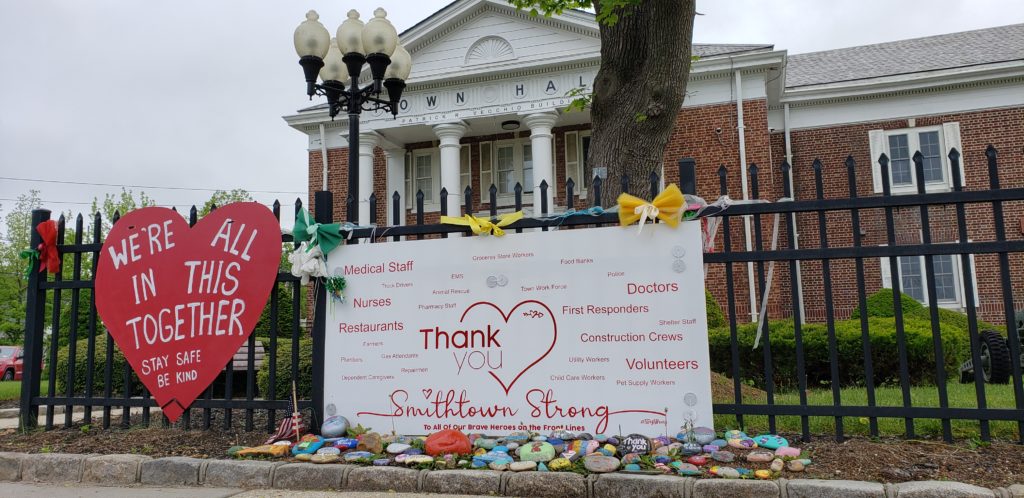
Pictured: A display at Smithtown Town Hall honors first responders and essential workers during a rainy start to Memorial Day. If current trends continue, Long Island is poised to begin reopening on Wednesday. (Photo Credit – Richard Murdocco/The Foggiest Idea)
The pandemic continues to impact both the availability and price of food on shelves, as the virus continues to ravage slaughterhouses and meat processing plants nationwide. On April 28th, President Trump had issued an executive order designating meat plants “critical infrastructure” that must stay open, but the action did not address issues like testing, leaving many plant operators in the dark about whether employees had contracted the virus.
Industry experts are estimating that supplies of meat in grocery stores could shrink by as much as 35 percent. Prices are estimated to spike 20 percent, with sources telling the Washington Post that the impacts could become even “more acute later this year” as the shortages resonate across the national supply chain.
UPDATE AS OF 12:15 PM, FRIDAY, MAY 22nd, 2020:
From Manhattan on Friday, New York State Governor Andrew Cuomo said that if current trends persist, both Long Island and the Mid-Hudson Valley can begin their reopening in the coming days.
“If the number of deaths continue to decline the way it has, and they get their tracing online, both regions can reopen this week,” the governor said, adding that construction staging will now be permitted in both areas in anticipation of the reopening.
Cuomo stated that “the news is good” on the 83rd day of the coronavirus crisis, as both the number of hospitalizations and new COVID cases continue to wane statewide. The number of daily deaths remain relatively flat, with an additional 109 people dying from the virus within the last 24-hours. “This number has been stubborn on it’s way down,” Cuomo said of the deaths, going on to note how quickly the virus first struck compared to the slow decline we are now seeing.
With Long Island meeting five of the seven key benchmarks needed to reopen, an expert told Newsday that at least one of the metrics required by the state may have set the bar too high. Yesterday, Long Island’s hospital capacity dipped below 30%, a figure that may not be fully attainable in the first place, says Dr. David Battinelli, the chief medical officer at Northwell Health. Battinelli told Newsday that most Northwell facilities didn’t have 30% of hospital beds available even before the pandemic. “It’s a few beds in one direction or the other,” he noted, calling the oscillation in capacity during the last few days statistically insignificant.
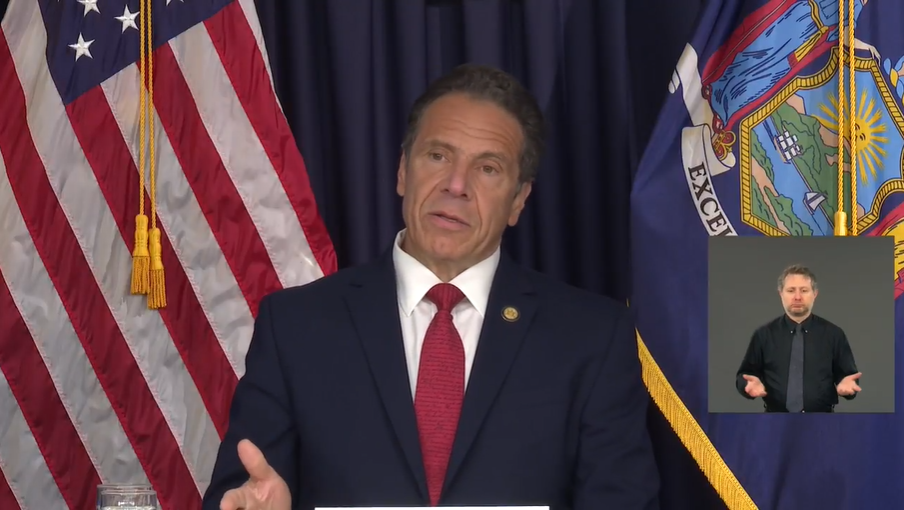
Pictured: NYS Gov. Andrew Cuomo answers a reporter’s question during a briefing from New York City on Friday. (Photo Credit – NYS Governor’s Office)
As the New York metropolitan area prepares for the unofficial start of the summer this weekend, localities are readying their shorelines for quarantine-weary crowds.
In New York City, Mayor Bill de Blasio cooled his rhetoric about his decision to close city beaches, saying that while bathing areas still remain formally closed, locations such as Orchard Beach in the Bronx or Coney Island in Brooklyn are open for nearby residents who want to walk on the sand. Swimming and any group activities are still prohibited. The mayor warned residents to not take mass transit to get the shore, stating that the city would enforce limits on crowding and fence the areas off if necessary. As city lifeguards begin their seasonal training, officials have indicated that they are seriously considering opening its beaches sometime in June.
In the response to the city’s decision on the sustained closures this past week, localities throughout the suburbs have circled the wagons by making their own coastal areas open to residents only.
In Westchester, Croton Point Park and Playland beaches will only allow county residents, while Long Island’s beaches will stay accessible to locals nearly island-wide. As such, access is limited at the various county beaches operated by both Nassau and Suffolk, as well as at numerous town-run beaches extending as far east as the Town of Southampton. In the City of Long Beach, one of the closest locales to the city, beach passes will be sold to residents only, but the boardwalk is open to all. Local officials have said on numerous occasions that all residency requirements will be lifted once city beaches formally reopen.
“I think we have more of an operational issue,” Cuomo said of the closures and restrictions. “Because the city beaches are closed… you’ll have more demand on the state beaches.”
“They can make sense for that locality and still create a regional issue,” Cuomo added, noting that he understands the need for such measures in New York City and on Long Island. “We do have state beaches open for precisely that reason.”
New York State-run beaches, including Jones Beach and Robert Moses State Park, remain open to everyone, and strict social distancing measures will be enforced. In addition, federal properties such as Jacob Riis Park in the Rockaways are open for passive recreational use. All beaches region-wide will have their parking lot capacity capped at 50 percent.
“You have to remain vigilant,” Cuomo said, adding that reports of second waves and hot spots are emerging. “We are still learning about this COVID-19 virus, and one of the things I find most infuriating is that the facts continue to change with this virus,” he said, citing the various changes in guidance that have occurred since the pandemic first started.
In addition, Cuomo announced that New York State will soon be starting a targeted loan fund meant to bolster small businesses. Priority in support will be given to minority and women-owned enterprises with less than 20 employees.
In Nassau County, finance officials are discovering that coffers were harder hit by the pandemic than initially expected. They now estimate that Nassau faces a $384 million budget shortfall. The county’s finances were already under stress before the coronavirus hit, and the loss of nearly $261.7 million in sales taxes revenue has further amplified the fiscal situation.
Nationwide, indicators show that people still aren’t comfortable flying, as the number of travelers screened at T.S.A. airport checkpoints remain more than 90 percent lower compared to this time last year, despite there being no active restrictions on flights. Most major airlines are requiring passengers and flight crews to wear face masks, though reports say that enforcement has been inconsistent.
Across the U.S., applications for mortgages to purchase a home have risen consistently the last five weeks, according to the latest figures within a Mortgage Bankers Association survey. Experts say that the stable growth indicates that the worst may have passed economically, but warn that the figures are no guarantee the market will continue to gain ground.
UPDATE AS OF 12:30 PM, THURSDAY, MAY 21st, 2020:
An additional 2.4 million people have filed for first-time unemployment benefits last week, bringing the total number of jobless workers across the U.S. to just over 38.6 million. The figures come as Congress and the White House spar over the extension of enhanced unemployment aid that was passed by lawmakers in late March, which includes an extra $600 in weekly payments to those who are out-of-work.
In New York State, the downstate regions, which include New York City, the Mid-Hudson Valley, and Long Island continue to struggle to hit seven out of seven of the criteria that the state is requiring to begin the first phase of reopening. In the City, four of the seven benchmarks have been met, unchanged from yesterday. Long Island’s progress has once again backslid from initially meeting five of the seven to now just meeting four, as regional hospital capacity remains an issue. The Mid-Hudson region has remained steady at meeting five of the seven metrics over the last few days. Other benchmarks include a day-by-day reduction in the regional infection rate, as well as subsequent day-after-day drops in COVID-related deaths.
From New York City on Thursday, Governor Andrew Cuomo said that the rate of new COVID infections are “actually lower than we were when this first started.” An additional 105 people have died from the coronavirus yesterday, bringing the statewide total to 22,019.
Cuomo also said that Rockland County joins both Nassau and Suffolk Counties as well as the upstate regions who have begun reopening in being eligible for ambulatory services and elective surgeries. “It does not have to be that increased activity leads to increased cases,” Cuomo stressed. “None of this is preordained. As you increase activity, what will happen is a function of what we do.”
Soon, New Yorkers will be getting a phone call from “NYS Contact Tracing” as the statewide roll-out of a coronavirus contract tracing program begins. If a New Yorker tests positive, a contact tracer will interview them to better understand who they may have infected, and the outreach will follow. “If you get that message, take that phone call,” Cuomo said.
The state is now investigating 157 cases of the newly emerging COVID-related pediatric multisystem inflammatory syndrome in children. Cases have been formally identified in 13 countries. “The more they look, the more they are going to find,” Cuomo said. As such, in-person summer school will be not opening state-wide, Cuomo announced, but distance learning can continue as-needed. While no formal decision has been made on the opening of both summer and day camps, Cuomo says as a dad, he wouldn’t send his kids to a camp this season.
Regarding the start of a new school year in the fall, Cuomo said that it’s still too early to make that determination, especially as new details about the virus’ impacts on children continue to emerge. State guidelines are slated to arrive to districts and universities by June, and their own mitigation plans will be due by July. Given that the facts about the virus keep on changing, Cuomo is urging New Yorkers to take caution as the newly-discovered syndrome is better understood.
In addition, Cuomo once again stressed that if the federal government doesn’t provide additional financial support for states, there will be direct consequences to funding for school aid, hospital, and essential workers within localities. “We have to see what Washington does. Otherwise, you know the equation … 20% budget cuts,” the governor noted.
Throughout New York City, residents are once again using the subway system, with ridership being 50% higher compared to last month. The increase marks the first time daily ridership surpassed 600,000 subway rides a day since late March. In April, ridership plunged 94% as the pandemic raged across the five boroughs. In another sign of a return to normalcy, alternate-side parking rules went into effect city-wide for the first time in more than two months. After Sunday however, the rules will once again be suspended for at least two weeks.
On Long Island, the Town of Smithtown will be holding a first-of-it’s-kind virtual town board meeting over Zoom on Thursday afternoon, with a controversial proposal to allow for residential units within the Hauppauge Industrial Park poised to dominate the discussion. While the meeting is open to all to view, only town residents will be permitted to actively participate.
James Bouklas, president of the Nesconset-based civic group We Are Smithtown, criticized the decision to hold a meeting on such a weighty topic virtually. “Instead of trying to make sure Smithtown families are fed, food banks are in stock, and residents have the resources that they need, the town is spending time trying to figure out how to get developers to profit for building what we think is going to be Co-op City in Smithtown,” he told the Times of Smithtown earlier this month.
An executive order issued on March 20th temporarily suspended elements of the New York’s Open Meetings Law to allow for local county, town, city and village meetings to be held by video conference.
Across the nation, all 50 U.S. states have now taken steps to reopen, with Connecticut being one of the last to loosen their restrictions. The reopenings come as the country hits the grim milestone of 95,000 COVID-related deaths. Even with localities reopening in phases, large swaths of states, including major metropolitan areas, remain mostly shut.
The Centers for Disease Control is shifting it’s guidance concerning the infection risk from contaminated surfaces, as new reports indicate that the virus “does not spread easily” through surface contact.
“I think what it means is that we can go ahead and not be as concerned about that,” Dr. John Torres, NBC News’ medical correspondent, said on Thursday. “We still need to be a little bit concerned and still do the things we need to do to stay safe, and that means mainly washing your hands.”
UPDATE AS OF 12:45 PM, WEDNESDAY, MAY 20th, 2020:
The Capital Region, which includes both Albany and Saratoga Counties, will be the seventh area of New York State to reopen it’s economy, New York State Governor Andrew Cuomo announced during his daily briefing from Albany on Wednesday.
As of writing, New York City has made progress towards reopening as it meets four of the seven benchmarks that the state requires to be met in order to restart economic activity. The mid-Hudson Region has also improved within the last 24-hours, now meeting Long Island’s progress with both suburban areas hitting five of the seven reopening benchmarks.
“There is nothing that is preordained. What is going to happen is a consequence of our choices and a consequence of our actions, it’s that simple,” Cuomo said of the reopening progress. “If people get arrogant, get cocky, get casual, if people become undisciplined, you will see the infection rate go up.”
Statewide, hospitalization and infection rates continue to move downward. The trends are declining even as an additional 112 New Yorkers died from COVID-19 yesterday, a slight uptick from the day before. The deaths on Tuesday brings the total toll from the virus to at least 21,914. Throughout the pandemic, experts have argued that all reported coronavirus death counts should be taken with a grain of salt since the state does not include probable virus-related deaths within their count.
In addition, New York will begin allowing religious gatherings with up to 10 people and with social distancing measures enacted, Cuomo said. In addition, the state will allow visitors at 16 hospitals, including six in New York City and two on Long Island, Huntington and Plainview Hospitals.
To further instill rider confidence in the cleanliness of the city’s transit systems, the Metropolitan Transportation Agency plans on using 230 ultraviolet-C lamps to disinfect city buses and trains. Typically, the lamps are used in hospital and food processing settings. The MTA’s use of these lamps represent the first time they are being put to use by a mass transit agency, and if successful, will eventually be used on both the Long Island Rail Road and Metro-North systems in the coming weeks as well. System-wide, ridership on buses and trains have ticked up slowly from lows as the pandemic peaked.
While New York City Mayor Bill de Blasio continues to hold firm on his decision to not open city beaches for Memorial Day Weekend, he argued that beaches on Long Island should welcome those from the five boroughs. In recent days, localities on Long Island have responded by enacting resident-only policies. “This should not be about any ill feeling toward people depending on where they come from,” the mayor told WPIX 11 News late Tuesday night.
On Tuesday afternoon, Nassau County Executive Laura Curran expressed support for an emergency measure that makes Nickerson Beach, the county’s only beach, resident-only. Curran is expected to sign the measure later today. Further east in Suffolk County, a similar measure passed earlier this week. Jones Beach and Robert Moses State Park, both state parks, remain open to all, but with reduced capacity.
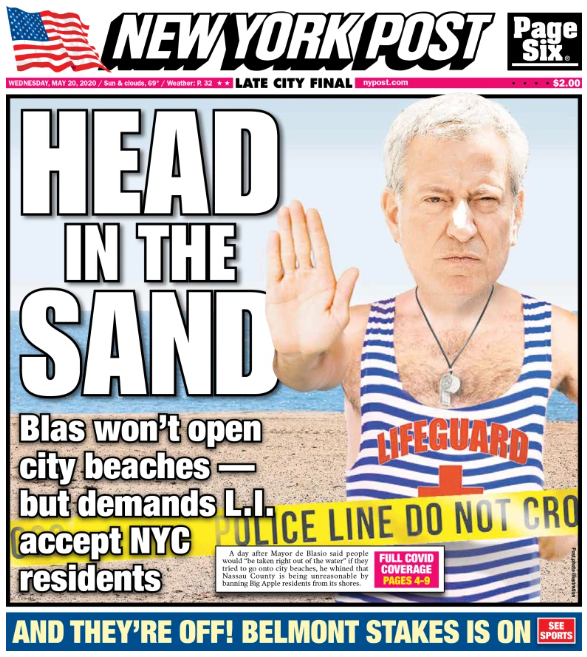
Pictured: The cover of the New York Post on Wednesday, which slams Mayor Bill de Blasio’s decision to keep beaches closed to city residents. In response to the mayor’s actions, localities across Long Island have made their shorelines resident-only. (Photo Credit – NY Post)
State Senator Todd Kaminsky, whose district includes the City of Long Beach, ripped de Blasio’s remarks, saying “It’s a shame Long Island has to turn away city beach goers to protect its residents and ensure safe beaches, but until the mayor gets his act together and makes his own beaches safe, that’s the only responsible move.” The City of Long Beach will be reopening it’s boardwalk to all on Thursday, which was first closed on March 26th. However, the sands will be for residents-only.
Across Long Island, school districts are welcoming summer early as New York State stays quiet about stopping instruction early. The reduced school year makes up for the many districts who lost their spring break during the transition to remote learning. “There really was no other choice if districts want to avoid being sued for extra pay once teachers have to work extra days,” John Gross, a lawyer who represents various school districts in Nassau and Suffolk counties, told Newsday‘s The Point late Monday. According to The Point, lawyers have advised districts to alter their closing dates to match the number of instructional days to what is in their contract.
Nationally, countless U.S. states that paid inflated prices for coronavirus gear after the Federal Emergency Management Agency advised them to make such purchases on their own are now looking for reimbursement from the federal government. Typically, states can get up to 75% reimbursement from FEMA, but President Trump has the authority to waive the rule and grant them 100% reimbursement.
Federal Reserve Chairman Jerome Powell testified to lawmakers that there doesn’t have to be a trade-off between economic growth and protecting the public’s health. “The number one thing, of course, is people believing that it’s safe to go back to work so they can go out,” Powell said, noting that fear of infection remains the economy’s biggest challenge. “That’s what it will take for people to regain confidence.”
Treasury Secretary Steven Mnuchin also appeared, saying that “there is the risk of permanent damage” if states further delay their re-openings.
UPDATE AS OF 1:00 PM, TUESDAY, MAY 19th, 2020:
From Long Island on Tuesday, New York State Governor Andrew Cuomo said that there is overall good news as hospitalizations and new coronavirus infections continue their downward marches. “It’s that bittersweet reality that we’re living in today,” he said, as an additional 105 people have died from the virus in the last 24-hours, bringing the statewide total to 21,802.
“We are basically back to where we started,” the governor said of the metrics, before noting that during the pandemic’s peak, an average of 100 Long Islanders a day were dying from COVID-19. Today, the average number of daily COVID deaths in the region stands at 13. Cuomo also announced that elective surgeries and ambulatory care is now being allowed throughout Nassau County. “Denial is not a life strategy. If you have an issue get it tested, get it resolved,” Cuomo said, encouraging residents to resume their proper courses of medical care.
In recent days, New York State has shifted it’s regional reporting for hospitalizations and coronavirus deaths, two of the key benchmarks an area must hit before reopening it’s economy. The time period now being used for both metrics will be tracked from May 15th, the day the original NY PAUSE order expired, instead of being tracked since the beginning of the pandemic. The changes made it possible for Western New York to reopen sooner than initially expected.
Statewide, five areas have reopened, while hard-hit New York City remains meeting just three of the seven reopening benchmarks that have been put in place by the state. The mid-Hudson area has met four of the seven, while Long Island has five of the seven. All three regions remain unchanged since yesterday.
Cuomo continued pressing professional sports leagues to resume games, even without crowds. “When a team plays, even if there is nobody in the stands, it gets broadcast and that gives people at home entertainment value,” Cuomo said, adding that the games are another reason for people to stay home. The governor pledged to support any efforts to resume play. “New York will be a full partner. Anything we can do to make it happen and make it happen safely.”
Horse racing is scheduled to resume statewide on June 1st, and for first time in Triple Crown history, the Belmont Stakes will be the first run of the famed race series, with the 152nd running scheduled to be held at Belmont Park on Saturday June 20th. There will be no fans in stands, and the race’s track length will be shorter.
The latest breakdown of data released by the City of New York highlights some stark realities of the pandemic, with the numbers showing that the elderly have been the most vulnerable to the virus, and neighborhoods with high concentrations of black and Latino people, as well as low-income residents, have the highest death rates.
Starrett City, the vast subsidized-housing complex in southern Brooklyn located right off of Jamaica Bay, has been home to the most coronavirus deaths in New York City, while Far Rockaway is contains the second-highest amount. On a positive note, the rate of deaths within public housing mirrors that of the city overall. In the suburbs, similar trends have emerged as the five communities on Long Island with the highest rate of COVID-19 infections contain minority populations of 70 percent or more.
Throughout Nassau and Suffolk Counties, elected officials are taking steps to protect the region’s beaches from a potential deluge of New York City residents on Memorial Day Weekend as the mayor continually reiterated the decision to keep all city beaches closed.
On Twitter Monday, City Council Speaker Corey Johnson called for a plan “ASAP” that would allow New Yorkers to use city beaches during the summer season. Mayor Bill de Blasio held firm. “It’s a different reality in Long Island. It’s a different reality in New Jersey. And I think the concern there is to follow the state rules and keep beach attendance limited, and I’m sure they’ll be able to do it,” de Blasio told 1010 WINS radio Tuesday morning.
In Nassau County, legislators are crafting an emergency bill that will require county residency at the locality’s beaches, while Suffolk County’s Smith Point and Cupsogue beaches will have driver’s license checks to verify residency. Bellone said that the locals-only policy “reflects the reality that there will be reduced capacity since other municipal beaches outside of Long Island will remain closed at this time.” All beaches on Long Island, including at state parks, will be operating at 50 percent capacity.
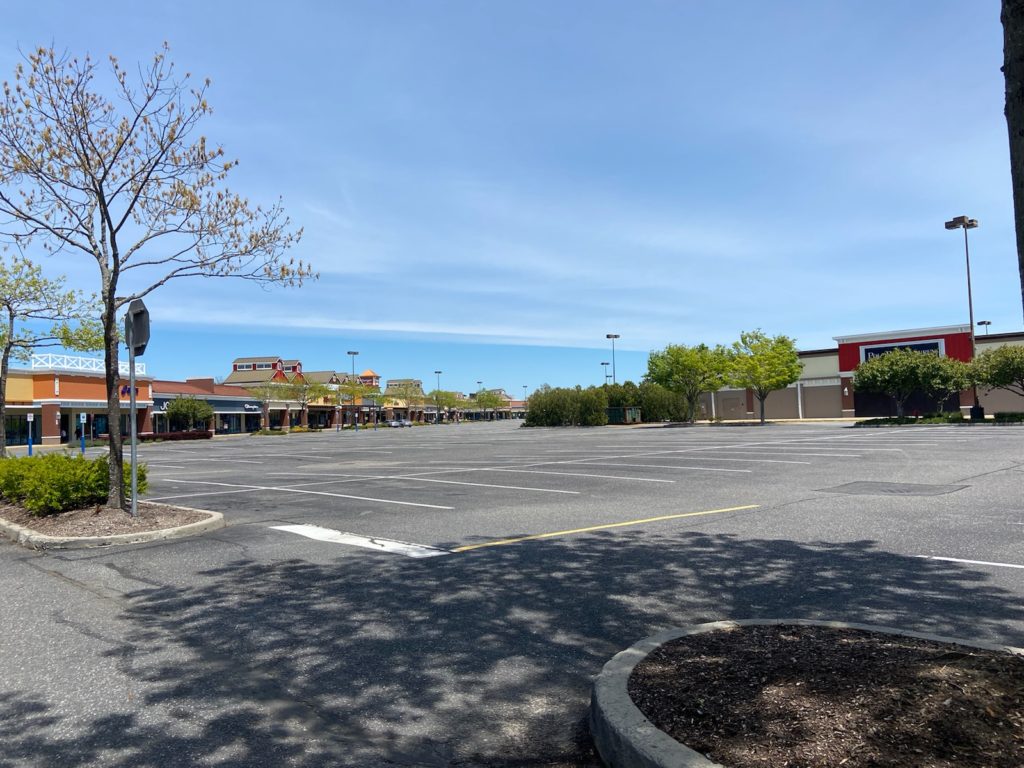
Pictured: The Tanger Outlet Center in Riverhead remains empty as the Long Island region only meets 5 out of 7 of New York’s reopening criteria. (Photo Credit – Maria Lifrieri/Freelance)
Pressing for additional federal aid in the next round of a congressional coronavirus relief package, Cuomo said that lawmakers in Washington should “show the same consideration for the workers that they’ve shown the corporations.” Stressing that the financial needs of localities are an a-political issue, Cuomo said “You can’t tell the states go reopen, figure it out, and not provide the funding.”
Municipal financial experts told Newsday‘s Michael Gormley that New York’s financial crisis isn’t exactly as dire as Cuomo makes it out to be. “There is a valid argument for New York State getting additional federal aid, but the $61 billion number is not what the state really needs,” David Friedfel, the director of State Studies at the Citizens Budget Commission, said, noting that the state budget that was passed recently already has mechanisms in place to bring New York’s deficit down from the estimated $13.3 billion to $8 billion. Options being considered by state lawmakers include new taxes on the wealthy. “If the state does all of the other things it can do, then taxes should be the last thing they look at,” Friedfel added.
Across New York, officials said on Tuesday that there have been 137 confirmed cases of the emerging pediatric multisystem inflammatory syndrome that health experts say is related to coronavirus infection. “This is a very serious issue,” Cuomo said, adding that there are likely to be more cases in the coming days as more is learned of the virus’ impacts on children.
Nationwide, nearly 130,000 autoworkers have returned to factories on Monday, as Ford, General Motors, and Fiat Chrysler look to resume auto production in the coming days. The companies have enacted social distancing measures at their plants, and workers are undergoing temperature screenings and questionnaires about COVID-19 symptoms. Overall, industry experts expect that production will take some time to recover as manufacturing ramps back up.
UPDATE AS OF 1:00 PM, MONDAY, MAY 18th, 2020:
Yet another region of New York State will soon restart it’s economy as Western New York has met each of the key benchmarks required to reopen, New York State Governor Andrew Cuomo said Monday during a press conference in Buffalo. The news come as the state reclassified the tracking methods that measure both decline in COVID-19 hospitalizations and deaths.
As of writing, New York City has slid back to meet only three out of the seven benchmarks needed to reopen, while Long Island has met five of the seven, increasing by one measure from last week. The Mid-Hudson valley remains at four out of the seven. At six of the seven metrics hit, the capital region, which includes Albany, remains on the cusp of reopening. Overall, hospitalizations and new infection levels are down statewide, and an additional 402 have died from COVID-19 over the last three days, Cuomo said Monday.
Over the weekend, Cuomo had urged more people to get coronavirus testing, going so far to have himself tested in the middle of his live briefing in Albany yesterday. His test came back negative, the governor said Monday. “It gives you peace of mind,” he noted before urging anyone with flu-like symptoms to get tested.
State health officials are now calling on residents who exhibit even mild symptoms to get tested to help in efforts to better trace and contain the virus. The shift in approach comes as New York has drastically increased it’s ability to test for coronavirus and antibodies to the virus. Up until now, officials encouraged those with mild or no symptoms to stay home rather than risk getting sick or infecting others by seeking a test. More than 320,000 coronavirus tests will be sent directly to nursing homes, and lab capacity has been scaled up to accommodate a new directive that says such facilities must test staffers twice a day.
While most state and local beaches in New York, New Jersey, Delaware and Connecticut are getting ready to reopen for the upcoming Memorial Day Weekend, one locality has opted not to reopen their shores – New York City. “I’ve said it before, and I’m gonna say it again. We are not opening our beaches for Memorial Day,” New York City Mayor Bill de Blasio said on Sunday. “No swimming. No parties. No sports. No gatherings,” the mayor continued, but did note that residents can walk on the sand if they so choose. “We’re going to give people a chance to get it right.”
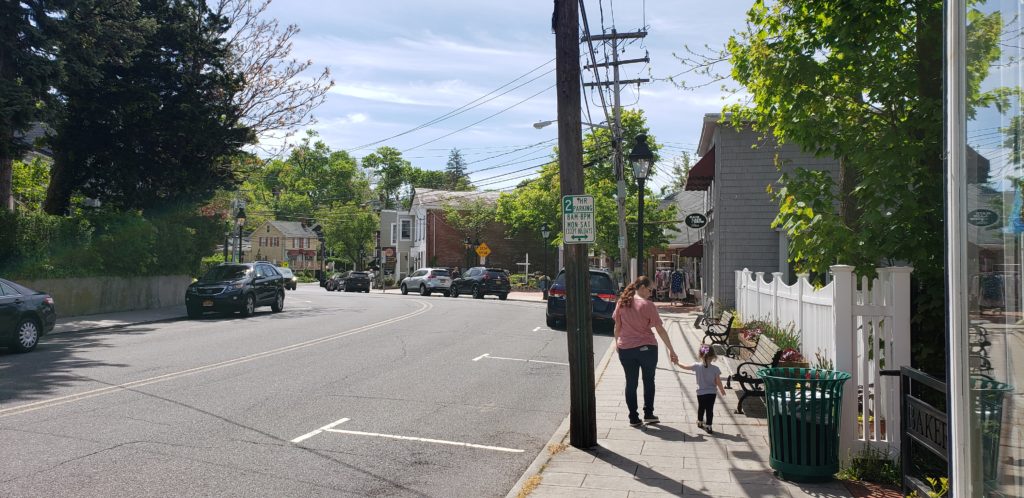
Pictured: Port Jefferson Village sat quiet on Saturday morning, as Long Islanders continue to stay home during the coronavirus pandemic. In contrast, areas of upstate New York are beginning the phased process of reopening. (Photo Credit – Richard Murdocco/The Foggiest Idea)
On Long Island, the news of the city’s sustained beach closures ruffled the feathers of local leaders. “Everyone has a right to enjoy a safe summer with fresh air and relief from the heat, which is why the mayor’s refusal to implement social distancing guidelines and enforcement to keep NYC beaches open, like every other municipality in the tristate area, is both irresponsible and short sighted,” Christine Geed, Nassau County’s communications director, told Newsday. Geed adding that by choosing not to re-open, Mayor Bill de Blasio is shirking his responsibility.
“What we do know is kids are home from school, the weather is getting warmer and warmer, and people are going to beaches,” Suffolk County Executive Steve Bellone said, calling the re-openings “the right thing to do” because people would go to the beaches anyway. “It is far better for us to have beaches reopen with safety protocols in place from the beginning in a controlled way so we can manage that.”
Nationally, lawmakers are considering significant changes to the Small Business Administration’s Paycheck Protection Program that would give businesses more flexibility in spending the money, as well as extend the time allowed to spend loan money. Both requirements drew the ire of recipients, who called the policies restrictive to their long-term recovery. Under the program’s original terms, 75% of the funds were required to be spent on employee salaries within a two month period for the loans to be forgiven.
As the country moves towards reopening, health experts say that it’s important to remember that data showing rates of infection is lagged, as most people who develop symptoms don’t do so after infection for at least five days, if not longer. The worst symptoms usually take almost three weeks to appear.
“The data are always two or three weeks old,” Ezekiel Emanuel of the University of Pennsylvania told the New York Times‘ David Leonhardt. “And we have a hard time understanding that things are different from what we’re looking at.” Crystal Watson of Johns Hopkins University told The Associated Press that we wouldn’t really know how reopening had affected the virus’s spread for five to six weeks.
Moderna, a drug maker, announced Monday that it’s experimental coronavirus vaccine yielded positive responses in a clinical study, and the shots were generally safe and well-tolerated. While showing encouraging progress in these preliminary results, experts say that many vaccines fail to get approved in subsequent testing. If all goes well, the company’s vaccine could be ready for emergency use as early as the fall.
UPDATE AS OF 12:45 PM, FRIDAY, MAY 15th, 2020:
New York State Governor Andrew Cuomo issued an executive order late Thursday night that extends stay-at-home orders for regions that do not meet the state’s seven reopening criteria through May 28th. Impacted areas of the extension include New York City, Long Island, and the Mid-Hudson Valley. As of writing, five regions in Upstate New York, half of the state, can begin the first phase of restarting their economies. “If a region hits it’s benchmark at any time, regardless of the PAUSE order, than that region can open,” New York State Governor Andrew Cuomo said during a briefing in Albany on Friday afternoon.
While other areas begin reopening, Long Island’s progress against the pandemic has backslid as the Nassau/Suffolk region now only meets four of the seven reopening criteria outlined by the state, matching hard-hit New York City. Previously, the island met five of seven as recently as yesterday, but slipped as the region contains the highest rate of people hospitalized for coronavirus in the state – highlighting strains on both hospital capacity and rate of coronavirus infection. In total, Suffolk County hospitals at at 69% occupancy and ICU beds have around 67%, both below the 70% occupancy benchmark set by the state to allow for reopening.
Noting the downward trends, Cuomo said that there have been several plateaus in the declines in new infections and hospitalizations, which he attributes to where new infections are taking place. “We’re talking about home spread,” Cuomo said. “That’s the hardest place to control the spread.” Statewide, an additional 132 have died, bringing New York’s total number of deaths to 21,295.
In a coordinated regional action, beaches in New York, New Jersey, Delaware, Connecticut will be reopening on the Friday of Memorial Day Weekend. State beaches will allow no more than 50% capacity, not allow any group contact activities such as football or volleyball, and concession stands, picnic areas, playgrounds will all remain closed. Social distancing measures will be enforced, and visitors must wear masks as needed. Local governments are to decide to open local beaches, including those found within townships on Long Island and across New York City, but must adopt the state’s requirements “at a minimum,” Cuomo says.
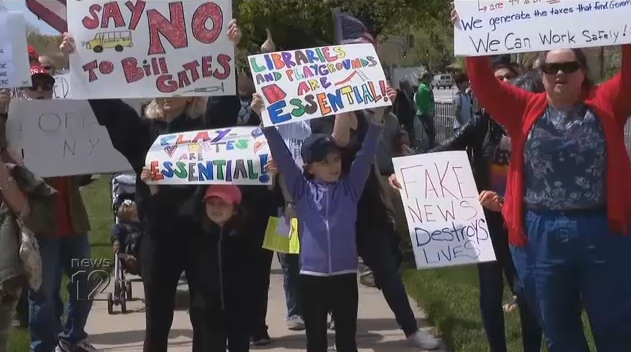
Pictured: Protesters hold signs urging the reopening of the economy in Commack on Thursday. Other signs seen at the rally included “Trump 2020” banners and a hand-made sign that read “Hang Fauci. Hang Gates. Open all our states.” (Photo Credit – News 12 Long Island/Kevin Vesey)
“The facts here have been changing, and the facts have only been getting more negative,” Cuomo said of the virus. “Everyone is vulnerable to this virus, and government can’t keep you safe. Only you can keep yourself safe.”
Housing markets in suburban markets remained strong last month, despite seeing steep declines in sales activity. Pricing island-wide rose on average 11.6% in the last 12-months, while the number of home sales tanked nearly 38% compared to this time last year. Broker’s attribute the pricing increased to the market’s lack of supply of homes for sale.
The New York Stock Exchange will be reopening it’s trading floor on May 26th, nearly two months after the pandemic forced it’s closure. Traders on the floor will be required to wear masks and follow social-distancing rules. For jobless in New York, the governor’s newly-signed executive order also contained a provision that expedites the granting of unemployment benefits through June 13th. In total, the state has paid out more than $7.4 billion since March.
Nationally, pressure is mounting on Congress to pass additional coronavirus relief measures, as 36.5 million workers grapple with unemployment and states continue to face unrelenting financial strains due to the pandemic. In recent days, there have been growing cries for any action to be taken to include provisions for the federal government to give direct financial support for states and localities, a measure Governor Cuomo has been advocating for as New York faces billions in revenue deficits.
With Congressional House Democrats proposing an all-new $3 trillion relief measure, Senate Republicans are being inched back towards the negotiation table. “States are going to go under,” Representative Peter King of New York, said of the House Democrat’s latest bill. “You’ve got to get negotiations going. You can’t stand in each other’s corners yelling back and forth.”
UPDATE AS OF 3:00 PM, THURSDAY, MAY 14th, 2020:
From SUNY Upstate Medical University in Syracuse, New York Governor Andrew Cuomo on Thursday said that both the number of new COVID cases and hospitalizations continue their day-to-day declines. Within the last 24 hours, an additional 157 people have died from the virus, bringing the statewide total number of confirmed coronavirus deaths to 21,163. To date, it has been 75 days since the outbreak first hit the metro region.
“All the arrows are pointed in the right direction,” the governor said of the trends. “We’re basically right back to where we were before we started this horrific situation.”
As of writing, a total of five regions within New York State can now start reopening, as upstate areas see marked progress in the fight against the coronavirus. Central New York, home to Oswego and Cortland Counties among others, is the latest region to meet all of the state’s seven reopening criteria, joining the North Country, the Finger Lakes, the Southern Tier, and the Mohawk Valley regions. Meeting these benchmarks means that each of these five areas can now move into the first phase of restarting the economy, which includes construction, manufacturing, and curbside retail activities.
The relaxation of lockdown measures for these areas comes as New York’s rate of new COVID hospitalizations remain at levels last seen before statewide stay-at-home orders were first put into place.
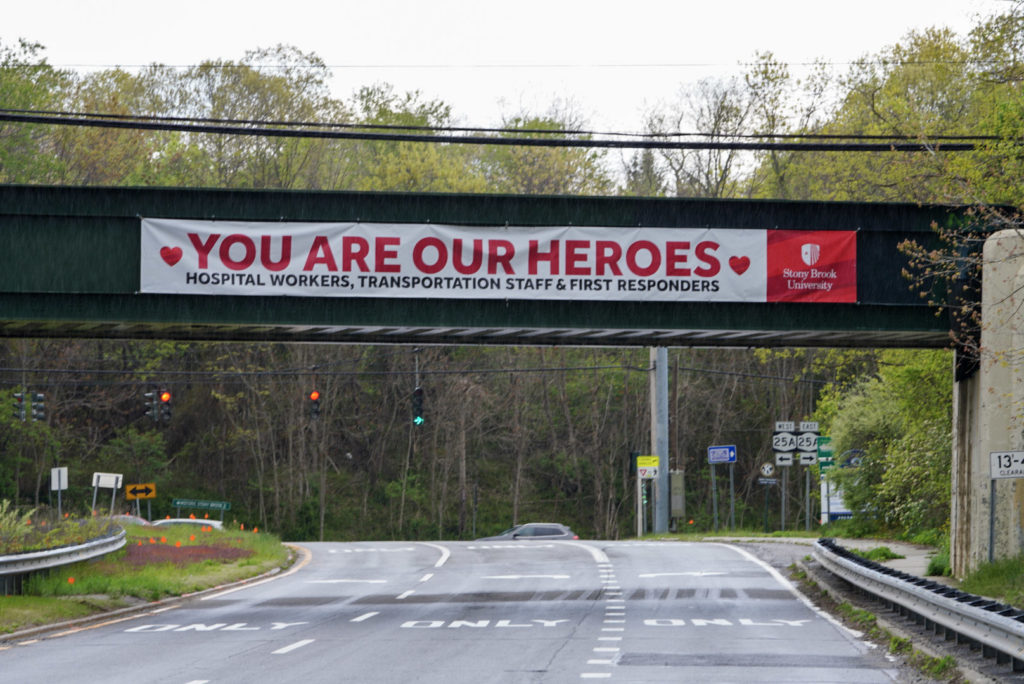
Pictured: A banner draped across a LIRR train trestle in Stony Brook thanks essential workers at nearby Stony Brook University Hospital during the coronavirus pandemic. (Photo Credit: MTA/LIRR)
The Capital Region, which includes Albany and Saratoga counties, remains at the cusp of reopening with six of the seven criteria met, with limits in testing capacity remaining as the only hurdle left for the area to overcome. For areas downstate, suburban Long Island and the Mid-Hudson meet five of the seven, while New York City has hit four of the benchmarks. “This is all based on the metrics and the numbers,” Cuomo said. “Obviously, we have different rates of infection in areas across New York State, hence the variance.”
Talking about the responsibility of localities to ensure safely reopening, Cuomo was firm. “If you allow this virus to get ahead of us, we will have a problem,” he said, urging immediate action if case numbers or hospitalizations begin to spike. The governor also said that after a conversation with President Trump, that the federal government will be expediting the allocation of $3.9 billion in funding approved by Congress in March for the Metropolitan Transportation Agency.
The state is currently investigating 110 cases of the emerging pediatric multisystem inflammatory syndrome that health experts say is related to coronavirus infection. So far, New York is working with 16 other states who are investigating their own local cases of the illness. “I expect this is only going to grow,” the governor added.
“The facts on this virus have changed, and I believe they will continue to change,” Cuomo noted. “So take this all with a grain of salt, and my basic point is to not underestimate this virus. It has beaten us at every turn. It has surprised us at every turn.”
In nearby Connecticut, Governor Ned Lamont is drafting plans to allow in-person restaurant dining by next month, while New Jersey aims to allow nonessential retail businesses to reopen for curbside pickup and nonessential construction on Monday. The state’s beaches will be open for Memorial Day weekend with firm social distancing measures in place.
Nationwide, another 2.9 million workers filed first time unemployment claims, bringing the total number of jobless workers to 36.5 million. The historic unemployment figures come after just two months of coronavirus impacts, and markets remained lukewarm during trading on Thursday.
“The numbers are very high, but they’re stepping down every week, and I see no reason why that decline in filings wouldn’t continue,” Keith Hall, chief economist for the Council of Economic Advisers under former President George W. Bush, told the Wall Street Journal on Thursday. “Employers are likely poised to bring people back, but right now we’re in a holding pattern.”
Dr. Rick Bright, a former top vaccine official removed from his post last month, testified to Congress on Thursday, telling a health subcommittee of the House Committee on Energy and Commerce that proper planning for the next wave of infection is necessary. “There will be likely a resurgence of COVID-19 this fall. It will be greatly compounded by the challenges of seasonal influenza. Without better planning, 2020 could be the darkest winter in modern history,” Dr. Bright said in his opening remarks. Later, Bright said that time is running out for the nation to properly address the pandemic.”The window is closing to address this pandemic because we still do not have a standard, centralized, coordinated plan to take our nation through this response.”
Researchers are working to better understand the dynamics of long-term immunity to the coronavirus. Since the coronavirus mutates slowly, there is hope that a vaccine or natural immunity is likely to offer longer lasting protection. Researchers are also finding that if someone gets infected with the virus for a second time, any illness contracted might be milder than the first, as has been the case with numerous examples in South Korea.
In an op-ed published in the New York Times on Thursday, Dr. Marty Makary, a professor of health policy at the Johns Hopkins School of Public Health, argued that steps must be taken to adapt society to a post-virus world as we balance safety and economic productivity.
“The full lockdown made sense weeks ago. But the situation is changing, and more data on the virus are now available to inform our next steps. The choice before us isn’t to fully lock down or to totally reopen. Many argue as though those are the only options,” Makary wrote. “So what does a new, safer status quo look like? It looks different in different parts of the country. Not all reopenings are created equal. Areas with continuing outbreaks or rising cases should postpone nonessential activity, and those with a declining case trend should engage in some basic practices.”
UPDATE AS OF 12:45 PM, WEDNESDAY, MAY 13th, 2020:
From Watertown on Wednesday, New York State Governor Andrew Cuomo highlighted the continuing drop in hospitalizations and COVID cases per day. While the rate of daily infection ticked up slightly, it remains significantly lower than the peak levels from late-March. Despite the measured progress, the virus claimed another 166 victims within the last 24 hours, bringing the statewide total number of deaths to 21,006. “These are not numbers, these are families,” Cuomo said of the deaths. “We have hopefully come from the worst.”
Cuomo said that essential workers have tested lower for coronavirus antibodies than the general population. “That means PPE works,” Cuomo said. “All the front line workers tested below the general population.” In addition, the governor announced that elective surgeries can now restart in 12 additional counties including Albany, Orange, and Schenectady. Statewide, all counties, save for Erie and the New York metro area, can now have elective surgeries once again.
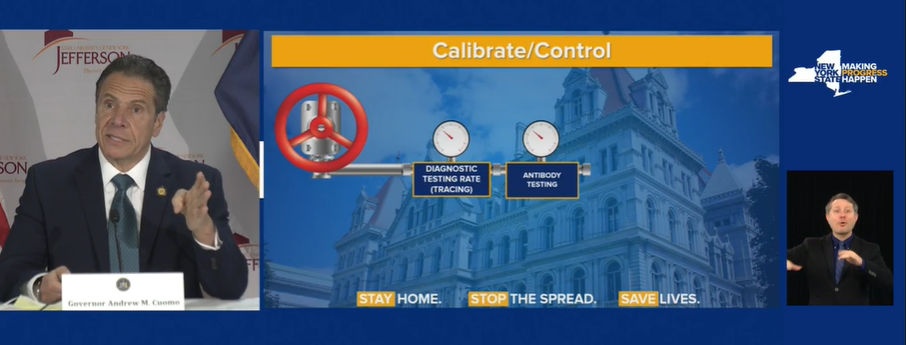
Pictured: NYS Governor Andrew Cuomo describes New York’s “valve-like” reopening process during his daily briefing on Wednesday. For the first time, the state provided an ASL interpreter after a federal judge ordered the governor to add sign-language interpretation to his daily televised coronavirus briefings. (Photo Credit – NYS Governor’s Office)
New York’s department of health is now investigating 102 cases of the emerging pediatric multisystem inflammatory syndrome that health experts say is related to coronavirus infection. Of the total number of cases known so far, 60% have tested positive for COVID-19, and 40% tested positive for coronavirus antibodies, Cuomo said. In addition, 71% of cases required intensive care, 19% resulted in intubation, and 41% required hospitalization. “It’s not just in New York,” Cuomo noted about the Kawasaki-like ailment. “Fourteen other states are now investigating cases in their state,” he said, adding that five European countries have reported cases as well.
“If your child has been exposed to someone who had COVID, that is a special alert in this situation,” the governor said, urging parents to remain vigilant about watching for emerging symptoms which include fever, rash, reddish eyes, swollen lymph nodes and sharp abdominal pain.
Long Island’s suburbs are facing a shaky economic recovery as revenues plunged throughout April, latest figures released by New York State’s comptroller’s office show. Sales tax revenues dropped over 26% when compared to this time last year, creating a total revenue shortfall of $53.6 million, Of that figure, $29.8 million of those losses are from Suffolk County, and $23.8 million from Nassau. Across New York State, collected taxes from sales dropped over 24%.
Consumers are getting more for their dollar at the pump as gasoline prices across 25 counties including the metropolitan region fell 32% when compared to this time last year. It’s a different story at the supermarket as the pandemic continues to impact the supply and distribution of groceries, causing prices in stores to rise 4.1% year-to-year. Overall, the price index for food at home across the country posted it’s largest monthly increase since February 1974, with items such as chicken, cookies, and paper products seeing the largest pricing gains.
Nationally, House Democrats released a new $3 trillion coronavirus relief bill, which includes $1 trillion in aid for states and localities. If the measure is passed by Congress, the bill would roughly double what has appropriated to fight the impacts of the pandemic so far. Reception to the proposal from Senate republicans has been cold, and further negotiations could start in the coming weeks.
The battle for local funding further heated up on Wednesday as Maryland Governor Larry Hogan, a Republican, and Cuomo, a Democrat, issued a joint bi-partisan statement from the National Governors Association that pressed for at least $500 billion in federal aid to states to make up for revenues lost during the pandemic.
“Each day that Congress fails to act, states are being forced to make cuts that will devastate the essential services the American people rely on and destroy the economic recovery before it even gets off the ground,” Hogan and Cuomo wrote. “With widespread bipartisan agreement on the need for this assistance, we cannot afford a partisan process that turns this urgent relief into another political football. This is not a red state or blue state crisis. This is a red white and blue pandemic. The coronavirus is apolitical. It does not attack Democrats or Republicans. It attacks Americans,” they said.
“All governors will say they need assistance from the federal government,” Cuomo later elaborated during his briefing, saying New York’s budget will be determined by the level of federal support. “If we don’t get Washington to act intelligently — which wouldn’t shock any of us — I can’t tell you what actions we would need to fill that budget hole because we’ve never been here before.”
According to the latest data from Johns Hopkins University, there have been more than 1.36 million coronavirus cases across the U.S., and 82,000 deaths. Official numbers likely undercount the true death toll of the pandemic, researchers say.
Those hoping to hear cries of “play ball” may have to wait a bit longer as Major League Baseball begins negotiations with it’s players’ union on how to begin their 2020 season. The league is aiming for a spectator-free 82-game season that would begin in July, but logistical hurdles that must be cleared include securing coronavirus testing capacity, ensuring safe travel for teams and staffers, and compromising on a salary structure for players. Opening day was originally scheduled for March 26th.
UPDATE AS OF 3:15 PM, TUESDAY, MAY 12th, 2020:
Dr. Anthony S. Fauci, director of the National Institute of Allergy and Infectious Diseases, testified on Tuesday to the U.S. Senate’s Health, Education, Labor and Pensions committee. Fauci appeared alongside Dr. Robert Redfield, the director of the Centers for Disease Control and Prevention, Dr. Stephen Hahn, the commissioner of the Food and Drug Administration, and Admiral Brett P. Giroir, the assistant secretary for health.
In his opening remarks, Fauci said that eight coronavirus vaccinations are currently in clinical development, and that the National Institute of Health has been collaborating with numerous pharmaceutical companies throughout the various stages of development. The agency hopes to know how successful a vaccine candidate may be by late fall. With testing capacity, an element experts say is key to safely reopening, Admiral Giroir added that the hope is to be able to perform 40-50 million coronavirus tests per month by September.
Until such measures are put in place, the panel of experts who testified said that reopening in a cavalier fashion can cause a new spike in infection. “My concern is that some areas, cities, states, what have you, jump over those various checkpoints and prematurely open up without having the capability of being able to respond effectively and efficiently,” Fauci said. “If states prematurely open up, my concern is that we start to see little spikes that turn into outbreaks.”
“If we do not respond in an adequate way when the fall comes, given that it is without a doubt that there will be infections that will be in the community, then we run the risk of having a resurgence,” Fauci later added. “I would hope that by that time, in the fall, that we would have more than enough to respond adequately, but if we don’t, there will be problems.”
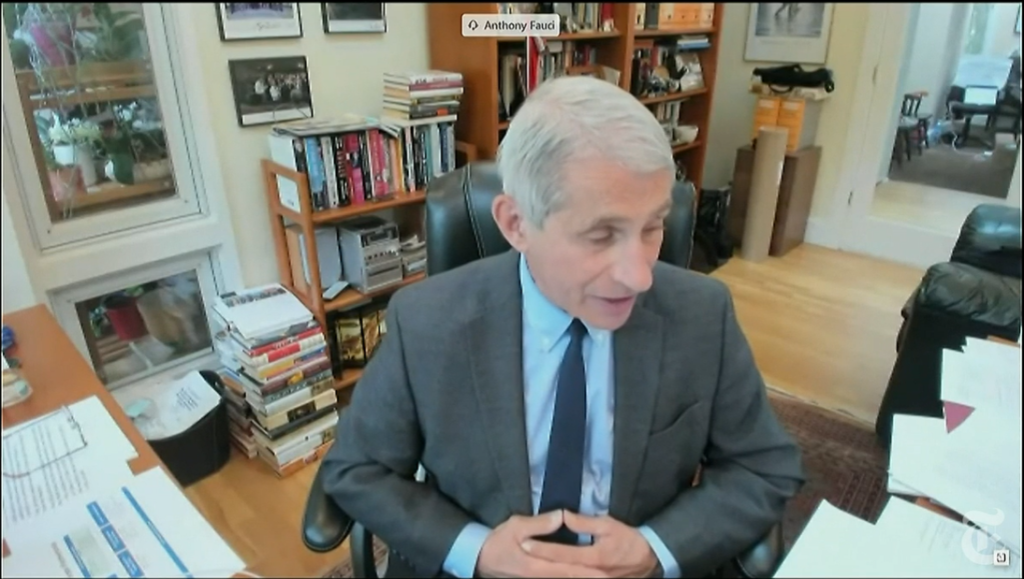
Pictured: Dr. Anthony S. Fauci delivers his opening remarks remotely to the U.S. Senate’s HELP Committee.
“We are not out of the woods yet,” said Dr. Robert Redfield, the director of the Centers for Disease Control and Prevention, “but we are more prepared.”
Later in the afternoon in New York, Governor Andrew Cuomo delivered his daily press briefing from SUNY Binghamton’s School of Pharmacy. During the briefing, the governor said that hospitalizations rates continue to trend downward, even as an additional 195 people have died in the last 24 hours. In total, 20,840 New Yorkers have died since the pandemic first began.
“We’re just about where we were before we saw the onslaught of the virus,” Cuomo said of the figures, adding that “this is no time to get cocky or get arrogant. This virus has deceived us every step of the way.”
“We thought initially that it didn’t effect children,” Cuomo noted, saying that the department of health is now investigating 100 cases of the newly emerging pediatric multisystem inflammatory syndrome that health experts say is related to COVID-19. Based on an analysis of the 100 cases so far, children between the ages of 5 to 14 seem to be the most impacted.
In regards to reopening, Cuomo stressed the efforts he’s made in recent weeks at ensuring transparent, straight-forward communication about the pandemic. To this end, the state is now making available an online dashboard that highlights key infection benchmarks in their communities. “I want people to know what’s going on in their community day after day,” he said. “Everyone can literally see what is happening.”
Currently, New York City has met four out of the seven reopening criteria outlined by the state, while Long Island has met five out of seven. Both regions remain unchanged from yesterday. The capital region, which includes Albany, now meets six out of seven, newly meeting an additional reopening benchmark within the last 24 hours.
You can view the reopening status of each New York regions here.
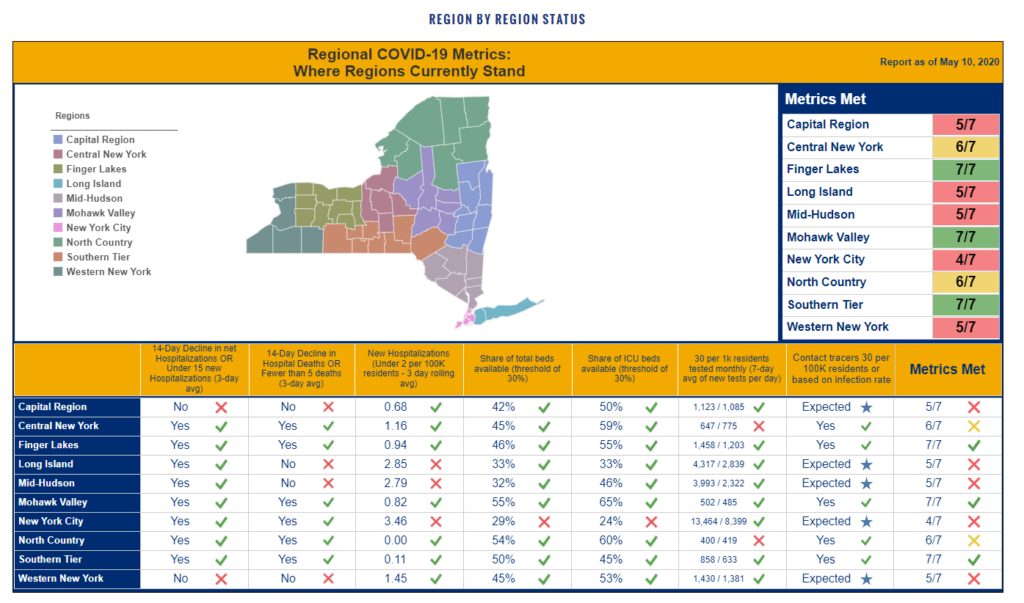
Pictured: A snapshot of New York State’s regional monitoring dashboard on Tuesday. To begin a phased reopening, regions must hit 7 out of 7 key benchmarks outlined by the state. (Photo Credit – NYS Governor’s Office)
Cuomo also called for the federal government to allocate $61 billion in financial support to directly help New York State, who is facing over a $13 billion shortfall. In recent weeks, governors from states hardest-hit by the pandemic have been pressing Congress for any new coronavirus relief effort to include direct unfettered fiscal aid to localities. The National Governors Association, of which Cuomo is a vice-chairman, will be issuing a bi-partisan statement on the issue later Tuesday. “We want funding that allows us to do our job,” he explained.
In New York City, Mayor Bill de Blasio said on Monday that the ban on large gatherings and the widespread closing of nonessential businesses are unlikely to end until next month. “June is when we’re potentially going to be able to make some real changes if we can continue our progress,” the mayor said.
On Tuesday, Broadway announced they are not holding any summer shows, and theaters are now offering refunds and exchanges for tickets purchased for performances through September 6th. “As we’ve been put in phase four of the governor’s plan, we felt that September 6 was a reasonable distance of time for refunds and exchanges, while we fully understand that we may not be back at that time,” Charlotte St. Martin, the Broadway League’s president, said in a statement.
Economically, figures released Tuesday show that public pension plans have experienced their worst quarter on record. Policymakers and corporate executives told the Wall Street Journal late Monday that instead of a “V”-shaped recovery, which shows a steep drop in economic activity followed by a similarly steep period of growth, they are now expecting a “swoosh”-shaped recovery, named after Nike’s logo, which predicts a large drop followed by a painfully slow recovery that could last through late next year.
For the second month in a row, the price of goods and services has dropped nationwide as the consumer-price index fell by 0.8% last month, according to the latest figures from the Labor Department. So far, consumer prices have experienced their biggest drop since 2008, as the pandemic’s stay-at-home orders have created cheap oil, cheaper cars, and other goods and services.
UPDATE AS OF 1:00 PM, MONDAY, MAY 11th, 2020:
From New York’s western tier, New York State Governor Andrew Cuomo said during a briefing on Monday that this week starts “a new chapter” as localities and regions prepare for a phased reopening of the economy on May 15th.
“It’s an exciting new phase and we’re all anxious to get back to work,” the governor said. The move towards reopening comes as the number of total coronavirus hospitalizations continue their decline. The virus is still killing though, as an additional 368 people have died from the coronavirus since Saturday, bringing the statewide total to 20,645. Sunday’s loss of 161 lives marks the lowest daily number of deaths since March 26th, a figure Cuomo called “still too high, but better than it has been.”
Compared to what models were predicting a month ago, Cuomo says that the state was able to avoid the worst-case scenarios that were being predicted. “We’re right about where we were March 19th, before we went into the abyss,” he said of the declining key metrics being measured by the state, as the daily infection rate dipped below 500 for the first time in weeks. “We averted tragedy,” he added, stressing the role New Yorkers played by willingly following mitigative measures like wearing a mask in public and social distancing.
Reopening is now the next chapter, Cuomo says. “This is the next big step in this historic journey,” Cuomo said of NY Forward, the state’s comprehensive reopening strategy, which can be accessed here.
Based on the state’s detailed reopening criteria, areas that can open on Friday include the Finger Lakes, Mohawk Valley and Southern Tier. So far, New York City meets only four out of the seven benchmarks, while Long Island meets five of the seven. “This reopening phase is locally driven, regionally driven, and regionally designed,” Cuomo said of the effort. “So the businesses that can open are the businesses that are approved by that region and approved with these conditions.” Cuomo also noted that certain low-risk businesses, including landscaping, tennis, and drive-in theaters, can reopen statewide on May 15th.
The Foggiest Idea first reported New York’s reopening conditions on May 5th. They include:
- A 14-day decline in hospitalizations, or fewer than 15 a day.
- A 14-day decline in virus-related hospital deaths, or fewer than five a day.
- A steady rate of new hospitalizations below two per 100,000 residents a day.
- A hospital-bed vacancy rate of at least 30 percent.
- An availability rate for intensive care unit beds of at least 30 percent.
- At least 30 virus tests per 1,000 residents conducted a month.
- At least 30 working contact tracers per 100,000 residents.
Regardless of areas hitting the metrics in the coming days, Cuomo says that local governments must remain coordinated in their reopening efforts. “The local governments have to be in communication with each other,” he said. “This virus doesn’t respect county borders. Those governments have to be in contact with each other.”
To better understand the virus’ saturation in hard-hit areas downstate, coronavirus testing will soon be offered at 24 churches within minority and low-income communities. In addition, the state is saying that hospitals can no longer discharge patients into nursing homes unless they test negative for COVID-19. The moves come as the virus ravages these enclaves and nursing facilities statewide.
The mysterious syndrome that is seemingly related to the coronavirus has so far killed three young children and has sickened 73 others across New York. Hospitals are currently investigating 93 additional cases of this illness, now known as pediatric multisystem inflammatory syndrome. Symptoms parents should watch for include fever, rash, reddish eyes, swollen lymph nodes and sharp abdominal pain.
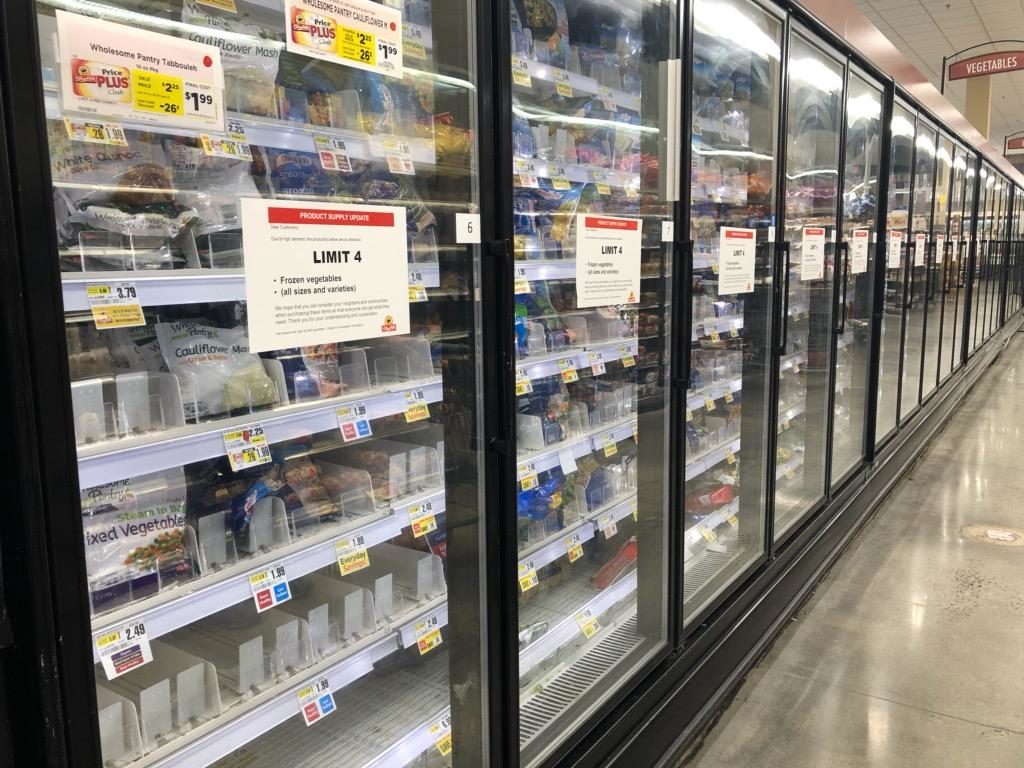
Pictured: The frozen food aisle at a ShopRite store on Long Island. Due to high demand from shoppers and virus-related food supply shortages, grocers across the region have placed buying limits on items such as meat, frozen vegetables, and toilet paper. (Photo Credit – Arielle Murdocco/The Foggiest Idea)
The number of Long Islanders applying for the Supplemental Nutrition Assistance Program (SNAP) has nearly doubled in recent days, as the economic malaise worsens due to the pandemic. The uptick in first-time applications comes as New York State recently expanded a federal food assistance program that aims to help children who typically rely on school lunches for their meals.
Across the country, doctors are seeing record numbers of patients with critically-low blood oxygen levels who are otherwise presenting as healthy – yet another anomaly of the coronavirus pandemic.
While these individuals would have been previously placed on a ventilator before the pandemic, doctors tell the Wall Street Journal that they are now pursuing less-invasive treatments with positive results. Such measures taken include prone positioning, which rolls patients onto their sides or on their bellies with supplemental oxygen, as well as use of BiPAP and CPAP machines.
UPDATE AS OF 2:15 PM, FRIDAY, MAY 8th, 2020:
The April unemployment rate has risen to a record 14.7%, the highest level seen since the Great Depression, as pandemic continues to snuff out economic productivity across the U.S. In addition, total payrolls dropped by an unprecedented 20.5 million jobs. Both figures effectively highlight how the coronavirus crisis has erased any economic gains made since the 2008 Great Recession.
In New York, officials are saying that they have processed three times more unemployment claims in the past six weeks than the state put out all of last year. On Long Island, the numbers reflect that nearly one in five workers in Nassau and Suffolk counties have filed for job loss benefits.
From Marist College in Poughkeepsie on Friday afternoon, New York State Governor Andrew Cuomo said that hospitalizations from the virus continue to tick downward, continuing the overall trend of recent weeks. In addition, new COVID-related hospitalizations remain just about flat. “We would’ve hoped to see a steady sharp decline in those numbers,” the governor said. “It’s more flattening out… will it flatten out or continue to drop?” he asked.
The death rate statewide has remained persistently steady, with 216 additional people dying within the last 24 hours. In total, there have been 20,277 confirmed coronavirus deaths statewide, a tally that likely under counts the actual number of virus-related fatalities.
“Now, I feel for the first time that we’re actually ahead of it,” the governor later said, noting that key numbers throughout New York are coming down as other areas of the country see a rise in both coronavirus cases and hospitalizations. “We have the beast on the run, no doubt about that, we haven’t killed the beast, but we’re ahead of it.”
To Cuomo, the virus’ rapid spread isn’t surprising, given how long that it’s movement was unrestricted. “When you look back, November to April is a long period of time,” Cuomo said, noting that the initial virus from China mutated in Europe and spread throughout the U.S. after likely first arriving from an international flight to John F. Kennedy International Airport. “From December to March, three million Europeans came through our airport,” he noted, saying that these arrivals helps fueled the severity of the crisis. “Learning what happened is important so we don’t make the same mistake twice.”
“One fact we do know about COVID, is that we know there is still a lot that we don’t know about this virus,” Cuomo stressed. “We were led to believe the good news about the virus is that it doesn’t infect children,” he said. Cuomo mentioned how it’s now being understood this isn’t the case as a new mysterious ailment related to coronavirus infection is beginning to spread through young people. “This is painful news, and will open up an entirely new chapter,” Cuomo said as 73 confirmed reports of the new illness have been found in New York.
Statewide, children who have been suffering from this mysterious ailment have responded well to intravenous immunoglobulin treatments, which is typically used for Kawasaki Disease. Dr. Leonard Krilov, an expert on Kawasaki, told Newsday that the coronavirus poses a relatively low-risk for children despite the emergence of this new syndrome. “I think it’s important to watch out for it because it can be serious and needs to be monitored and treated,” he told the publication. “But I think it’s still a rare anomaly.” On Friday, Cuomo said that a five-year old boy in New York City has died, and others are under investigation.
On Long Island, Northwell Health facilities have experienced their 17th straight day of decline in their total number of COVID-19 patients, which is down 62% since it’s peak from April. Across Nassau County, officials said that they have just seen their 21st consecutive daily drop in hospitalizations, while further east in Suffolk, coronavirus deaths continue to mount throughout nursing and assisted living facilities.
Nationally, More than 40% of the additional $310 billion that was allocated by the federal government for small business aid still remains available, according to figures released late Thursday by the Small Business Administration. The funds remain available as demand for federal support cools even though many small businesses are continuing to experience economic hardship.
UPDATE AS OF 12:30 PM, THURSDAY, MAY 7th, 2020:
An additional 3.2 million workers in the U.S. have filed unemployment claims in the last week, bringing the total number of jobless in the country to 33.5 million. The latest jobless figures, while still blockbuster in demonstrating the continuing economic damage being wrought by the virus, are down from their peak weeks earlier. Economists estimate the nation’s unemployment rate, with the official figures to be released Friday morning, to be anywhere from 15 to 20%.
From New York Medical College in Westchester County, New York State Governor Andrew Cuomo said on Thursday that during such times of “high anxiety” it’s important to stay true to the facts, quoting both John Adams and Abraham Lincoln on the subject.
Overall, hospitalizations levels have experienced what the governor called a “fairly significant drop” while the number of new daily COVID hospitalizations have seen a more gentle decline. An additional 231 people confirmed to have the coronavirus have died statewide, bringing New York’s total to 20,061. In recent days, this figure has come under increased scrutiny from policymakers as reporting methods are evolving.
Citing the courage of frontline workers who willingly traveled to New York during the peak of the crisis, Cuomo said that “one of the few positives” is that healthcare workers have an equal to lower infection rate when compared to infection rates within the general population. “Our healthcare workers must be protected,” the governor said, discussing at length the need for personal protective equipment. “It shows everybody how important the gloves, mask and the sanitizer are.”
For renters, Cuomo announced that a state-wide moratorium on eviction has been extended another 60-days until August 20th, an action that covers both residential and commercial tenants. Essentially, no one within New York can be evicted for non-payment of rent.
In addition, through the Nourish NY initiative, a new program that connects surplus farm products from upstate to food banks downstate, Cuomo said the volume of food has been “tremendous” with over 2 million gallons of milk alone being donated since the program launched.
Regarding the balance between safety and the economy, Cuomo was direct. “We have to do both,” he said. “There is nothing that we are going to authorize or allow in this state that I, myself, will not be a part of… If I say something is safe for New Yorkers, then I will participate in it,” Cuomo added, noting this is the standard going forward.
Across New York State, a new mystery illness appearing in children that is related to the coronavirus continues to vex health experts. Officials say that 64 children have been hospitalized so far, most of whom had either tested positive for the coronavirus or for antibodies to it. Symptoms of the ailment include fever, rash, reddish eyes, swollen lymph nodes and sharp abdominal pain, but do not usually include the two key indicators of COVID-19, cough and shortness of breath. So far, one death has been reported – a 14-year old boy in England.
At a CityMD location in Commack, a doctor conducting antibody testing for the coronavirus told The Foggiest Idea that patient volumes have quadrupled as demand for newly available testing climbs. Walk-in health clinics across the Nassau/Suffolk region are now offering such tests to anyone who wants one, even if they are not essential workers.

Pictured: Messaging from a new Long Island Rail Road marketing campaign to remind riders to cover their face in public. LIRR President Phil Eng has said that riders have been complaining that some on board trains aren’t wearing face coverings. (Photo Credit – MTA)
On Wednesday, New York City Mayor Bill de Blasio said that the city is facing a $7.4 billion shortfall, and threatened to furlough or layoff municipal workers unless federal aid can be secured.
New research is showing that New York City became the primary source of new coronavirus infections throughout the U.S., as thousands of infected people freely traveled from the city and effectively seeded outbreaks across the country. “We now have enough data to feel pretty confident that New York was the primary gateway for the rest of the country,” Nathan Grubaugh, an epidemiologist at the Yale School of Public Health, told the New York Times. Researchers say that earlier shutdown actions would have more easily prevented the virus’ spread nationwide.
Even as states prepare to reopen, key metrics show no sign of the virus subsiding in the U.S. The 72,000 American deaths from the virus amount to nearly 30% of the global total. During the 24-hour period between Tuesday to Wednesday, 2,100 Americans died from the virus, marking the nation’s deadliest day in weeks. Within more than half of the states that are choosing to ease lockdown restrictions, case counts and/or positive test results are still rising, health experts told the New York Times.
On Thursday, the Associated Press reported that the Trump administration is shelving a 17-page report by the Centers for Disease Control that outlined step-by-step advice to local authorities on how and when to reopen restaurants and other public places. According to sources from within the CDC, the document was supposed to be published last Friday, but agency scientists were told the guidance “would never see the light of day.”
The pandemic continues to disrupt meat production nationwide, as nearly 20 major meatpacking facilities have temporarily closed during the past several weeks due to COVID-19 outbreaks among employees. The closures have collectively cut domestic beef and pork production last week by about 35%, while chicken production has dropped 7%, according to figures from the U.S. Department of Agriculture and an agricultural lender.
Closures across the meat industry have persisted despite an executive order from President Trump that invokes the Defense Production Act to keep plants open. As such, grocers have begun limiting purchases and say they are preparing for intermittent shortages throughout May or longer. TFI first reported on the risks to the meat supply posed by the pandemic in mid-April.
Meanwhile, Clorox wipes remain difficult for shoppers to find, even as in-demand items such as hand sanitizer and toilet paper became more readily available in recent days. Clorox has increased production of the wipes by 40%, but sales have remained at five times their normal level, the company said. Sales of disinfectant wipes were up 146% throughout March.
“We’re shipping canisters of wipes every day to our customers, and within 30-45 minutes they’re gone from shelves,” Kevin Jacobsen, Clorox’s chief finance officer, said in an interview with the Wall Street Journal. “Demand has outstripped what anybody could have imagined.”
UPDATE AS OF 12:45 PM, WEDNESDAY, MAY 6th, 2020:
Throughout the reaches of upstate New York, the rate of hospitalizations from COVID-19 continues to decline, while downstate areas continue to battle the coronavirus on all fronts. From his daily coronavirus briefing held on Wednesday from New Hyde Park, New York State Governor Andrew Cuomo laid out the latest on the pandemic.
“This is one of the most challenging times this state has faced in modern history,” the governor said before announcing that the number of hospitalizations continue to decline, calling the rate of day-to-day change “painfully slow.” There were 600 new cases of COVID-19 statewide yesterday, and 232 additional confirmed coronavirus deaths. As of writing, there have been 19,830 confirmed deaths statewide.
Cuomo urges caution with these figures, especially since the timeline of the virus’ transmission from Europe isn’t yet fully understood. “I think this is all going to change over time, and I think it’s going to be worse when the final numbers are tallied,” Cuomo said, adding that researchers are now looking to see if the virus first came to the area from Europe late last year.
“The economy must function,” Cuomo acknowledged. “It’s not a question of do we reopen, but how,” he said, saying that New York is basing such decisions on facts and data, not emotion or politics. “You take New York out of the national numbers, the numbers for the rest of the nation are going up,” Cuomo says, a fact that gives credence to the state’s approach.
Based on the latest figures that break down those being admitted to the hospital during the last three days, Cuomo said that the rate of new hospitalizations for COVID-19 remains highest throughout the boroughs and on Long Island. The bulk of these patients are at or above 51 years or older, were at home, and the majority were unemployed, facts that Cuomo said were “shocking to us.”
In addition, Cuomo spoke at length about institutionalizing the “lessons learned” from the pandemic in the form of various blue-ribbon advisory panels. For education, the Bill and Melinda Gates Foundation will be working on a “reimagining” effort for education, while Eric Schmidt, former CEO of Google, video-conferenced in to say his work with the state will focus on telehealth, remote learning ,and expanding broadband access.
For the first time in the New York City subway system’s 115-year history, there was a regularly scheduled halt in service throughout New York City last night as trains, stations, and transit equipment were taken out of service for disinfection. The scheduled stops in subway service will continue until the threat of pandemic subsides. Overall, New York City residents have made up around 70% of coronavirus fatalities state-wide.
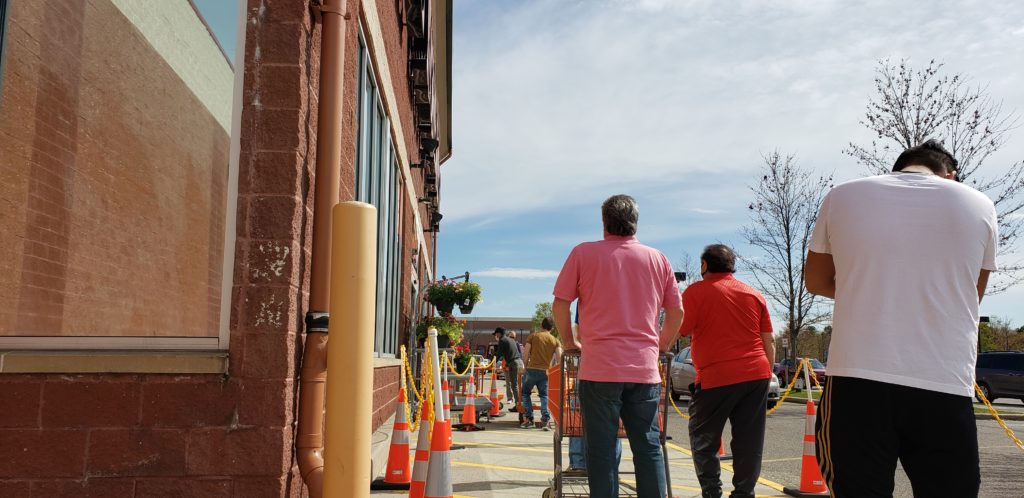
Pictured: Shoppers line up outside of a Home Depot store in Commack as the retailers look to reduce the volume of people within their stores. (Photo Credit – Richard Murdocco/The Foggiest Idea)
On Long Island, Northwell Health, New York’s largest hospital system, has seen a 60 percent drop in COVID-19 patients across their 19 facilities when compared to those hospitalized during the peak of the pandemic. The number of patients at Northwell has been falling consistently since April 20th. Within Suffolk County, the number of COVID-19 hospitalizations has remained stubbornly high for several days. “That’s not the direction we want to be moving in,” Suffolk County Executive Steve Bellone said of the consistent increases.
Officials within both Nassau and Suffolk Counties are growing concerned about the increasingly dire financial situations within their municipalities. Nassau’s comptroller is projecting a $136.3 million decline in county revenues due to the pandemic, while Suffolk is bracing themselves for a $100 million loss. While borrowing from the Federal Reserve Board’s $500 billion Municipality Liquidity Facility is a newly minted option for either county to take thanks to changes in qualifying rules for local governments, securing such funding is far from guaranteed.
Meanwhile, Long Island’s townships are banding together in order to tackle the complex business of reopening. The Suffolk County Supervisors Association is now actively engaging in a joint planning effort with the three Nassau County town supervisors in an effort to explore areas of possible coordination across Long Island’s thirteen townships. The group is formally known as the Nassau/Suffolk Joint Summer Operations Task Force, and will primarily focus on standardizing reopening policies for beach, parks, and playground facilities region-wide.
Nationally, President Trump on Wednesday morning is claiming that the White House coronavirus task force will remain in place with a new focus on reopening the country and developing a vaccine. The comments, made on Twitter, came just one day after administration officials said they were considering disbanding the group.
As the administration presses for reopening, Trump admitted that taking such action may lead to more deaths. “I’m not saying anything is perfect,” Trump said to reporters during a visit to a mask factory in Arizona on Tuesday. “And, yes, will some people be affected? Yes. Will some people be affected badly? Yes. But we have to get our country open, and we have to get it open soon.”
UPDATE AS OF 12:45 PM, TUESDAY, MAY 5th, 2020:
Within the last 24 hours, an additional 230 people have died across New York State, bringing the total number of confirmed coronavirus deaths to 19,598. Adding to the number of dead, New York State is now reporting more than 1,700 previously undisclosed assumed COVID-19 deaths at nursing homes and adult care facilities, bringing the statewide total to a staggering 21,298, a number that should be taken with caveats due to reporting inconsistencies.
From an afternoon briefing in New York City, New York Governor Andrew Cuomo said that the total number of hospitalizations from COVID-19 continues to drop statewide. “It’s basically flat,” he said, noting that weekend reporting is typically lower. “There is no doubt that we’re coming down the mountain,” Cuomo said, adding that social distancing has worked, but these numbers can climb back up. “I’d take all of these numbers with a grain of salt,” Cuomo later added.
As states across the country race to reopen, those located within the northeast are taking a more cautious approach. For New York in particular, the reopening strategy will be driven by the state’s ten distinct regions meeting seven key requirements before lockdown orders first put in place on March 22nd could be eased. On Tuesday, Cuomo said the state’s approach was crafted after studying reopening plans across the country.
According to the governor’s office, the criteria that must be met by a region before reopening are:
- A 14-day decline in hospitalizations, or fewer than 15 a day.
- A 14-day decline in virus-related hospital deaths, or fewer than five a day.
- A steady rate of new hospitalizations below two per 100,000 residents a day.
- A hospital-bed vacancy rate of at least 30 percent.
- An availability rate for intensive care unit beds of at least 30 percent.
- At least 30 virus tests per 1,000 residents conducted a month.
- At least 30 working contact tracers per 100,000 residents.
Source: The New York Times/NYS Governor’s Office
“The faster we reopen, the lower the economic cost. But the higher the human cost, because the more lives lost,” Cuomo said. “That, my friends, is the decision we are really making. What is the balance, what is the trade-off,” he reflected, noting that projection models have changed for the worse in recent days due to state reopening plans. “Let’s not camouflage the actual terms of the discussion we’re having. How much is a human life worth… That’s the real discussion no one is admitting openly and freely.”
Concerning the supposed trade off of economic gain and human costs, Cuomo was blunt. “To me, a human life is priceless. Period. Our reopening plan doesn’t have a trade-off.”
Opining about the federal government’s recent shirking of responsibility and the concept of state aid as a partisan issue, Cuomo noted that New York given more than $116 billion to the federal government than it’s received since 2015. “What government does today will literally determine how people live and die,” he said, noting that any state cannot properly function without federal support. “If you starve the states, how do you expect the states to fund this entire reopening plan?”
“You go down this path of division, you will defeat all of us, because we’re all in the same boat. There is no separating us. It’s still the United States of America,” the governor exclaimed. “You have a national crisis, killing thousands of people, you can’t put your politics aside, even now, even today?” Cuomo fumed. “If there is ever a time to come together, it’s a moment of crisis.”
Speaking at length about the re-imagining of education during the pandemic, Cuomo also said that New York will be partnering with the Bill and Melinda Gates Foundation to revamp educational efforts in the state, calling e-learning part of a “new normal.”
The New York City Department of Health issued an alert on Monday regarding a new multi-system inflammatory syndrome found within children that is potentially associated with COVID-19. The new infliction shares similar features with Kawasaki disease and/or toxic shock syndrome, and of the 15 or so in critical care units within the city, all had measured fever, more than half reported rash, abdominal pain, vomiting, and/or diarrhea. Respiratory symptoms were reported in less than half, and the department says that none of the New York City patients have died. There are 17 cases of the mysterious syndrome in Nassau County as well.
Starting tonight, all subway stations across the city will close between 1 a.m. and 5 a.m. for the duration of the pandemic as the Metropolitan Transportation Agency works on a historic effort to disinfect all trains. Riders who need overnight service will instead be provided busing options, or in some instances, a personal taxi. One rider, a morning producer for WCBS news radio 880, reported that her estimated travel time from Uptown to Downtown Manhattan is estimated to double during the overnight hours.
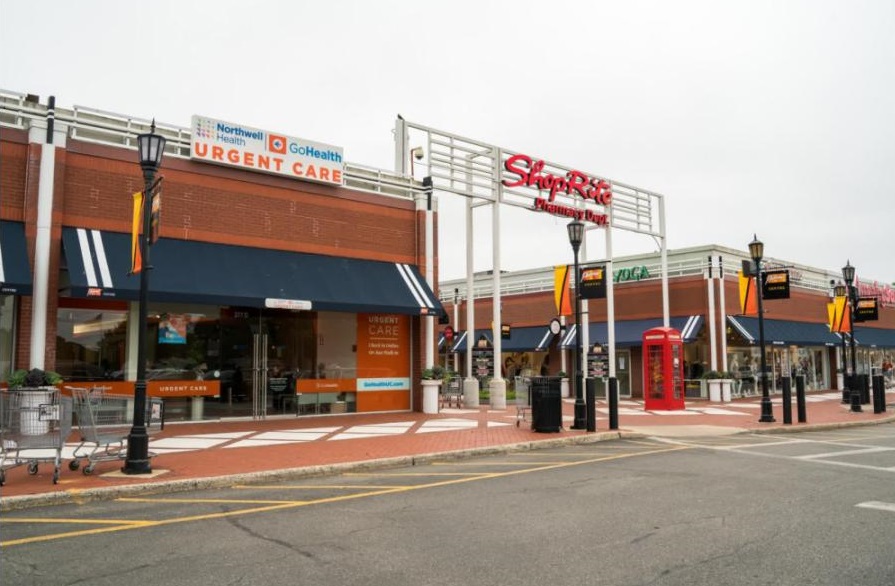
Pictured: A Northwell Health Urgent Care facility in Plainview. Such facilities are now offering coronavirus antibody testing at their 52 locations island-wide. (Photo Credit – Northwell Health)
On Long Island, elected officials are hoping to see a reopening hit the suburbs earlier than the city. “I believe our timeline is going to be different from New York City’s,” Nassau County Executive Laura Curran said. In Suffolk County, the number of hospitalizations for COVID-19 had increased slightly, a first since April 20. The uptick casts new doubts about whether nor not the county can hit the reopening marker of 14 days of hospitalization declines.
Across the Nassau/Suffolk region, laboratories, urgent care centers, and other medical facilities are offering coronavirus antibody testing even if they are not essential workers. While fraudulent tests have been an issue nationwide, an expert told Newsday that the tests conducted within New York are likely accurate . “New York State has a pretty rigorous and consumer-protective clinical laboratory regulatory process in place,” Dr. Dwayne Breining, executive director of Northwell Health Labs, said. Testing is available at PM Pediatrics, with six locations on Long Island, Northwell urgent care clinics, with 52 locations, and Quest Diagnostics.
Nationally, a new Centers for Disease Control report from within the Trump administration has leaked to the New York Times, with the document projecting that the U.S. will likely see around 3,000 deaths per day by June 1st, a figure is nearly double the current level. The projections forecast about 200,000 new cases each day by the end of May, up from about 30,000 cases now. The alarming new numbers come as the administration actively encourages states to ease lockdown orders and restart their economies. Many states outside of northeast, which have established firm social distancing orders and are seeing a marked drop in a variety of key metrics, have yet to reach the peak of the pandemic.
Across the U.S., the latest housing data shows that the pandemic hasn’t cratered home prices as demand remains strong in the face of continually restricted supply for shoppers. If anything, experts told the Wall Street Journal, the coronavirus pandemic has further exacerbated supply issues the market faced pre-coronavirus. “Demand absolutely just got a kick in the gut, but at the same exact time, so did supply,” Skylar Olsen, Zillow’s senior principal economist, told WSJ.
At Costco, which has seen upticks in consumer demand as people stockpiled for the pandemic, purchases of fresh beef, pork, and chicken are being temporarily limited to three per member, the company announced. The announcement comes as more than a dozen meat processing plants have closed in recent weeks, resulting in President Trump issuing an executive order saying such facilities must stay open.
UPDATE AS OF 12:45 PM, MONDAY, MAY 4th, 2020:
The death toll from the coronavirus pandemic continues to climb across New York, albeit at continually diminished levels. Since Friday, an additional 805 have died of the coronavirus, bringing the statewide total to 19,368.
From an afternoon briefing in Rochester, New York State Governor Andrew Cuomo announced that the total number of hospitalizations continues to drop. “Unfortunately, the decline of the mountain is not as steep as the incline,” Cuomo said. “We were hoping for a quick up, plateau at the top, but a fast decline,” he noted, saying the steep drop hasn’t materialized. The number of new COVID hospitalizations is also declining, at just over 700 people per day being admitted, down from the 900 or so last week.
“Reopening is more difficult than the close-down,” Cuomo said about the next steps. “When you go to restart, now knowing what we know, it’s more nuanced and we have to be more careful,” the governor noted, calling the economic shutdown unsustainable.
Using the recent resurgence of the coronavirus in other countries as an example, Cuomo stressed the importance of not rushing to reopen. “When you know what you don’t know, it will keep you safe,” Cuomo said of existing uncertainties in reopening. “We don’t know, but we will be prepared for all possibilities.”
Cuomo says the statewide PAUSE order will expire on May 15th, and businesses may start to reopen based on detailed criteria that includes the necessity of their work, an area’s available hospital capacity, and the availability of testing. The phases of New York’s reopening are as follows:
- Manufacturing, Wholesale Supplies, and Construction
- Finance, Real Estate
- Restaurants, Hotels
- Theaters, Schools
In detail, Cuomo explained that any and all reopening efforts in New York State will be conducted in regional phases triggered by benchmark numbers of key metrics. These benchmarks include a 14-day decline in the total number of coronavirus cases with a provision that a locality is not to exceed 15 new total cases on a 3-day rolling basis, fewer than two new COVID patients per 100,000 residents a day, and a total of 30 percent of hospital beds available at any given time.
Within New York, counties within the downstate and the western tier areas remain at the highest risk, and as of writing, no area in New York currently meets any of the criteria outlined by the governor.
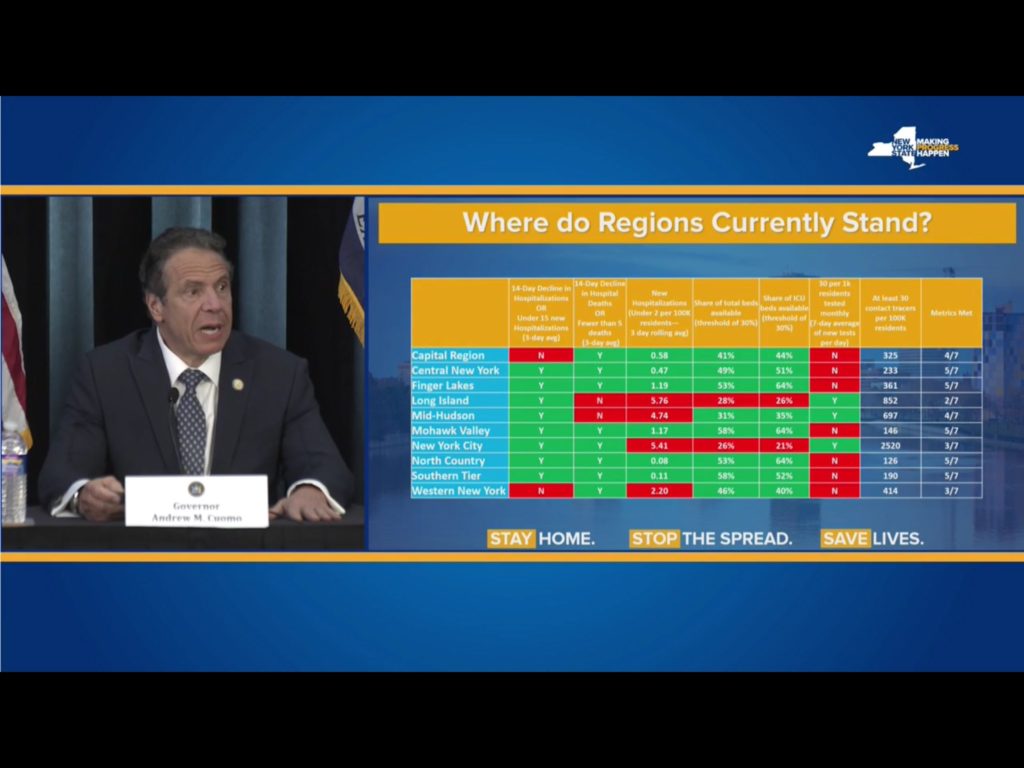
Pictured: NYS Governor Andrew Cuomo displays a chart showing each area’s key metrics for reopening. As of writing, no one area meets all the outlined criteria. (Photo Credit – NYS Governor’s Office)
Cuomo said that so far, one million New Yorkers have been tested. “New York is doing more tests than any country on the globe per capita,” he said, adding that it doesn’t matter whats happening statewide because each region needs to be able to demonstrate their own testing capacity.
In yet another unprecedented regional action that is quickly becoming the new normal as the federal government delegates pandemic response to the states, the governors of New York, New Jersey, Connecticut, Pennsylvania and Delaware are banding together to both purchase and allocate personal protective equipment and medical equipment. Both Massachusetts and Rhode Island will also be participating in the regional collective.
By aggregating their orders, the governors expect to be able to purchase at lower prices and have a stabilized supply chain. The collective of states first agreed to coordinate their re-openings in April.
On Sunday, Governor Cuomo said that hospitals throughout New York would be required to build a 90-day supply of personal protective equipment in preparation for another outbreak.
Financially, the state is reeling – a new report from the governor’s office found that New York saw a staggering $8.1 billion decline in revenue due to the pandemic, a drop of 14%.
On Long Island, Suffolk County Executive Steve Bellone said that reopening in the suburbs may look different than the reopening of the five boroughs. “We’re trying to take a coordinated approach as much as possible,” he said, adding that Nassau and Suffolk are more aligned with each other when compared to New York City. The governor is the only person who can lift a shutdown.
In addition, the Metropolitan Transportation Agency reminded riders that off-peak fares are in effect for all Long Island Rail Road trains, as the agency continues to operate the MTA Essential Schedule. The fares are in place even for trains running during traditional AM/PM rush hour times.
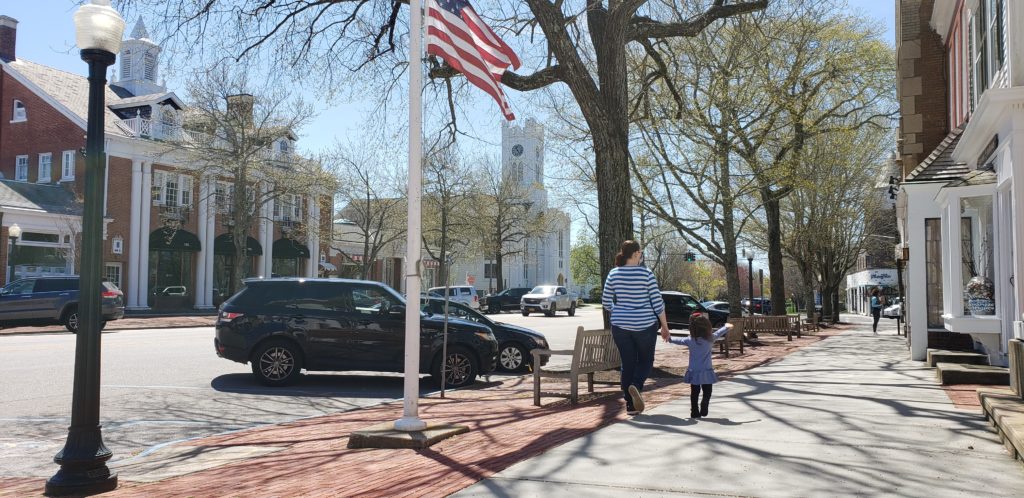
Pictured: Long Islanders take a walk in an uncharacteristically quiet Southampton Village over the weekend. As the weather improves, public officials are stressing the need for people to continue social distancing. (Photo Credit – Richard Murdocco/The Foggiest Idea)
Nationally, more and more lenders are offering zero-interest financing for new and used cars, as well as offering deferred payment plans. By providing record amounts of financing at 0% interest rates on loan terms up to seven years, auto lenders are hoping that such measures will revive lagging car sales. According to data from Edmunds, nearly 26% of loans for new cars purchased in April had 0% interest, compared with around 5% of new-car loans in March.
The cruise industry is under fire from federal and international regulators for it’s role in helping fuel the global spread of the coronavirus. An investigation from the Wall Street Journal found that the cruise industry launched voyages on more than 100 ships on or after March 4th, significant for being the date of the first confirmed COVID-19 death of a cruise passenger that stopped in the U.S. Authorities are investigating the cruise lines to see if they flouted typical ship-to-shore disease protocols, and whether or not they ignored red flag warnings about the pandemic from health agencies.
In total, 30 states have begun easing lockdown restrictions, even as the number of coronavirus cases continue to climb nationwide. Scott Gottlieb, a former head of the Food and Drug Administration, said during an appearance on CBS’ “Face the Nation” Sunday that the number of coronavirus cases continues to climb in 20 states, including some like Texas and Tennessee where restrictions are beginning to ease.
According to a Wall Street Journal analysis of data from Johns Hopkins, the U.S. has reported more than 20,000 new infections and over 1,000 deaths each day since the end of March. “We expected that we would start seeing more significant declines in new cases and deaths around the nation at this point, and we’re just not seeing that,” Dr. Gottlieb said.
UPDATE AS OF 1:00 PM, FRIDAY, MAY 1ST, 2020:
Giving credit to the collective actions taken by residents to fight the spread of the coronavirus, New York State Governor Andrew Cuomo said from Albany on Friday that social distancing and shutdown policies likely kept 100,000 people out of the hospital during the pandemic.
“You tell me what we do today, I will tell you the number of people sick tomorrow,” Cuomo said. “New Yorkers have continued to do what they have to do,” he said, giving credit for the consistently falling hospitalization rates statewide.
Despite the positive metrics, new cases of COVID-19 seem to have plateaued at a stubbornly high rate. At around 1,000 newly reported cases every day, Cuomo said it is now necessary to drill down on why the infection continues to spread. Over the last three days, 17.5% of new infections are coming from Manhattan, and 17.4% in Brooklyn, the two highest ares in the state. On Long Island, Nassau had 10.1% of these new cases, while Suffolk had 7.4%.
In the last 24 hours, there have been an additional 289 deaths from the coronavirus, bringing the statewide total to 18,563. The latest figures mark the first time that the daily death rate has dropped below 300 in weeks.
On Friday, Cuomo announced that all K-12 schools and colleges in New York will be closed for the rest of the academic year. “We must protect our children, every parent and citizen feels that,” Cuomo said, adding that districts will continue providing distance learning. Cuomo also noted that a decision regarding summer school programming will be made at end of the month. “There is no decision on the fall, because the fall is a long time away,” the governor later said.
In addition, front line workers will now have direct access to mental health resources. “We’re going to learn many difficult lessons from this situation,” Cuomo reflected. “We have to go day to day, and try to make the best of a bad situation,” he added, saying that the spirit of community across New York is tangible. “You can be socially distanced, but spiritually connected.”
As the New York Metropolitan area begins to emerge from the other side of one of the most devastating events in it’s history, the way forward presents it’s own set of both new and unique challenges.
As pharmaceutical companies race to produce a coronavirus vaccine that’s safe for mass inoculation, experts are saying that a parallel challenge will be producing enough syringes and other medical products to deliver whatever is eventually developed to nearly 300 million people. “We’re thinking about the vaccine, but what if the vials it is stored in, or rubber stoppers in the vial or the plungers in the syringes become the constraint?” said Prashant Yadav, a globally recognized scholar in the area of healthcare supply chains, told the New York Times.
In the downstate suburban counties, both county executives and the governor’s office have decided that plans to reopen will be fluid and aligned across multiple levels of government. According to Newsday‘s The Point, county leaders from Nassau, Suffolk, and Westchester counties told Cuomo during a call Thursday that their various suburban communities should be treated differently than New York City in terms of reopening. During the conversation, the county executives stressed differences within their localities compared to the boroughs ,with particular regard to schools, public beaches and pools, restaurants, and camps and day-care facilities .
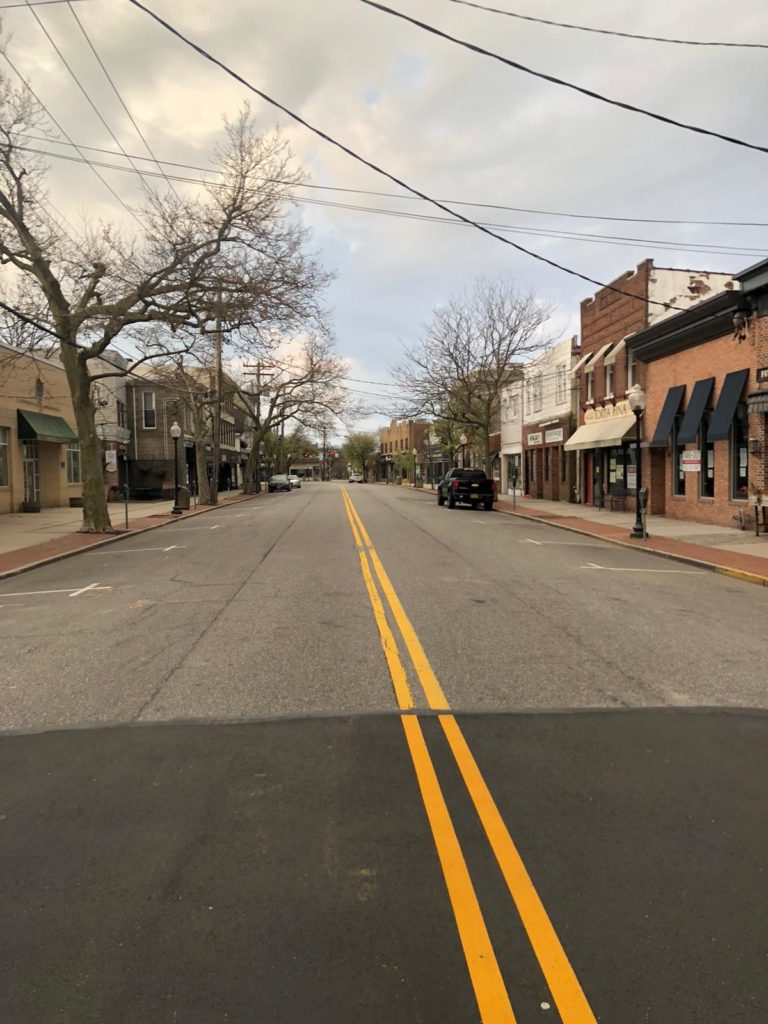
Pictured: Main Street sat quiet within Babylon Village during the coronavirus pandemic on a weekday morning in mid-April. Overall, consumer spending, the largest driver of economic activity nationally, has plunged 7.5%. (Photo Credit – John Lozowski/Freelance)
With demand for oil and gasoline continuing to reach record lows, a flotilla of oil tankers are essentially parked in the Atlantic Ocean nearly six miles off the coast of Nassau County’s City of Long Beach. In mid-April, gas station owners told Newsday that they have seen fuel sales plummet by as much as 70%. Meanwhile, while less Long Islanders are driving, more and more are turning to golf to keep busy. Courses across the region are reporting that their tee times are fully booked, with some of the bigger courses lacking availability for days.
Over 233,000 Long Islanders are among the 30 million nationwide who are unemployed due to the pandemic. During the past week alone, 28,592 additional workers filed for unemployment in Nassau and Suffolk Counties, an increase of 1,161% when compared to the same time last year.
Nationally, a growing number of airlines are requiring masks on their flight crews, while domestic carriers United, Delta and American have expanded such orders to passengers as well. On the ground, Simon Malls is delaying mall openings until Monday after previously announcing their properties would open today within states with eased social distancing restrictions.
After hitting what may have been economic rock bottom in March, U.S. markets had a strong performance in April as both the Dow Jones industrials and the S&P 500 each finished with their largest one-month percentage gains since January 1987. Packaged food producers in particular have benefited, with companies such as Kraft Heinz, Kellogg’s, and Mondelez International (the maker of Oreos among other packaged staples) saying that pantry-loading has boosted their sales. Overall though, U.S. consumer spending plunged 7.5%, a metric that accounts for 70% of total economic activity.
The market performance runs counter to the skyrocketing unemployment rate, with top economists telling the Wall Street Journal on Friday that they expect the April unemployment rate to hit 16%.
UPDATE AS OF 1:00 PM, THURSDAY, APRIL 30TH, 2020:
An additional 3.8 million workers filed first-time unemployment claims last week, driving the total number of unemployed above 30 million nationwide. The job loss numbers highlight the current pandemic as one of the most severe and sudden drops in economic productivity in modern history.
In response to the increasingly dismal economic news, federal stay-at-home guidelines first established in mid-March and then extended in April are now set to expire. “They’ll be fading out, because now the governors are doing it,” President Trump told reporters Wednesday, referring to the restrictions.
In New York, Governor Andrew Cuomo’s “New York State on PAUSE” executive order is set to expire May 15th. However, given the pandemic’s reach in downstate areas, reopening will be staggered to give areas that were least impacted initial priority for reopening. “Reopen, but don’t reopen in a way that increases the spread of the virus,” Cuomo said during a briefing from Albany Thursday.
Cuomo said on Thursday that hospitalizations, intubations and new COVID cases are still down, with the latter remaining what he called “stubbornly” high. An additional 306 people have died from the virus statewide, bringing New York’s total of confirmed COVID-19 deaths to 18,274.
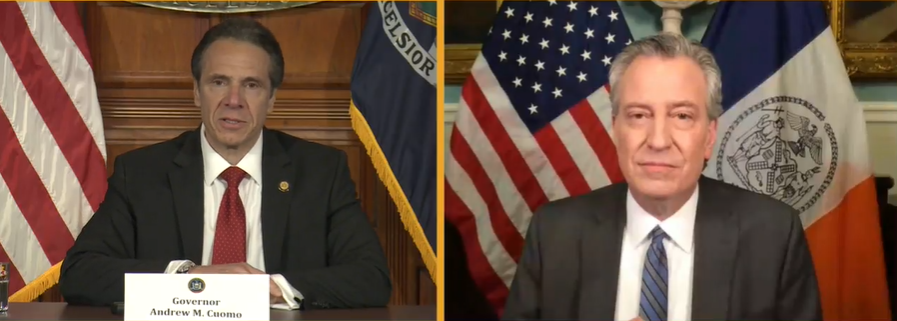
Pictured: NYS Governor Andrew Cuomo and NYC Mayor Bill de Blasio announce plans to have the MTA disinfect subway trains during a briefing from Albany on Thursday. (Photo Credit – NYS Governor’s Office)
Describing the methodology needed for effective contact tracing, Cuomo said the challenge is overcoming the overall scale of the operation. “Yesterday, 4,681 people tested positive… That’s why this is so hard.” he said. The need for tracing is immediate in order to meet the growing scale of testing. Estimating that 30 contact tracers are needed per every 100,000 people, Cuomo said that New York may need anywhere from 6,400 to 17,000 tracers.
Video conferencing in during the briefing, former New York City Mayor Michael Bloomberg stressed the need for the massive tracing operation. “When social distancing is relaxed, contact tracing is our best hope for isolating the virus,” the former mayor read from a statement. “This problem is bigger than any one of us, but it is not bigger than all of us,” Cuomo added. “We want the best system we can have to get New York open,” the governor noted, saying any system developed will be beneficial to other areas.
To help improve conditions for essential workers who use the mass transit network, Cuomo announced that the Metropolitan Transportation Agency will disinfect all trains and buses system-wide every 24 hours by stopping subway service from 1:00 AM to 5:00 AM each night. “This is a whole new process,” Cuomo said, calling the cleanup effort unprecedented. The MTA will offer bus service and for-hire-vehicles at no cost to essential workers during these down periods.
For the Long Island Rail Road and Metro-North, the MTA’s suburban commuter railroads, each train will be disinfected without service interruption.
Across Long Island, labs and walk-in clinics recently began offering antibody tests to help people determine if they have been exposed to the coronavirus. Antibody testing has been widely seen by health experts as a reliable measure to help gauge the virus’ transmission within a given region. Cuomo said the goal is to continue having testing capacity increase, and to that end, 5,000 independent pharmacies will soon be offering tests statewide.
Northwell Health, New York’s largest hospital system, is reporting that their facilities are only a couple days away from having more non-COVID patients then COVID patients for the first time since the outbreak first began. In Mineola, NYU Winthrop Hospital has seen a 50 percent decrease of coronavirus patients when compared to the pandemic’s peak. Based on the data, Nassau County County Executive Laura Curran said on Wednesday that she expects the county to hit the benchmarks in hospitalizations and community spread required for a phase one reopening.
An ongoing double-blind study of the experimental antiviral drug remdesivir is showing that it can be effective in speeding the recovery from COVID-19. “The data shows that remdesivir has a clear-cut, significant, positive effect in diminishing the time to recovery,” Dr. Anthony S. Fauci, director of the National Institute of Allergy and Infectious Diseases, said of the drug’s promise on Wednesday. “That is really quite important,” he continued, adding that “it has proven is that a drug can block this virus.”
Nationally, retailers are now making plans to reopen. Simon Property Group, who owns the Roosevelt Field, Walt Whitman, and Smith Haven Malls on Long Island, are opening locations in states such as Georgia and South Carolina with reduced lock down restrictions. In addition, Macy’s will be reopening dozens of stores on Monday in these areas as well. The company, the first to announce a formal reopening strategy, expects to have its entire fleet of stores operating in six weeks.
UPDATE AS OF 12:45 PM, WEDNESDAY, APRIL 29TH, 2020:
The latest coronavirus figures show that the overall number of newly admitted patients with COVID-19 within New York State hospitals has fallen more than 70 percent since the outbreak’s peak earlier this month.
“Hospitalization rates ticked down, that’s good news,” New York State Governor Andrew Cuomo said during a briefing from Albany on Wednesday. “What we’re watching now is how fast the decline, how low does it go.” The number of deaths within the last 24 hours have held steady at 330, bringing the statewide total to 17,968. “The decline has been slow at best and still disgustingly high,” Cuomo said of the additional deaths.
Citing examples of second coronavirus waves across the globe, Cuomo stressed that New York’s approach to any reopening effort will be based upon on-the-ground data.
To reopen, regions in New York will need to maintain an overall 30% hospital capacity, 30% capacity of ICU beds, and have no statistically significant increase in hospitalizations or infection spread. For perspective within Suffolk County, both hospital and ICU beds were filled at around 72% capacity.
In total, New York State is able to conduct around 30,000 COVID-19 tests per day, a higher rate of testing compared to countries such as Italy or even the overall United States. Experts have said in recent weeks that increasing testing capacity will be key to a safe reopening of the economy. Along those lines, Cuomo also said that less-impacted parts of New York can once again allow elective surgeries, most of which are located upstate and across the western tier. These areas include Allegheny, Essex, and Putnam counties.
As state revenues continue to plunge nationwide, Cuomo assailed both Senators Rick Scott of Florida and Mitch McConnell of Kentucky for calling any financial support of state and local entities from the federal government a bailout. “You are bailing out New York, when every year you take out more from the kitty, the federal pot, $37 billion more than you put in? Who is bailing out whom?” Cuomo said in disbelief, noting that by not assisting local governments, both senators are making a choice not to fund police, firefighters, nurses, teachers and the others that localities support.
“You have human suffering, people dying, you can’t stop the politics, even in this moment? Even in this moment when people are dying all across the country, you still want to play your politics?” Cuomo fumed, noting that their sentiment runs counter to the American instinct to be a good neighbor. Unveiling a wall of homemade masks that have been mailed to his office from people across the country, Cuomo said we should see “a little more of this, and a little less of the ugliness and the partisanship,” adding that the masks are “what this country is about.”
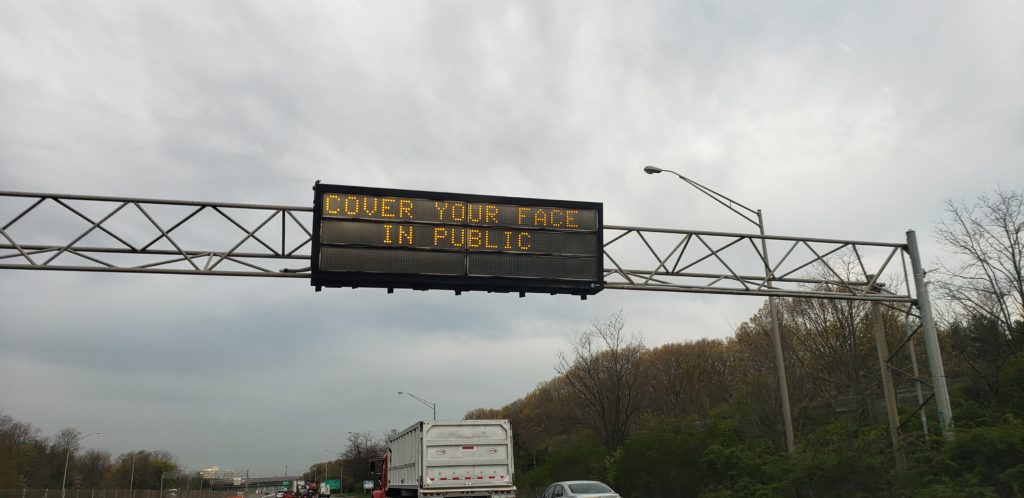
Pictured: Signs along key roadways on Long Island display public alerts on Wednesday. In recent days, messaging has shifted from encouraging stay-at-home orders to preventing further spread of the coronavirus. (Photo Credit – Richard Murdocco/The Foggiest Idea)
While the human toll of the pandemic may finally be ebbing, more of the economic damage is coming to light as figures released by the U.S. Bureau of Economic Analysis on Wednesday show that the domestic economy shrank at a 4.8% pace in the first quarter as the coronavirus first spread. The figure, based on the U.S.’ gross domestic product, which tallies goods and services produced, represents the steepest contraction seen since the last recession in 2008.
Locally, Baumann & Sons, one of the Nassau/Suffolk region’s largest school bus companies, has announced that it is going out of business. Back in March, the company had laid off around 900 drivers and other employees due to the prolonged closure of schools during the pandemic. Now, the closure is permanent.
Nationally, more states are speeding towards reopening their economies even as the number of confirmed coronavirus cases topped one million across the U.S. and the death toll climbed to nearly 58,400. It has been about three months since the first reported COVID-19 case in the country, according to data sourced from Johns Hopkins University.
The overall number of deaths in several states that were hardest hit by the pandemic are nearly 50 percent higher than normal, according to new statistics from the Centers for Disease Control and Prevention. The partial figures suggest that official death counts in these areas most likely undercount the virus’ death toll significantly.
Factors adding to the undercount include limited availability of testing, and those who die outside a hospital are not being tested for COVID-19.
UPDATE AS OF 2:00 PM, TUESDAY, APRIL 28TH, 2020:
Key metrics showcasing the pandemic’s continued spread have been trending downward for days, accelerating talk of gradual reopening throughout the New York metropolitan region. Across the state, new hospitalizations from the coronavirus over the last 24 hours is now under 1,000 people.
During an afternoon briefing on Tuesday from Upstate Medical University in Syracuse, New York State Governor Andrew Cuomo announced that an additional 335 people passed away yesterday from the coronavirus. “Everybody is talking about reopening,” Cuomo said. “But when we talk about reopening, this should not be a political discussion, a philosophical discussion. It is a factual discussion on reopening,” he said. In total, New York had 17,638 deaths from the virus as of publication.
“We’ve gone to hell and back over the past sixty days, but we have to remain vigilant. We want it to be over, but it’s not over,” he added later.
When it comes to reopening, the governor says that watching hospital capacity in the state’s various regions will be a key determining factor. Any region looking to reopen will need to ensure there are sufficient resources for testing, tracing, and isolated placement of those who test COVID-19 positive, and the state is also aiming to see if a region’s viral transmission rate stays below one percent, an important benchmark given the virus’ 14-day lag. Both metrics will determine the triggering of what the governor is calling a “circuit breaker” that will trigger policy actions.
In addition, Cuomo said that a decision on reopening schools will be coming by end-of-week.
Reflecting on the efforts taken by New Yorkers to reduce the spread, the governor argued that based on the early projections, 100,000 people avoided being hospitalized from the virus due to the public’s diligence about social distancing and self-isolating.
In New York City, plans are being drawn-up to close 40 miles of streets to vehicles in order to create more public space throughout the five boroughs. Eventually, officials would like to close up to 100 miles. According to Mayor Bill de Blasio, priority will be within communities hardest-hit by the virus.
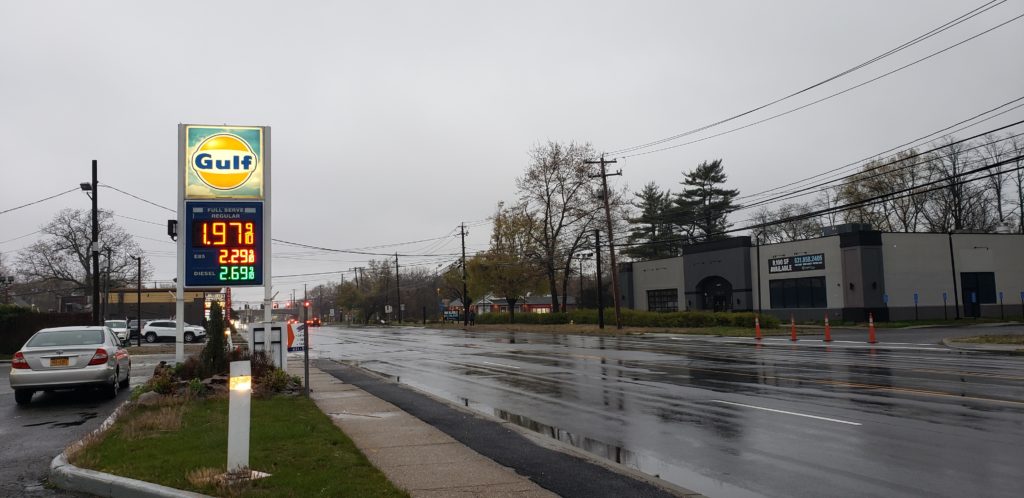
Pictured: Gasoline stations across the Nassau/Suffolk region are now selling gas for less than $2 per gallon for the first time in over a decade. (Photo Credit – Richard Murdocco/The Foggiest Idea)
In Nassau and Suffolk Counties, elected officials are preparing for their eventual reopening in the coming weeks. “Given our current trajectories, our daily improving numbers, and without any unexpected hiccups, it is my opinion, and I am saying this as my opinion, we are within striking distance of reopening parts of our economy, like some outdoor construction,” Nassau County Executive Laura Curran said Monday afternoon. Only the governor has the ability to fully lift stay-at-home orders.
Nationally, the Trump administration said Monday evening that they are working to expand coronavirus testing capacity, with the nation’s top testing official promising the capacity to conduct at least 8 million tests a month by the end of May. Critics of the White House’s approach are saying the administration’s current plan lacks substantive details on expanding lab capacity or activating manufacturing capacity, and that their previous initiatives announced by the president in March have been slow to materialize.
Laboratories across the country are currently able to process roughly one million tests per week, but public health experts say that testing still needs to be greatly expanded to four million or more tests weekly if lockdown orders are to be lifted safely. On the state level, both Georgia and New York have already tested more than 2% of their populations, and governors are pressing the federal government for more help to expand testing efforts.
The Trump administration is also planning to use the Defense Production Act to order meat processing plants to stay open, declaring them critical infrastructure. The move is intended to stave off shortages of beef, chicken, eggs, and pork. Food industry experts have said that plant closures could have shut down as much as 80% of production capacity.
The Centers for Disease Control recently added several symptoms to its watch list for COVID-19, including muscle pain, headaches, sore throat, and a new loss of taste or smell. A new study conducted by Arizona State University found that the public’s wearing of masks likely has a significant impact on the spread of coronavirus in the New York metropolitan region and in Washington State. “Face mask use should be as nearly universal as possible, and implemented without delay,” researchers concluded.
UPDATE AS OF 1:00 PM, MONDAY, APRIL 27TH, 2020:
With the pandemic beginning to loosen it’s grip, a cautious optimism is beginning to emerge as policymakers look towards reopening the economy throughout the northeast.
However, good news takes a strange form these days as the number of daily deaths from COVID-19 fell below 400 for the first time in over a month, with 337 victims dying within the last 24 hours. In total, the coronavirus has claimed the lives of 17,303 people in New York as of writing. New COVID hospitalizations remain flat, while the number of new virus cases are down slightly. “We don’t want to see flat, we want to see an increase in the decline,” New York state Governor Andrew Cuomo said during a briefing Monday.
On Sunday, Cuomo had said that construction and manufacturing businesses within the less impacted upstate areas may be able to reopen with certain precautions after May 15th, when the executive order that shut down New York is set to expire. An eventual second phase of reopening will be based on an assessment of how essential the business is to the populace and the level of risk present. “We don’t want to create a situation where people flood an area because they’re looking for something to do,’ Cuomo said Monday of reopening, adding that localized metrics such as hospitalization rate, antibody testing, and infection rate will guide the process.
In addition, temporary medical centers constructed in the downstate region will be “on-hold” for the upcoming fall flu season and just in case there is a second wave of infection from the coronavirus. The governor also said that the state is launching a new project with companies to prevent surplus food waste at farms by redirecting excess food to food banks in downstate areas.
Retail chains such as Macy’s, the Gap, and TGI Fridays have said that they will not participate in any early phases of reopening due to ongoing health concerns and unsteady consumer demand. Meanwhile, Domino’s Pizza is looking to expand their operations with plans to hire more than 10,000 workers to better deal with large spikes in demand from quarantined customers. The company plans on making upwards of $15 million in investments on employee bonuses, enhanced sick-pay policies, and personal protective equipment for workers.
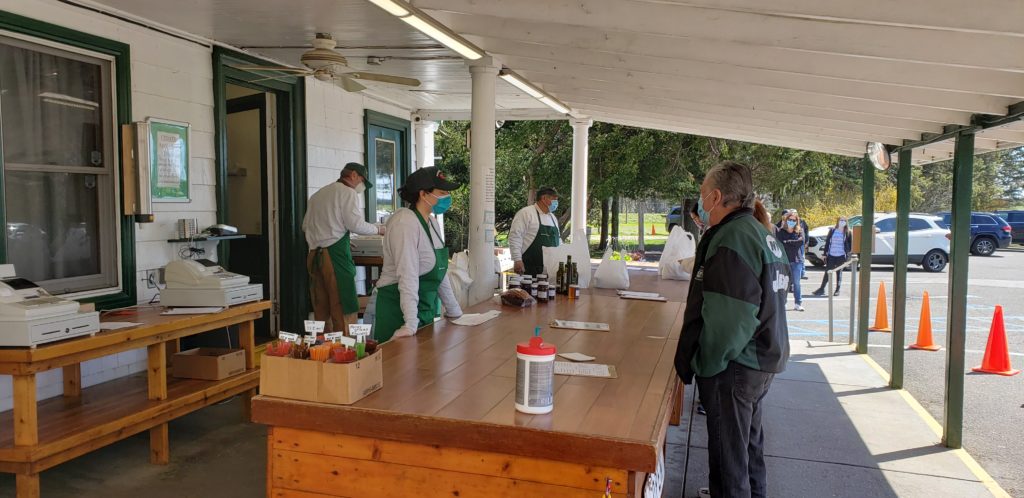
Pictured: Workers wear face masks and gloves while shoppers practice social distancing at Briermere Farms in Baiting Hollow on Saturday. Unlike the situation further westward, the pandemic’s spread hasn’t been as severe within the more rural parts of Eastern Suffolk County. (Photo Credit – Richard Murdocco/The Foggiest Idea)
Across Long Island, AAA Northeast has found that traffic on roadways in the suburbs and within New York City has decreased up to 75% during the pandemic. Local law enforcement agencies across Long Island have seen a steep drop in speeding tickets, car accidents, and DWI arrests as well.
According to officials, Long Islanders have been better at filling out the upcoming U.S. Census during the pandemic than the rest of New York. The survey response rates in both Nassau and Suffolk counties, at 55.1% and 50.1% respectively, are higher than New York State’s overall rate of 46%, but nearly half of households within the region have not responded to the Census yet.
Nationally, nearly half of all states in the U.S. are seeing as many COVID-19 cases as ever, with the latest data suggesting territories have yet to hit their peak caseloads. “In places where the data suggests COVID-19 cases are still increasing, they tend not to be increasing all that fast. especially when you compare where we are now to the exponential rates of spread we saw initially in New York and Louisiana,” Nate Silver, editor in chief of FiveThirtyEight, which analyzed the statistical spread of the coronavirus,wrote. “Of course, the catch here is the spread would likely accelerate again if restrictions were lifted.”
American farmers are continuing to dump milk, throw out surplus eggs, and plow under unused healthy crops of fruits and vegetables as the virus further disrupts restaurant and institutional supply chains. Dairy industry experts estimate there is a surplus of at least 10% more milk than can be used, and as much as 7% of all milk produced in the U.S. last week was dumped out. Across the country, demand for bacon has plunged as restaurants no longer serve breakfast, and chicken breast prices have fallen since their peak in mid-March.
UPDATE AS OF 12:30 PM, FRIDAY, APRIL 24TH, 2020:
As the number of new hospitalizations for COVID-19 throughout New York State continues to trend downward, experts are now thinking that the virus was spreading throughout the region as early as January of this year.
From a briefing in Albany on a rainy Friday, New York State Governor Andrew Cuomo said that “all the evidence suggests we’re on the downside of the curve.” Still, COVID-19 claimed an additional 422 victims in the last 24 hours, bringing the statewide total to 16,162. “It’s dropping somewhat, but it’s still devastating news,” the governor said.
Consistently faced with the question of the state’s time to reopen, Cuomo says it’s simply too soon. To him, if the economy reopens now, “all the progress we’ve made is gone, and virtually all experts will say not only does the virus spread increase, but it increases to a higher point than the first time.” Saying that the virus is remarkably effective at spreading, Cuomo said he knows people are eager to know when things would return to normal.”I know everyone is impatient; that’s what happens if we just reopen,” the governor said.
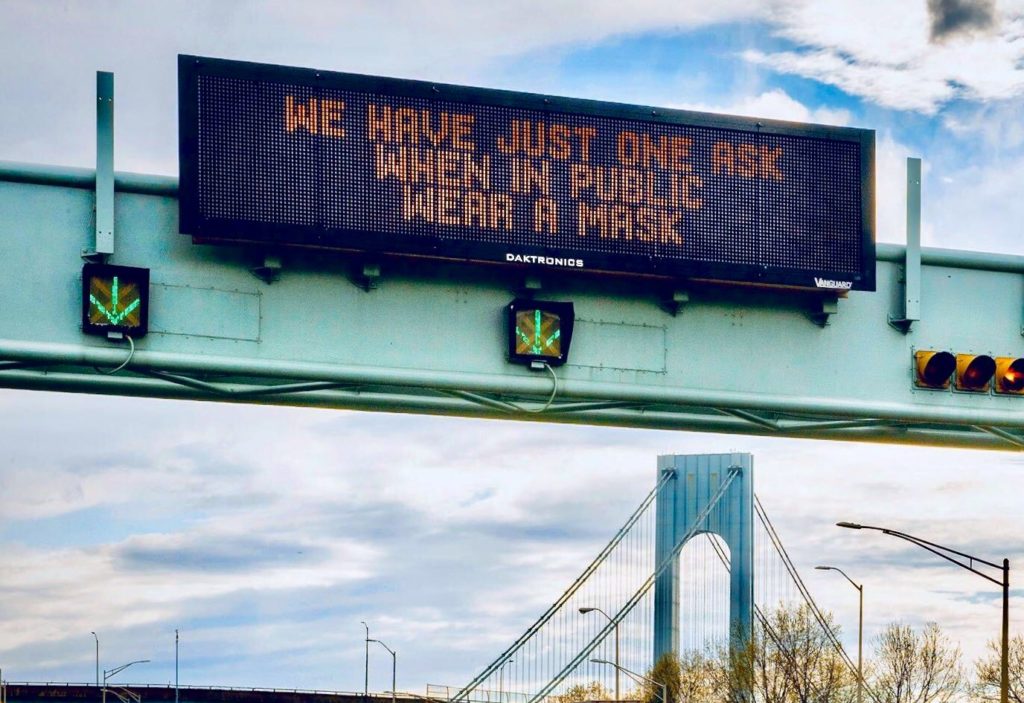
Pictured: Signs near the Verrazzano-Narrows Bridge use a catchy rhyme to remind drivers to wear a mask when in public. (Photo Credit – MTA)
Cuomo said that 13,000 flights landed in the metro region from January to March, carrying 2.2 million people from Europe. The volume during this time of unhindered spread helps explain the rapid speed of the pandemic’s growth. “The horse had already left the barn by the time we moved,” Cuomo said of the mitigative measures taken by governments in March. “We closed the front door with the China travel ban, but left the back door open because the virus had left China.” To Cuomo, the lessons are stark. “An outbreak anywhere, is an outbreak everywhere,” he said, saying that while the response was too little, too late, there’s still time to learn for next time. “It will happen again, bank on it,” he noted.
Economically, New York State is facing an expected $13.3 billion economic shortfall within the 2020-2021 fiscal year, with potential losses compounding up to $61 billion across the next four years. Regarding Senate Majority Leader Mitch McConnell’s concept of letting states declare bankruptcy, Cuomo was blunt. “Legally, a state can’t declare bankruptcy,” Cuomo said. “You would need a federal law that allows it,” he added, noting such a law would result in severe stock market turmoil. “I say to the Senate that proposed it – Pass a law that gives the states the legal ability to declare bankruptcy. I dare you.”
In addition, Cuomo announced that he is issuing an executive order so that every New Yorker will receive a vote-by-mail ballot for the upcoming June primaries.
On Long Island, researchers from Northwell Health found that less than a third of those hospitalized in their facilities for COVID-19 had a fever, upending expert understanding of the virus so far. Up until now, fever has been assumed to be a key early indicator of a patient having COVID-19. Throughout New York, experts said that 89% of deaths from the virus involved at least one underlying condition, such as diabetes or obesity.
In Congress, there is growing bipartisan concern over the finances of state and local governments like those within New York that were hardest-hit by the virus. While many states were already under financial strain due to various pre-existing issues with their pension funds, the virus’ impact on sales tax revenue and historic unemployment claims have brought many to the financial brink.
“Many states are already reporting precipitous declines in revenues that fund state services in health care, education, public safety, transportation and other vital programs,” members of the National Governors Association wrote in a letter to congress earlier this week. “States and local governments need robust support from the federal government as we navigate the response to this pandemic and to help foster the economic recovery that is ahead.” The $484 billion relief package that was approved yesterday by both the House and Senate did not include any support for state or local governments.
Still, states such as Utah, Tennessee, and Georgia are pressing forward with plans to reopen their economies, despite not having the full approval of medical and emergency response experts. “I have great concerns about federal and some state pressure to reopen the economy without the guidance of the public-health data,” Erin Mendenhall, mayor of Salt Lake City, told the Washington Post. “No one doubts the gravity of this economic crisis, but the cost of human life is also grave.”
In addition, the Food and Drug Administration on Friday has issued a warning against prescribing hydroxychloroquine to patients with COVID-19 outside of hospitals or clinical trials due to serious poisonings and heart problems.
In grocery stores across the country, consumers are finding that meat is harder to come by as grocers struggle to find suppliers. Compared to last month, beef production industry-wide has fallen 24%, pork processing is down 20%, and poultry production has dropped 10%. So far, about a dozen meatpacking facilities in the U.S. have closed this month, while plants have slowed production as workers stay home.
UPDATE AS OF 12:30 PM, THURSDAY, APRIL 23RD, 2020:
According to the latest figures from the Labor Department released early Thursday, an additional 4.4 million Americans have filed for first-time unemployment benefits. Since the start of coronavirus-related shutdowns began nationwide, a total of over 26 million workers have filed jobless claims. While the latest job loss figures remain historically high, there are signs that the overall pace of layoffs may be past it’s peak.
In New York State, the total number of hospitalizations continues to decrease, but the number of new COVID-19 cases being diagnosed statewide remains relatively flat. Within the past 24 hours, an additional 438 people have died, bringing the the total number of deaths in New York to 15,740.
“Over the past few days, we’ve basically flattened to 1,300 new cases a day,” New York State Governor Andrew Cuomo said during a briefing on Thursday, noting he’d like to see that number go lower. The longer term question, he says, is whether or not a second wave of the virus will emerge, as it had during other pandemic events historically.
During the briefing, Cuomo shared early results from New York’s antibody testing, which showed concentrations of infection within the hard-hit downstate counties. Based on the results, sourced from around the 3,000 antibody tests that were conducted over the past two days across 19 counties, Cuomo said that New York State’s infection rate is estimated to be 13.9%. That figure represents people who were infected and developed antibodies against the coronavirus.
Regionally, New York City accounted for 21.2% of these positives, while Long Island represented 16.7%. Further north, both Westchester and Rockland Counties accounted for 11.7% of the totals, and the rest of the state was home to 3.6%. “Testing is going to be a major operation that happens now until this situation is over,” Cuomo said, adding that there are different forms of testing for different purposes.
Based on the data so far, the death rate of COVID-19 in New York stands at roughly 0.5%, a figure Cuomo stresses people should take with a grain of salt since it doesn’t include in-home deaths from the virus. The governor thinks that the figures support regional analysis and coordinated policy actions, saying “What you do in a region still has to be coordinated because you have a pent-up demand in the tristate area, where one region opens up for business, you can see people come in and literally overwhelm the region.”
Genetically, samples of the coronavirus found within the state are most similar to viruses in England, in France, and in Belgium. Researchers say the New York strains show less similarities to those found within Italy. In addition, scientists in California have recently discovered that the virus’ first death in the U.S. likely occurred in early February, as opposed to the end of the month.
On Long Island, two supplemental healthcare facilities built at both SUNY Old Westbury and SUNY Stony Brook will not be fully staffed or equipped unless there is a new surge for hospital demand or a second wave of the coronavirus.
For those experiencing financial hardship, Long Island’s homeowners are learning that lenders expect them to pay all missed mortgage payments in a bulk lump sum at the end of their six-month forbearance period. Since the pandemic first began, the Mortgage Bankers Association is reporting that lenders received 270 times more forbearance requests at the end of March than they had at the beginning of the month. Surging from 0.25% to 3.74%, the number of loans in forbearance was roughly 15 times higher in early April when compared to the previous month.
According to the latest data from Douglas Elliman and Miller Samuel, the number of home sales in Nassau and Suffolk Counties have plummeted by nearly 30% when compared to this time last year. Ann Conroy, president of the Long Island division of Douglas Elliman, told Newsday‘s Maura McDermott that the drop in housing market activity is nothing less than severe. “It was like going 300 miles an hour and then hitting a brick wall,” she said.

Pictured: A picturesque sunset over the Great South Bay on Wednesday, as air pollution levels remain historically low throughout the New York metro region during the coronavirus pandemic. (Photo Credit – Richard Murdocco/The Foggiest Idea)
Nationally, the House is expected to formally vote on $484 billion in additional funds to help small businesses and hospitals. Meanwhile, President Trump weighed in as states like Georgia push to reopen as early as Friday. “I want him to do what he thinks is right, but I disagree with him on what he is doing,” he said. “I think it’s too soon.”
Senate Majority Leader Mitch McConnell said during an interview on Wednesday that he supports the idea of allowing states to declare bankruptcy. “I would certainly be in favor of allowing states to use the bankruptcy route,” he said to radio host Hugh Hewitt. “It saves some cities. And there’s no good reason for it not to be available.”
In the public sector, both cities and smaller public entities typically use bankruptcy protection to reduce pension obligations, and other financial burdens. Currently, federal law does not give states a bankruptcy option, and as of writing, Congress isn’t actively working on taking the necessary steps to change that. The municipal bond market largely shrugged off the majority leader’s comments.
Still, response to the concept locally was less than amicable. Long Island-based Representative Peter King called McConnell “the Marie Antoinette of the Senate,” and Staten Island-based Representative Max Rose was even more blunt, saying that “the only type of person who would do or say something like this is a piece of human trash. I have no doubt in my mind.”
“You want to see the markets fall through the cellar? Let New York State declare bankruptcy,” Cuomo added about McConnell’s remarks Thursday. “Vicious is saying what Senator McConnell said, ‘This is a Blue State Bailout,'” he added, noting that New York puts substantially more money into the federal government than is taken. According to Cuomo, Kentucky, who McConnell represents, takes $148 billion more. “Who’s getting bailed out here?,” Cuomo said emphatically. “It’s your state living on the money we generate.”
Both the Agriculture Department and the Centers for Disease Control announced Wednesday that two cats from New York State have earned the dubious distinction of being the first domestic pets to test positive for the coronavirus in the U.S. When asked by The Foggiest Idea about the discovery of the virus’ transmission to pets, George, a local miniature poodle who was found napping on a couch, made no comment.
UPDATE AS OF 1:30 PM, WEDNESDAY, APRIL 22ND, 2020:
It has been 53 days since New York State first closed all non-essential businesses, and signs are emerging that the pandemic is easing. The daily death rate from COVID-19 continues to drop, as does the total number of hospitalizations for patients with the virus. Across New York, an additional 474 people have died in the last 24-hours, bringing the total number of COVID-19 deaths over 15,000, at 15,302.
“Fifty three days is nothing,” New York State Governor Andrew Cuomo said during a briefing from Albany on Wednesday, comparing the current pandemic to lengthier events such as World Wars I and II, and the 1918 Spanish Flu outbreak. While Cuomo acknowledged that this a terrible period of time, he noted that New York is not facing a worst-case scenario. “We’re in a better place. The really bad news would have been if we concluded we couldn’t control the spread of the virus,” he said.
Yesterday, the governor met with President Trump at the Oval Office, with the end result being the President firmly committing to help New York State double its capacity for coronavirus testing. The process of scaling up the state’s testing capacity is estimated to take several weeks. Overall, Cuomo said that the meeting was both apolitical and productive. “We have a plan going forward, and that was accomplished yesterday,” Cuomo said, citing the foxhole politics times of crisis require. “Politically, we’ve had conflicts back and forth, but we sat with him, and that was put aside.”
Cuomo also announced an joint effort with former New York City Mayor Michael Bloomberg to develop a comprehensive COVID-19 testing and tracing program throughout the state. To help the effort, Bloomberg will provide logistical support and $10 million in funding.
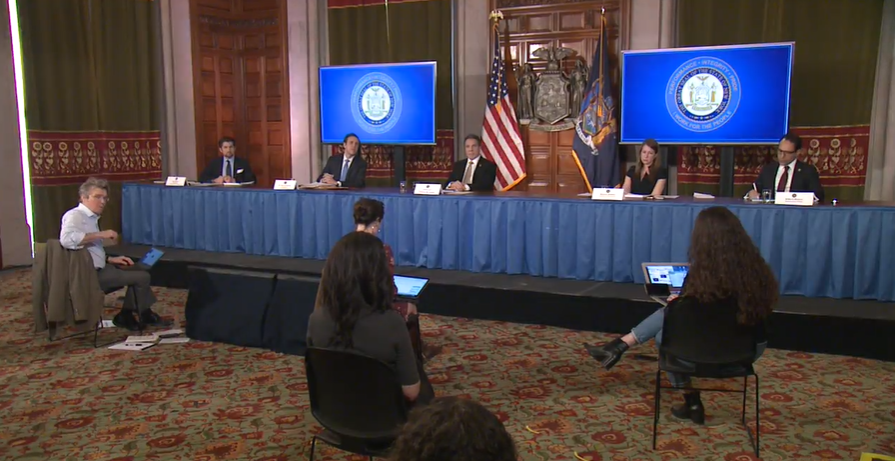
Pictured: New York State Governor Andrew Cuomo speaks to the press in Albany on Wednesday. (Photo Credit – NYS Governor’s Office)
In recent days, Cuomo says that local officials have expressed to him the political pressure they’re feeling to reopen. In turn, the governor was blunt. “This is a profound moment, but if we make a bad decision, it will set us back,” Cuomo said. “Frankly this is not time to act stupidly,” he added, acknowledging the current situation isn’t sustainable in the long term. “Blame me,” he told them.
As Cuomo spoke, protesters gathered outside the State Capitol to protest the sustained closures. “I get the economic hardship,” Cuomo said in response. “The question is, how do you respond to it, and do you respond to it in a way that jeopardizes public health and possible causes more people to die?” he asked. “Nothing comes before the public health risk of someone else’s life.”
In New York City on Wednesday, Mayor Bill de Blasio said on Wednesday that the Macy’s Fourth of July fireworks are likely to go on as planned, albeit without crowds if necessary. “Thank God we know fireworks can be seen by New Yorkers all over the city even just looking out their window or from their fire escape, from the roof,” the mayor said. “But we have to do it in a way that’s safe and smart.”
With the city’s crematoria overwhelmed, David Penepent, an associate professor of mortuary science, has taken it upon himself to transport victims’ bodies to crematories in places as far as Pennsylvania and Vermont.“It’s a godsend,” said Joe Neufeld, the owner of a funeral home in Queens, told the New York Times. “He came out of nowhere to save us.”
Northwell Health, New York’s largest hospital system, is reporting the lowest number of COVID-19 patients within their facilities since April 1st. While the health metrics are improving, the economic toll is more clearly being understood.
Over $2.2 billion in unemployment benefits has been paid to 1.1. million New Yorkers since the pandemic first began, highlighting the vast fiscal scope of the virus. In Nassau County, the pandemic has dealt a crippling blow the county’s already struggling finances, with policymakers expecting over $319 million in lost revenue. A ten percent reduction of sales tax, which typically makes up 40% or so of the County’s overall revenue, is the biggest driver of the losses. “That ten percent reduction will be painful. We will feel it,” Nassau County Executive Laura Curran said. Suffolk County’s finances aren’t likely to fare much better.
According to data from the American Automobile Association, the average price of gasoline across Long Island is $2.14 per gallon. According to an analysis of the factors that shape gas prices in the region by Newsday, Long Islanders would still be paying roughly $1.46 a gallon if oil were free due to local taxes and other assorted production costs.
Paule Pachter, chief executive officer of Long Island Cares food bank, told Newsday there had been a 64% increase in the number of people coming to the six pantries the organization operates. In an effort to protect some of the more vulnerable populations, Suffolk County Executive Steve Bellone said that the county will begin distributing face coverings procured from the state and federal government to seniors and essential workers in the coming days.
Nationally, both congress and the White House agreed to send an additional hundreds of billions of dollars in aid to small businesses and hospitals. The $484 billion bill was passed by the Senate, and is expected to be approved by the House sometime later today. The latest effort allocates an additional $310 billion for the Paycheck Protection Program, boost a small-business emergency grants and loans by $60 billion, direct $75 billion to hospitals, and give $25 billion towards a new coronavirus testing program. The measure does not include support for city and state governments.
In addition, the USNS Comfort, which treated 179 patients with 56 still onboard as of Tuesday, will be returning to it’s home port of Norfolk, Virginia.
Across the country, grocers are seeing a stabilization of the availability of food supplies, but in-demand items such as hand sanitizer or toilet paper. “We can all rest assured that there is enough retail supply of food products,” Leslie Sarasin, president and CEO of The Food Industry Association, told ABC News. “What shoppers may be experiencing is sporadic unavailability of certain ‘high-demand items.'” Experts say that foods like pasta, canned goods, and cereal are likely not going to experience supply issues of their relatively automated manufacturing process.
UPDATE AS OF 12:00 PM, TUESDAY, APRIL 21ST, 2020:
During a briefing held in Buffalo Tuesday morning, New York State Governor Andrew Cuomo stressed the challenges that the coronavirus virus presents in different parts of New York and the country. Overall, the number of key metrics including hospitalizations and intubations of new COVID-19 patients remain flat statewide, but as Cuomo noted, “We have to change our definition of good. Good now is ‘not terrible.'”
On Monday, an additional 481 people have died statewide from COVID-19, bringing the total number of deaths to 14,828. “Different regions of the country have different ‘curves.’ The virus does not hit at the same time at the same rate,” Cuomo said. “It’s also different across the state,” he noted. In the coming weeks, Cuomo said that New York will look to have regional re-openings based on what is happening in each part of the state, marking a shift in approach that policymakers have taken in recent weeks.
“Manhattan is not Buffalo,” the governor said. “Let’s use that same regional template when we reopen,” he noted, saying that data points such as hospitalization and infection rates will guide the process instead of political pressures. “The when is data-driven.”
In areas of New York not heavily impacted by COVID-19, elective outpatient treatments will resume at hospitals within certain regions. The elective procedures will be allowed only in hospitals that Cuomo said are “laying off people because they’re so quiet and they have that capacity,” and are located outside of Nassau, Suffolk, Westchester, Erie, Albany, Dutchess, and other counties that have been hit hard by the virus.
Across New York, residents welcomed news that marinas and boat basins have reopened, as well as golf courses in most counties. Golfers on the links must now maintain strict social distancing, are not allowed to use golf carts, and must carry their own clubs. In Nassau County however, courses remain closed. “We’re putting plans in place, so hang tight, we’re going to tell you soon when you can go back to the greens and tee off,” Nassau County Executive Laura Curran said during a briefing Monday, adding the courses should be open in a few days.
Later Tuesday, Cuomo will be meeting with President Trump at the White House to discuss the country’s capacity for conducting testing on the scale necessary to begin reopening the economy. The meeting’s focus will be “testing, and what does testing mean and how does it work in partnership with the states,” Cuomo said. “It’s a situation where however you do it, it’s going to be a blame game afterwards,” he added. “This is one of those thankless tasks.”
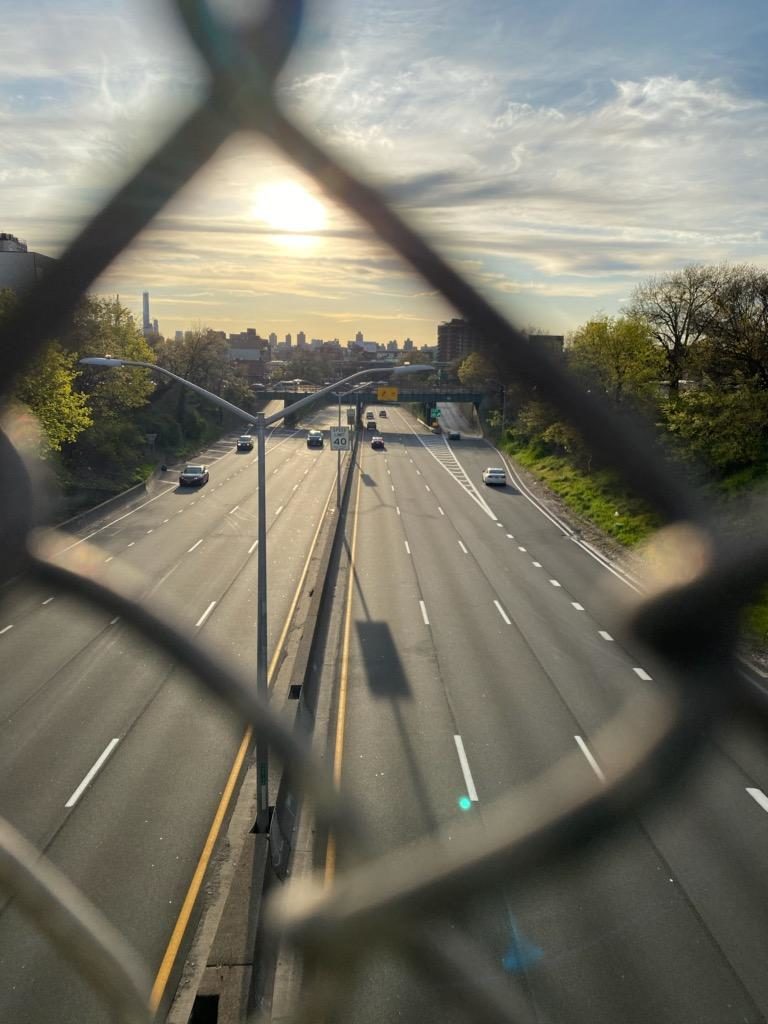
Pictured: The Grand Central Parkway in Queens was lightly used during the PM rush on Monday, as New Yorkers in the hard-hit borough stay home. (Photo Credit – Caitlin A. Harley/Freelance)
Long Island’s Industrial Development Agencies have commissioned a $130,000 economic study that will help policymakers better understand how the coronavirus reshaped the region’s economy. The study is being funded from each agencies’ fee income, not taxpayer dollars, and will be completed by Manhattan-based HR&A advisors, a development consulting firm, in the coming weeks. Typically, such studies take months to produce.
In Suffolk County, officials are aiming to work with local town supervisors to develop guidelines on reopening various municipal facilities, including beaches. In Nassau, Curran noted on Monday that “we’re not done, but we’re in a good place,” based on the number of new hospitalizations for COVID-19 within the county.
In New York City, the number of emergency calls has fallen more than 50 percent since hitting a record peak in late March, when 7,000 calls were made in a single day. The staggering number of calls made then was more than the amount made on September 11th, 2001. With no end to the pandemic on the immediate horizon, Mayor Bill de Blasio announced that all large scheduled gatherings and events in New York City have been cancelled through June.
Nationally, Senate Minority Leader Chuck Schumer is saying that a deal has been reached to replenish the lending programs created to aid small businesses during the pandemic, as well as boost spending on hospitals and testing. “We have a deal and I believe we’ll pass it today,” Schumer said of the $500 billion agreement on CNN Tuesday morning. As of writing, there are no provisions for fiscal relief to states, which Cuomo called “a terrible mistake.”
Using the pandemic as justification, President Trump tweeted late Monday night that he is moving to suspend all immigration into the United States through an executive order. The move has no historic precedent, as immigration continued during both World Wars as well as during the 1918 Spanish Flu pandemic, which was responsible for around 675,000 deaths in the U.S.
A new poll conducted by the Washington Post and University of Maryland shows that 54% of Americans think negatively of President Trump’s handling of the outbreak, and feel that it may not be safe to hold large gatherings through June or later. Local governors fared far better in the survey than the federal government as a whole, with 72% giving positive ratings to their respective state leadership. Workers also rated their employers positively as well.
The U.S. food system is experiencing growing challenges as the virus continues to force plant closures and infect farmworkers. Thanks to more automated production processes, food makers outside of the meat sector have been relatively successful in avoiding factory closures from the virus up until now, as companies such as Kraft Heinz and Conagra Brands begin to shutter plants. While plants are now closing throughout the packaged food sector, some meatpacking facilities that had been previously closed because of the outbreak are reopening with new safeguards in place to protect workers.
Continuing a historic economic decline, domestic oil futures plunged below zero for the first time ever Monday. Across the world, oil refineries, storage facilities, pipelines and ocean tankers are currently filled to capacity since demand for oil has collapsed due to fewer flights and consumers using significantly less gasoline.
“All of that points to a deflationary collapse, a glut of supply of goods and services, and consequently falling prices, that surpasses anything seen in most people’s lifetimes,” Neil Irwin, a senior economics correspondent for the New York Times wrote late Monday. “Economics is about supply and demand, production and consumption. The question for the post-pandemic economy is whether that balance, once lost, can be quickly restored.”
UPDATE AS OF 12:30 PM, MONDAY, APRIL 20TH, 2020:
The amount of reported COVID-19 deaths in New York has dropped for the sixth straight day on Monday. Across the state, an additional 478 have died, bringing the total number of fatalities, including those over the weekend, to 14,347.
“The question for us is, are we past the apex,” New York State Governor Andrew Cuomo said during a briefing Monday as he displayed figures showing hospitalizations on a downward slope. It has been 92 days since the first coronavirus case was discovered in the United States. “The question is now, how long is the descent, and how steep is the descent?”
Instead of merely reopening the economy, Cuomo stressed the need to collectively aim higher. “Lets use this situation, this crisis, this time to actually learn the lessons, value from the reflection, let’s reimagine what we want society to be,” Cuomo said, citing the various significant policy actions taken after 9/11 in downtown New York and on Long Island after Superstorm Sandy hit in 2012. In addition, a new state task force of local policymakers in the downstate region is being formed.
Starting today, the state will start to conduct antibody tests on a random sample of volunteers being recruited from local grocery stores, with the aim of estimating what percentage of its population has been infected. “The big question on the testing is the national manufacturer supply chain, and getting that up to scale quickly,” Cuomo said, saying that most of the necessary materials come from China. “It’s about division of labor and responsibility,” he added, saying both the federal and state governments have critical roles to play to increase testing capacity.
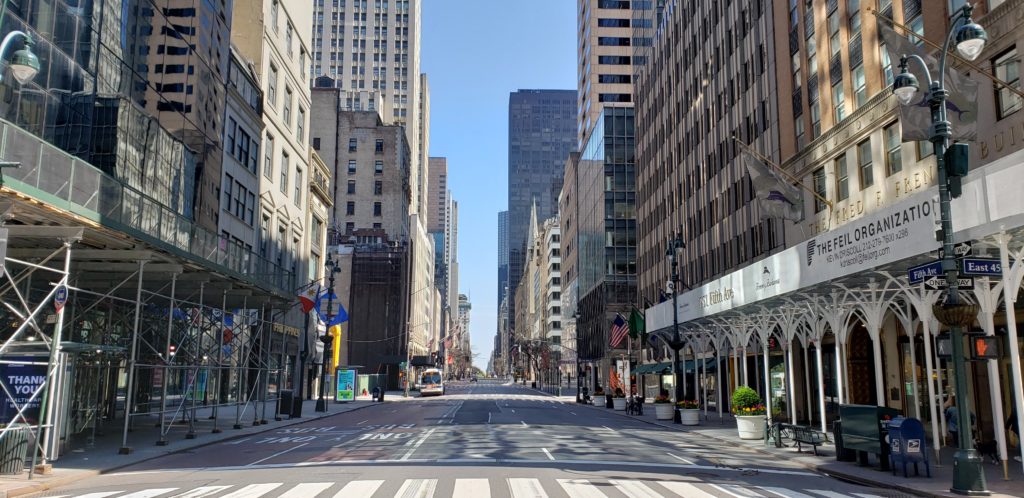
Pictured: Fifth Avenue in Manhattan sat deserted on Sunday as overall traffic at New York City’s busiest crossings has dropped over 60%. In recent weeks, the number of auto accidents has dropped nearly as much as well. (Photo Credit – Richard Murdocco/The Foggiest Idea)
As New York City struggles to free itself from the pandemic’s economic grip, Mayor Bill de Blasio on Sunday called on President Trump to direct more federal funding cities nationwide. “There was that famous Daily News cover that said ‘Ford to City: Drop Dead,’” the mayor said on Sunday. “So my question is, Mr. Trump, Mr. President, are you going to save New York City or are you telling New York City to drop dead? Which one is it?”
According to the Metropolitan Transportation Authority, which operates the city’s subways, buses and two commuter rails, the agency has still has a $8.5 billion shortfall even after scaling back service and recently receiving a $3.8 billion federal bailout. Due to the pandemic, subway ridership has plunged by over 90%, with one expert calling the agency’s financial situation a “worst-case scenario.”
On Long Island, researchers at Brookhaven National Lab are working around the clock to find ways to prevent the coronavirus from spreading on a molecular level. “I am 100% sure science will solve this problem,” John Hill, the director of the lab’s COVID-19 working group, told Newsday late Sunday.
Nationally, congressional leaders and the Trump administration were close to a deal on an additional economic stimulus package to help refund the Paycheck Protection Program and emergency disaster loans. Their latest efforts is likely to include additional money for hospitals, and the expansion of national testing efforts. As of writing, federal support for state and local governments hardest-hit by the virus isn’t on the table.
Expressing worry over the increasingly dire situation with state’s finances, Cuomo continued to press the federal government for support. Without such support, Cuomo estimates that a 20% reduction in funding to schools, hospitals and local governments will be necessary in New York State. To stem the tide of coming cuts, education groups nationwide are banding together to press the federal government to make over $500 billion available for localities and public schools.
On Sunday, the total number of reported coronavirus deaths in the United States topped 40,000 even as the pandemic showed early signs of easing in some states. As more hopeful indicators emerge, governors are feeling pressure to re-evaluate lockdown orders as politically right-leaning protesters took to the streets in Colorado, Ohio, Washington, and elsewhere.
Throughout the pandemic, health policy experts have said that social distancing measures are essential for mitigating the coronavirus’ spread, and only the availability of widespread testing would help things return to normal. “The message is that clearly this is something that is hurting, from the standpoint of economics and the standpoint of things that have nothing to do with the virus,” Dr. Anthony Fauci, director of the National Institute of Allergy and Infectious Diseases, said during an appearance on “Good Morning America” Monday. “But unless we get the virus under control, the real recovery economically is not going to happen.”
A new poll conducted by the Wall Street Journal and NBC found that the protesters are in the minority, as nearly six in 10 Americans expressed concern that the country would loosen restrictions too quickly.
UPDATE AS OF 12:15 PM, FRIDAY, APRIL 17TH, 2020:
Nationwide, the confirmed death toll from the Covid-19 disease continues to rise. The states of New York, New Jersey, and Michigan remain among the hardest-hit states, and new confirmed cases in the United States have risen for three consecutive days, with the total now over 671,000. In total, over 33,000 have died.
In New York State, 630 additional people died from COVID-19 in the last 24 hours, bringing the the statewide total to 12,822. This number may change as the state re-calibrates their methodology to measure COVID-19 fatalities. The rate of new daily measured infections has remained steady around 2,000 cases a day, while the virus’ death rate has persistently remained consistent as well.
During a briefing Friday, New York State Andrew Cuomo said that the only firm way out of the crisis is through widely-available COVID-19 testing and a coronavirus vaccine. “You only have a very slim margin to operate on,” Cuomo said of the virus’ infection rate, and called testing the “next frontier.”
To that end, Cuomo said he is issuing an executive order in the coming days that will coordinate the testing efforts in New York between public and private labs, as well as with the state’s department of health. Still, Cuomo is urging the federal government to take a leadership role in coordinating what has been a series of disparate efforts up until now. “This is mayhem. We need a coordinated approach between the federal government and the states,” he said.
Meanwhile, New York’s finances continue to rapidly deteriorate. “We’re spending money every day that we’ve never dreamed of spending,” Cuomo said of the need to begin generating revenue once again. “We’re paying when we’re in a position where we have no money. You can’t keep writing checks if you have no balance in your account.” To the governor, federal intervention in supporting states is key. Of the three bills passed by Congress, Cuomo says that the states have received zero dollars in unrestricted funding for states.
“This has to be one of those moments in time when we look back, and we say society transformed,” Cuomo said of the pandemic, asking rhetorically how to changes that never had political will before. “You take that moment, learn that lesson, and improve society,” he later added, stressing that future crises will emerge. “There will be something. We have to be ready and better for it.”
In New York City on Thursday, Mayor Bill de Blasio unveiled a proposed budget that is reflective of the economic damage to the city brought by the pandemic. His $89.3 billion proposal, which features over $2 billion in what the mayor called “very tough” cuts, is $6 billion or so less than what he initially proposed at the beginning of the year. After the budget was proposed, the Mayor begged the federal government for a $7.5 billion bailout.
On Long Island, two new COVID-19 testing sites have opened in Wyandanch and North Amityville, two hot spot communities that have seen elevated numbers of infection. Over the last few weeks, Long Island’s testing capacity has grown as additional sites open in hard-hit areas. In Nassau County, the rate of hospital discharges for patients with COVID-19 is outpacing new arrivals.
Out the 1.2 million New Yorkers out of work, over 175,000 of those claims are from Long Islanders. The Nassau/Suffolk region has experienced the largest relative percentage increases in unemployment since the pandemic first began. Gregory DeFreitas, a senior economics professor at Hofstra University, told Newsday that the region’s economic reliance on non-essential retail and hospitality industries have made New York’s suburban counties particularly vulnerable. “There’s a lot more finance and high-tech jobs in the city than on Long Island,” he said.
Nationally, meat suppliers are starting to feel squeezed as the coronavirus spreads throughout the industry, reducing meat production. “We are very concerned about fresh meat,” Robert Griffin, president of B&R Stores Inc., a Midwestern grocery chain, told the Wall Street Journal late Thursday. In his stores, demand has surged 30%, but suppliers are only filling 75% of orders. Before the pandemic, over 660,000 cattle for beef were processed each week, a figure that has since dropped to 500,000. “We have fresh meat today, but there are indicators that it will be a problem in the future,” he added.
Meat isn’t the only industry rapidly slowing down. Nationwide, overall housing starts tumbled over 22% when compared to the same time last year. There was a 17.5% drop in construction of single-family homes, and 32% decline in apartment/condo construction.
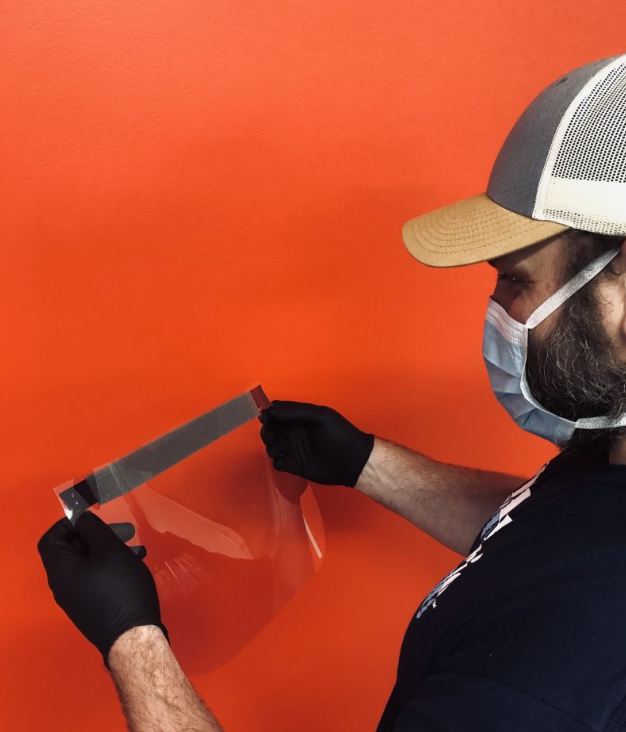
Pictured: A worker assembles a face shield made from repurposed drumhead materials. The Farmingdale, NY-based company plans on assembling 100,000 units per week. (Photo Credit – D’Addario)
The Paycheck Protection Program and the Economic Injury Disaster Loan program, two federal loans to small businesses created under the recently passed CARES act have run out of money after allocating over $366 billion in total.
Across the country, American industries are retooling to better fight the pandemic. Unlike the “Arsenal of Democracy” that united the industrial output of the country to fight the Axis powers during World War II, the movement has been a spontaneous grassroots effort unified by singular purpose.
On Long Island, Farmingdale-based D’Addario, which is known more for guitar strings than personal protective equipment, is now producing face shields repurposed from the materials typically used for their company’s drumheads. After producing their first prototype in three days, the company plans on producing over 100,000 units per week under the Project Excelsior initiative, named after the New York State motto.
Meanwhile, the first ventilators produced by General Motors and Ventec Life Systems are being delivered to hospitals. The hospitals, located in the Chicago area, were chosen by the Federal Emergency Management Agency.
UPDATE AS OF 12:30 PM, THURSDAY, APRIL 16TH, 2020:
An additional 5.2 million workers in the United States filed for first-time unemployment benefits last week, bringing the total to around 22 million workers in the past month. The staggering job losses from the pandemic have effectively erased the net number of jobs that were created within the nine-and-a-half-year stretch since the last recession. With an estimated 20% unemployment rate, the U.S. has not seen this level of job loss since the Great Depression.
In New York, an additional 606 people have died, New York Governor Andrew Cuomo said during a briefing Thursday. Under the old reporting method, which is being updated to reflect probable COVID-19 fatalities, there have been 12,192 deaths statewide since the pandemic first began. The rate of hospitalizations, intubations and intensive care unit admissions remain down.
The governor announced that social distancing measures will be extended across New York in coordination with neighboring states through May 15th.
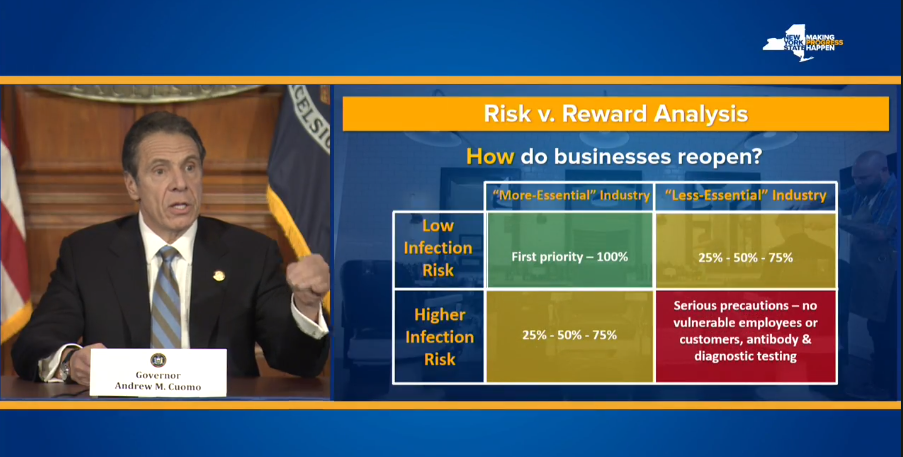
Pictured: New York State Governor Andrew Cuomo briefs the public from Albany on Thursday, displaying a risk analysis that highlights the risk considerations being taken before reopening the economy. (Photo Credit – NYS Governor’s Office)
During his briefing, Cuomo discussed at length how phasing economic activity in is a regional issue. “How do we learn the lessons so this ‘new normal’ is a better New York?,” Cuomo asked rhetorically. “Hopefully, we aren’t doing something that is contradictory to another state,” he added, urging the private sector to re-imagine their workplaces for what he calls a “new normal” post-pandemic.
“Everything we’ve been doing is to slow the infection rate,” Cuomo said, noting that the state hasn’t been able to track that particular metric as of yet. Instead, Cuomo says that hospitalization rates indicate likely infections, but advanced testing will help policymakers better understand how quickly the virus continues to spread. Quoting early projections, which estimated that one person would infect 1.4 to 1.8 people each, Cuomo says that the models initially anticipated a much higher infection rate. “We slowed the infection rate by our actions,” Cuomo stressed. “We brought it less-than-one. Our infection spread rate is 0.9.”
“Ultimately, what determines the rate of infection? You do,” Cuomo said. “It’s about the behavior of our people, it’s that simple,” he said, saying that the policies enacted in recent weeks is “not worth the paper they are printed on” without willing compliance from residents. “These are some of the most life changing policies government has ever issued,” Cuomo elaborated. “They are being implemented by people because people are choosing to do the right thing.”
In a newly announced partnership between Northwell Health and the Metropolitan Transportation Authority, transit workers who show coronavirus symptoms will be offered testing at certain urgent-care centers in New York City. Northwell Health operates 52 urgent-care centers, will be able to test up to 350 transit workers a week. The agreement is similar to arrangements made to have Northwell Health test the city’s police and fire departments.
Across Long Island, the residential real estate market has essentially frozen, as the number of homes listed for sale dropped 19% and sales activity dropped by nearly 20%, both metrics compared to their levels this time last year. The figures were released by the Long Island Board of Realtors late Wednesday. In March, home prices continued to appreciate by 9.5% in Suffolk County, and 2.9% in Nassau. An industry expert told Newsday that prices are likely to fall up to 10% in the coming weeks, but that the overall market is likely to recover in terms of price in three to six months.
On Wednesday, it was announced that the Trump administration is planning to buy milk and meat from domestic farmers as part of a $15.5 billion effort to help them weather the coronavirus outbreak. The action is the first substantial policy action being taken by the federal government to ensure that the coronavirus pandemic doesn’t trigger consumer food shortages.
“It is impossible to keep our grocery stores stocked if our plants are not running,” Smithfield Foods CEO Kenneth Sullivan said in a statement the company released Wednesday. Smithfield Foods recently closed it’s processing plant in Sioux Falls, South Dakota, which provides up to 5% of the pork produced in the U.S. “The closure of this facility, combined with a growing list of other protein plants that have shuttered across our industry, is pushing our country perilously close to the edge in terms of our meat supply,” Sullivan said.
As aspiring bakers-to-be have noticed in recent weeks, there has been limited availability of yeast across the country. Robb MacKie, president and CEO of the American Bakers Association, recently noted that due to timing of the pandemic, the industry was unprepared since demand for bread the ingredient typically peaks comes during the November and December holidays.
“I’ve been with the company for five years, and this is by far the highest demand I’ve ever seen,” John Heilman, vice president of manufacturing for Fleischmann’s Yeast producer AB Mauri, said. Heilman estimates that it will take a month or two until shoppers will see a consistent supply of dry yeast on shelves.
UPDATE AS OF 2:00 PM, WEDNESDAY, APRIL 15TH, 2020:
As the first round of federal stimulus monies begin to appear in taxpayer accounts across the country, hopeful signs of light are beginning to emerge. While the death rate from COVID-19 is keeping a staggering pace of over 700 people a day within the New York metropolitan region, the total number of hospitalizations and intubations are continuing their downward trend.
During a briefing from Albany Wednesday, New York State Governor Andrew Cuomo announced that 752 additional people have died yesterday. Cuomo said that the CDC has changed their guidelines for counting fatalities, which will change how the state will calculate COVID-19-related death totals moving forward. Under the old methodology, the total would be 11,586, a figure that likely undercounts the amount of actual COVID-19 deaths.
“It’s over when we have a vaccine,” Cuomo said, estimating that it will likely take 12 to 18 months for it’s development, going so far as to invite the federal government to use the state for testing. “We are all in, and energized and creative and ambitious about it. So anything we can do to accelerate that vaccine, we will do. You need a place to test it in large numbers? Think of New York.”
Downstate counties continue to be the hardest hit by the virus. In total, New York City accounts for 64% of the number of coronavirus cases statewide, while Long Island comprises 22%. Combined, both Rockland and Westchester counties have 8% of cases, and the rest of the state comprises the remaining 6%.
On Long Island, Northwell Health, New York’s largest hospital system, is reporting that it’s total number of COVID-19 patients have dropped. As of Tuesday, the system reported over 3,100 cases, down from their peak of 3,425 about a week ago. Each day, there are roughly 2,000 additional people being diagnosed with COVID-19.
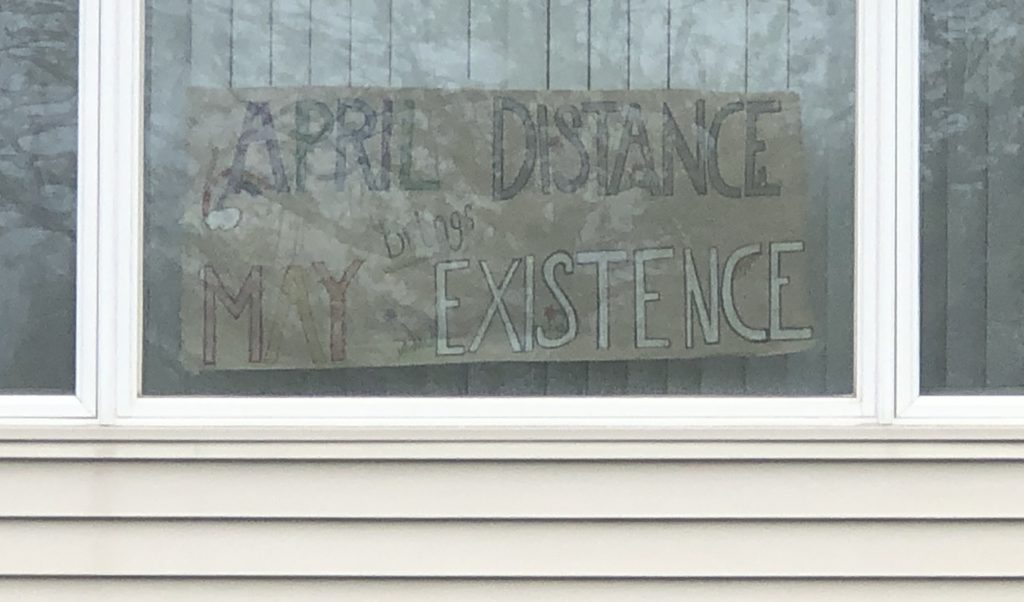
Pictured: A household in Commack encourages social distancing to passersby with a sign that reads “April Distance Brings May Existence.” (Photo Credit: Arielle Murdocco/The Foggiest Idea)
Effective 8 PM tonight, all essential businesses in New York must provide employees with a face covering for workers, which employees must wear when they are in direct contact with members of the public. On Wednesday, Cuomo said he will expand the measure through an executive order that says all people in public throughout the state must wear such coverings in situations when they cannot maintain social distancing.
Cuomo said on Wednesday that before the economy can reopen, you must test, trace, and isolate positive cases. While New York State has conducted over 500,000 tests for COVID-19, or roughly 3% of the state’s population. To scale up testing, which the governor said is the next front in battling the virus, Cuomo stressed the need for additional federal support. With emphasis being placed on securing additional capacity for testing, the pressing need for ventilators has waned. As such, the state will be donating units to other hard-hit states.
Moving forward, New York State will prioritize a newly developed antibody test for healthcare workers, first responders and essential workers, but Cuomo stressed that more testing means more economic activity. The goal is to test 100,000 people per day in order to phase the reopening of society as quickly as possible. “It is a very difficult task, and it can’t be done perfectly, but we can do better than we’re doing,” Cuomo added, saying additional clarity is needed in the delineation between the federal and state roles in making this happen.
Before any reopening of businesses proceeds, Cuomo says that policymakers will consider how essential a particular business service is, and what is the risk of infection spread within that business. These considerations will be done concurrently with the expansion of COVID-19 testing capacity.
Nationally, the states hardest-hit by the pandemic are pushing Congress to act to correct stark discrepancies in the distribution of federal relief monies. Under the current funding models, which distribute $30 billion in aid based on former medicare payments and not COVID-19 related impacts, states such as Minnesota, Nebraska and Montana, are getting more than $300,000 per reported COVID-19 case, according to an analysis conducted by Kaiser Health News. New York, the epicenter of the crisis, would receive only $12,000 per case. Another hard-hit state, Florida, is getting $132,000 per case.
Economic indicators continue to set new benchmarks in decline. In March, domestic retail sales posted their largest drop on record in the wake of shutdowns and stay-at-home orders. That month, retail sales, which measures purchases at stores, restaurants and online, decreased a seasonally adjusted 8.7%, the biggest month-to-month decline since the U.S. Commerce Department began keeping records in 1992. Economists say that consumer spending is the main driver of the U.S. economy, accounting for more than two-thirds of overall economic output. Additional economic stimulus checks, expected to help ease spending gluts, are scheduled to appear on April 22nd, and April 29th.
Across the globe, oil demand is expected to fall by a record 9.3 million barrels a day this year, to levels not seen in a quarter of a century. Locally, gas station operators have seen demand drop by nearly 70% at over 900 stations in Nassau and Suffolk counties. For the first time in years, gas prices in the region have dropped below $2.00 per gallon.
UPDATE AS OF 12:30 PM, TUESDAY, APRIL 14TH, 2020:
In unprecedentedly sweeping action, the governors of seven states in the northeast have joined together to craft a comprehensive plan to eventually reopen the economy. Similar action is being taken on the west coast as well.
The governors of New York, New Jersey, Connecticut, Massachusetts, Pennsylvania, Delaware and Rhode Island are creating a working group of health and economic experts, who will work with government officials from each state to develop a regional plan. Out west, California, Oregon, and Washington are taking a similar approach with what they’re calling a “Western States Pact.” Their work begins today, but there is no firm timeline for when economies will reopen. Across all industries, business leaders expect that a return to normalcy in the the coming weeks and months will be fitful, fragile, and partial.
During a briefing Tuesday, New York Governor Andrew Cuomo said that 778 have died within the latest 24-hour period. “It’s basically flat at a devastating level,” he said. The statewide death total is 10,834.
“What we have learned through this process is that our actions determine our destiny,” Cuomo said. “We changed the curve. Every projection had a higher rate of infection, higher rate of death. That didn’t happen. Why didn’t it happen? Because of what we did.” Calling it a total cause and effect, Cuomo says that changing behaviors will impact the key metrics. “In this reopening, we can lose all the progress we’ve made if we do it wrong,” the governor added, stressing the need for unity across all governmental levels.
Yesterday, President Trump claimed he had “total authority” to restart the economy, and took to Twitter to express his displeasure about the role of states and Cuomo’s performance in a series of tweets, comparing the situation with various states to the 1962 film “Mutiny on the Bounty.”
On Long Island, there have been significantly higher numbers of COVID-19 related deaths in nursing homes and assisted living facilities compared to the rest of the state. Throughout New York, nearly a quarter of the state’s fatalities have been within such facilities. Meanwhile, roughly 64% of those hospitalized with COVID-19 are in New York City. Long Island is home to 22% of the state total.
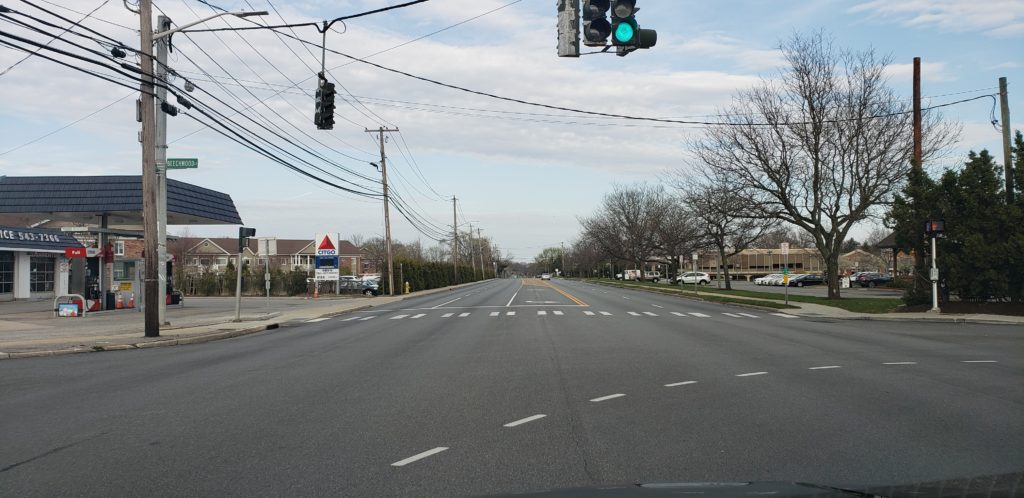
Pictured: Jericho Turnpike in Commack sits empty on Easter Sunday, as Long Islanders maintained social distancing measures during the coronavirus pandemic. (Photo Credit – Richard Murdocco/The Foggiest Idea)
The economic toll has been taxing as well in the suburbs, as over 100,000 Long Islanders have filed for unemployment benefits since March 23rd. The Long Island Rail Road, whose workforce has been greatly diminished by the virus, has seen ridership plummet by 97%. The upside? The few LIRR trains running were on-time 95.3% of the time, the highest level the railroad’s seen in eight years.
The fight against COVID-19 has transformed the way many doctors are treating the sickest patients, building on the lessons learned as the number of cases blossomed. By shifting their approach from ventilators to proning, which rolls patients onto their sides or on their bellies with supplemental oxygen, many have seen critical oxygen levels quickly return to normal. “Intubated patients with Covid lung disease are doing very poorly, and while this may be the disease and not the mechanical ventilation, most of us believe that intubation is to be avoided until unequivocally required,” Dr. Reuben Strayer, an emergency medicine physician at Maimonides Medical Center in Brooklyn, told the New York Times late Monday.
Grocers are bracing for supply shortages nationwide as the coronavirus spreads throughout processing plants throughout the Midwest and grocery stores throughout the country. The spread of coronavirus throughout the food industry is expected to cause disruptions in the production and distribution of certain products like pork, industry experts recently warned. However, they stress that there still is plenty of food available, just not in the typical variety consumers are typically used to.
“You might not get what you want when you want it,” said Christine McCracken, a meat industry analyst, told the Times on Monday. “Consumers like to have a lot of different choices, and the reality is in the short term, we just don’t have the labor to make that happen.” Demand for groceries has doubled in recent weeks, employees say, as Americans avoid restaurants and prepare most of their meals at home.
UPDATE AS OF 12:15 PM, MONDAY, APRIL 13TH, 2020:
New York’s death rate from COVID-19 has slightly declined, with the total number of deaths reaching 10,056 statewide as of Monday. Despite the hundreds who continue to die each day, other trends such as the rates of hospitalization are now suggesting that the spread of the virus had slowed.
“Here’s the good news, the curve continues to flatten,” New York State Governor Andrew Cuomo said during a briefing from Albany Monday. Still, the death toll continues to climb. On Easter Sunday alone, 671 people died statewide, a figure which Cuomo called “horrific.”
On Monday, Cuomo announced an economic Reopening Plan that is regional by design, and coordinated in it’s implementation. The plan will be designed by public health and economic experts. “You’ll start to open that valve on the economic activity,” he said. “Do it carefully, do it slowly and do it intelligently.” Cuomo plans on making a larger announcement with other governors from nearby states about reopening the economy later Monday.
To Cuomo, those looking for a final resolution with the coronavirus pandemic won’t get it. “There is going to be no morning where the headline says ‘Hallelujah it’s over,'” Cuomo said. “There will be points of resolution over time,” Cuomo added, calling any actions taken incremental. “We have controlled the spread, and there is confidence to be taken in that.” When there is a vaccine, that’s when the threat of the virus is over, he stressed.
Across Long Island, COVID-19 testing sites have been closed due to the threat of severe weather, as gusts up to 70 MPH and heavy thunderstorms are expected to blanket the area all day Monday. Those recovering from COVID-19 are being encouraged to donate their plasma for clinical treatment trials at both Stony Brook University and the Feinstein Institutes for Medical Research. The plasma treatments can help stop the infection in the critically ill.
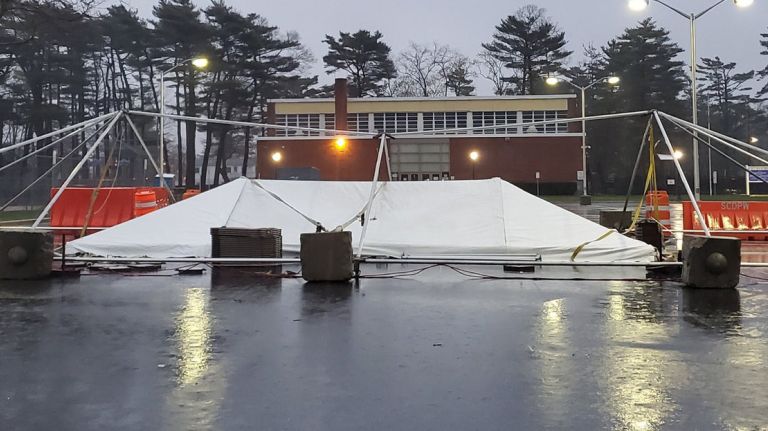
Pictured: Construction on a new coronavirus testing site in Brentwood sits idle on Monday, as stormy weather delays the site’s opening. (Photo Credit – James Carbone/Newsday)
Residents of New York City witnessed a lesson in intergovernmental affairs over the weekend as Mayor Bill de Blasio and New York State Governor Andrew Cuomo grappled with the question of the timeline for reopening New York City schools. The mayor made the decision late Friday evening after speaking with Dr. Anthony Fauci, director of the National Institute of Allergy and Infectious Diseases, but did not reach out to the governor until Saturday morning, minutes before his public announcement. After not being able to get through to to the governor via telephone to inform him of the decision, the mayor sent a text message.
“That’s his opinion, but he didn’t close them and he can’t open them,” Cuomo said of the mayor’s actions later on, adding that all closures were enacted on a metropolitan basis. Moving forward, the governor says he wants to coordinate any such measures across the region. “All of these things have to be coordinated, and have to be coordinated on a statewide basis.” the governor elaborated Monday. “We have to have one plan at the end of the day. This virus doesn’t understand school district boundaries.”
Nationally, the first wave of federal stimulus checks have begun to hit taxpayer accounts, with the automated funds transfers expected to be deposited by Wednesday. Individual taxpayers can receive up to $1,200, while joint-filers can get up to $2,400 if income requirements are met.
The question when social isolation measures should be relaxed continues to weigh on the minds of health officials and political leaders, all of whom continue to express caution about reopening the economy by May 1st, a date being targeted by the Trump administration. The debate about reopening focuses on several data points, including the number of new coronavirus infections, current death counts, the number of admissions to hospital ICUs, as well as the number of patients on ventilators.
Actions taken in western states to slow the virus’ spread have earned praise by epidemiologists, as the mounting costs of delayed stay-at-home actions in areas such as New York are beginning to be better understood.
“California and the Bay Area response is impressive because it was done before there were obvious and tangible risks,” Dr. Robert Wachter at the University of California, said. “New York acted in a more predictable way.” As of Saturday, New York State had 44 deaths per 100,000 people from COVID-19, while California had two.
On Sunday, the New York Times published a report that found that President Trump’s response to the virus was stymied by internal divisions, lack of planning and his faith in his own instincts. Warnings to the administration were made as the coronavirus first emerged late last year. “Any way you cut it, this is going to be bad,” Dr. Carter Mecher, a senior medical adviser at the Department of Veterans Affairs, wrote to colleagues on January 28th. “The projected size of the outbreak already seems hard to believe.”
In response to supply shortages, the federal government has taken to playing what they call a “backup role” in the distribution of supplies. Elected officials and experts told the Washington Post that the result of the federal stance is a patchwork scramble for goods that pits states against each other, against other countries, as well as the federal government itself.
UPDATE AS OF 12:30 PM, FRIDAY, APRIL 10TH, 2020:
The number of dead from the coronavirus has become so large that New York City is now resorting to burying up to 25 unclaimed victims a day in plain pine coffins at Hart Island, the nation’s largest public burial ground. The isolated potter’s field sits on a small island off the coast of The Bronx in the Long Island Sound, and is accessible only by boat.
The site has a long, grim history. It once hosted a Civil War prison camp, a colony for tuberculosis patients, and most recently, served the resting place for thousands during the HIV and AIDS epidemic in the 1980’s. As of Thursday, over 5,200 have died in New York City alone, but experts feel that the totals are under-counted.
On Friday, New York State Governor Andrew Cuomo announced that an additional 777 have died from COVID-19 statewide, for a total of 7,844. “The leveling off of the number of lives lost is somewhat hopeful,” Cuomo said. The death toll, far higher than the September 11 attacks, is “beyond my capacity to fully appreciate, to tell you the truth,” Cuomo added.
For the first time, the rate of ICU admissions is a negative number, of which Cuomo gave credit to strict social distancing measures. “You tell me how people behave today and I will tell you infection rate in 2 or 3 days,” he said, saying that collectively we are in control of the virus’ path. The expected hospitalization rate has continued to decline as well. The various field hospitals established in the past few weeks will remain as a resource for overflow capacity as needed, Cuomo said. Initially, projections of the pandemic had said over 100,000 hospital beds would be necessary.
Before things return to normal, Cuomo stressed that mass testing will be required at a scale previously unseen.”It’s going to be reliant on testing, testing of antibodies, testing for diagnostic results. Testing on a scale that we have not done before,” he said, calling on the federal government to evoke the Defense Production Act in order to manufacture the needed COVID-19 tests. “I don’t want to repeat what we just went through this past month,” he said, urging state and federal policymakers to look at what has worked in other countries and what hasn’t. “We know the questions, and should have the questions answered before we move forward. What we do will literally affect life or death,” Cuomo urged.
On Friday, Cuomo called for a compensation fund for all essential workers, including health care and first responders, and all golf courses and boat launches have been shut statewide. In responsive to the deluge of callers seeking unemployment benefits, the New York State Department of Labor has released a streamlined application late Thursday night. The new system has fewer questions, and will no longer require applicants to speak with a representative.
Long Island has emerged as one of the prominent coronavirus hot spots in the world, with the total number of positively identified cases in Nassau and Suffolk counties surpassing reported numbers from Brazil, Russia, and South Korea. Early Friday, there were nearly 40,000 total cases on Long Island. “We appear to be at a plateau at this moment,but that plateau is at a very high crisis point” Nassau County Executive Laura Curran said during a briefing on Thursday.
In the United States, the number of deaths from the coronavirus pandemic surpassed that of Spain’s, placing the country second to only hard-hit Italy. Despite the economic havoc and record number of jobless claims, markets soared on Thursday to post their biggest week of gains since 1974. Overall, stocks remain down around 17% since February. In observance of Good Friday, markets in the United States are closed.
Nationally, the U.S. Postal Service has seen steep declines in mail volume and billions of dollars in losses. Hundreds of postal workers have fallen sick, and a dozen have died from the coronavirus.
For small business owners, the $350 billion Payroll Protection Program can’t come soon enough, as the first wave of applicants are still waiting for funding. The program was opened one week ago with loans to companies with 500 or fewer employees, and has been expanded to include independent contractors and self-employed individuals. Congress is currently debating adding another $250 billion to the program.
If the skies have been quieter these recent weeks, it’s because domestic air travel has plunged 96%, to lows not seen in nearly 60 years. Across Long Island, local girl scouts are feeling the economic pain as well, as officials within the organization say they still need to sell more than 273,000 boxes of cookies to meet their annual sales goals.
UPDATE AS OF 12:15 PM, THURSDAY, APRIL 9TH, 2020:
On Thursday, the U.S. Labor Department reported that an additional 6.6 million people filed for unemployment benefits last week, bringing the total number of Americans who have lost their jobs to more than 16 million. Economists now say that the unemployment rate in the United States is around 12 or 13 percent, the worst since the Great Depression.
The staggering unemployment figures represent more job losses in three weeks than the most recent recession produced over a period of two years. One economic bright spot during the pandemic is Amazon, as the tech giant looks to hire an additional 100,000 employees for it’s sprawling warehouse operations.
New York State saw it’s deadliest day yet, with 799 deaths within the last 24-hours. In total, there have been 7,067 coronavirus deaths, New York State Governor Andrew Cuomo said Thursday. Cuomo added the death totals are so high, the state is bringing in additional funeral directors to handle the influx. In total, it’s been 80 days since the first COVID case was identified in the U.S.
Overall, the hospitalization and intubations rates has reached their lowest points in weeks. “The current trend, if it continues, we’re at about 18,000 people hospitalized,” Cuomo said, noting that due to hospital capacity-building taken in recent weeks, there are 90,000 hospital beds statewide. “We’re flattening the curve so far. This is all a direct consequence to our actions,” he added, saying that New York cannot handle the worst case scenarios for hospital demand. “We don’t have the option of handling the curve if it goes higher.”
The governor said that significant federal money is needed to address the fiscal shortfalls states hardest-hit by the virus face.”This is no time for politics, this is a time to enact the legislation that actually addresses the need,” Cuomo told senators. State policymakers who crafted New York’s budget estimate that the most recent federal legislation passed by Congress awarded only $1.3 billion in federal funding, after initially projecting $6 billion in relief. In total, the revenue shortfall currently faced by New York State ranges anywhere from $10 to $15 billion.
Research across two separate distinct studies is showing that the coronavirus likely first emerged in the New York area by mid-February, weeks before the first confirmed case was identified. In addition, data suggests that travelers brought it mainly from Europe, not Asia, as first previously thought. The two separate studies of the pandemic’s initial spread reached the same conclusion by analyzing the unique genetic footprints of the virus. Experts also now think that COVID-19 isn’t killing it’s victims, but rather, what’s taking their lives is a hyperactive immune response that triggers a series of fatal events.
In New York City, communities in Queens have bore coronavirus’ brunt the hardest, especially areas including Corona, Elmhurst, East Elmhurst and Jackson Heights. Mayor Bill de Blasio announced on Thursday that for the first time, coronavirus data will be reported in real-time and made available to the public online. Cuomo also said Thursday that the state will be opening new COVID-19 testing centers throughout New York City.
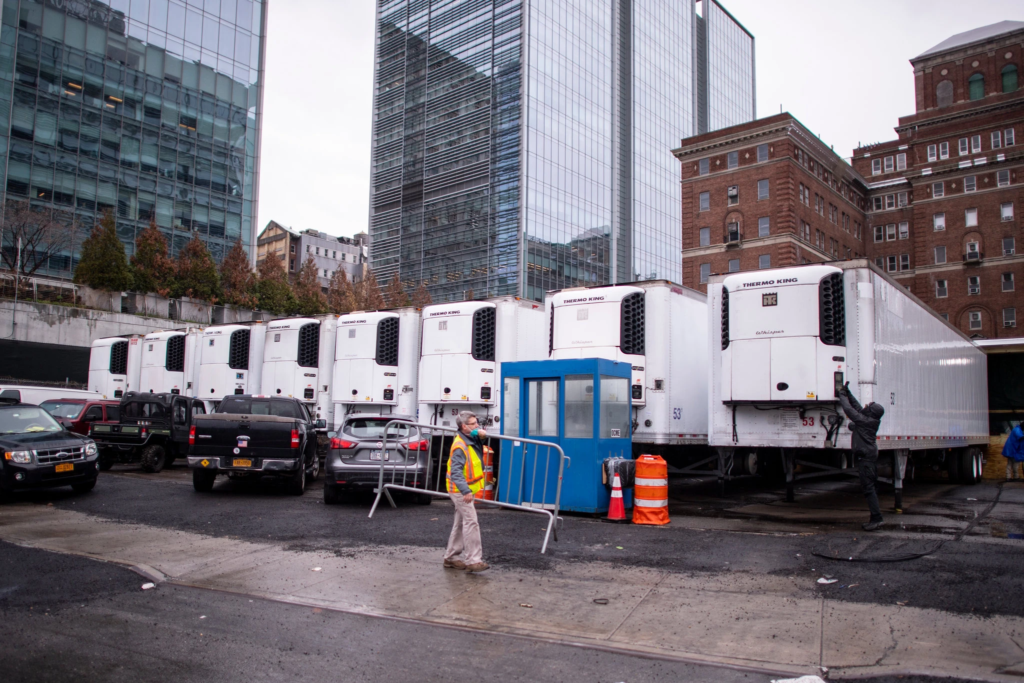
Pictured: Refrigeration trucks act as a makeshift morgue outside of Bellevue Hospital in New York City’s as mortuaries are filled to capacity. (Photo Credit – Gregg Vigliotti/The New York Times)
Despite an ever-increasing surge of COVID-19 patients, Long Island’s hospitals are currently managing the influx caseloads, but experts say that the heath care system is nearing capacity. “We haven’t seen the apex yet,” Jayme Meliker, an epidemiologist at Stony Brook University, told Newsday, saying the situation is likely to get worse in the coming days. “I believe that we didn’t lose anyone that we could have saved,” Cuomo said of the deaths, and that there have been adequate hospital resources available to properly treat those with COVID-19 so far. “That is the only solace when I look at these numbers.”
On Thursday, Cuomo said that numbers continue to climb in Nassau and Suffolk counties, as well as throughout the city’s upstate suburban counties. Across Long Island, grocers are limiting the number of customers they are allowing in stores in addition to the senior-exclusive shopping hours many chains implemented in recent weeks.
As the coronavirus continues to transform the way people live across the country, an old standby has made a comeback – the old fashioned phone call. Verizon told the New York Times late Wednesday that the telecommunications company is now handling an average of 800 million wireless calls a day. This is more than double the calls made on one of the busiest call days of the year, Mother’s Day. In contrast, the industry has found that internet traffic is up only 20 to 25 percent from typical daily usage patterns.
UPDATE AS OF 1:00 PM, WEDNESDAY, APRIL 8TH, 2020:
Across New York State, positively-identified coronavirus cases have surpassed 139,000, and as of Wednesday, COVID-19 has killed 6,268 statewide. New York State Governor Andrew Cuomo said that while the curve is flattening, the number of deaths continues to grow. So far, the state has been under social distancing orders for 37 days.
There have been 779 deaths within the past 24 hours, the highest figure yet. “The number of deaths will continue to rise as those hospitalized for a longer period of time pass away,” Cuomo said, going on to call the virus a “vicious predator” that attacked the vulnerable and the weak. To honor the dead, flags in New York will be flown at half-mast.
“That curve is purely a function of what we do day in, and day out,” Cuomo said. Overall hospital capacity, buttressed in recent weeks by field facilities at locations such as the Javits Center in Manhattan and at Stony Brook University, has been increased by 50%. Overall, the rate of hospitalizations in New York are down. “The system should stabilize over these next couple of weeks,” Cuomo said. “That’s if we continue doing what we’re doing,” Cuomo cautioned. “If we behave differently, you will see those numbers change,” Cuomo later added, stressing that now is the time for diligence about preventing COVID-19’s spread.
In New York City, Broadway is expected to remain closed through at least June 7th, and the FDNY is reporting that nearly 1,300 firefighters are back on the job after battling COVID-19. “I wouldn’t use what Broadway thinks as a barometer of anything,” Cuomo said when asked if others should follow Broadway’s lead. “We extended everything until April 29th, even that’s a projection.”
On Long Island, Newsday has found that the virus is hitting the hardest in Hispanic communities across Nassau and Suffolk counties, including areas such as Brentwood, Central Islip, and New Cassel. As testing for COVID-19 surpasses 60,000 island-wide, doctors have found that 45% of the tests came back positive. Officials stress to take reported numbers with a grain of salt, since many New Yorkers with symptoms of COVID-19 cannot get tested. “Much better is the fact that the hospitalizations seem to be going down,” Robyn Gershon, a clinicial professor of epidemiology at NYU, told Newsday.
While the total number of deaths being reported is alarming, the figures may not be capturing the true extent of the ghastly toll the virus is exacting. According to hospital officials, doctors, public health experts and medical examiners, official counts are not capturing the true number of COVID-19 related deaths due to inconsistent protocols and a lack of availability for postmortem tests.
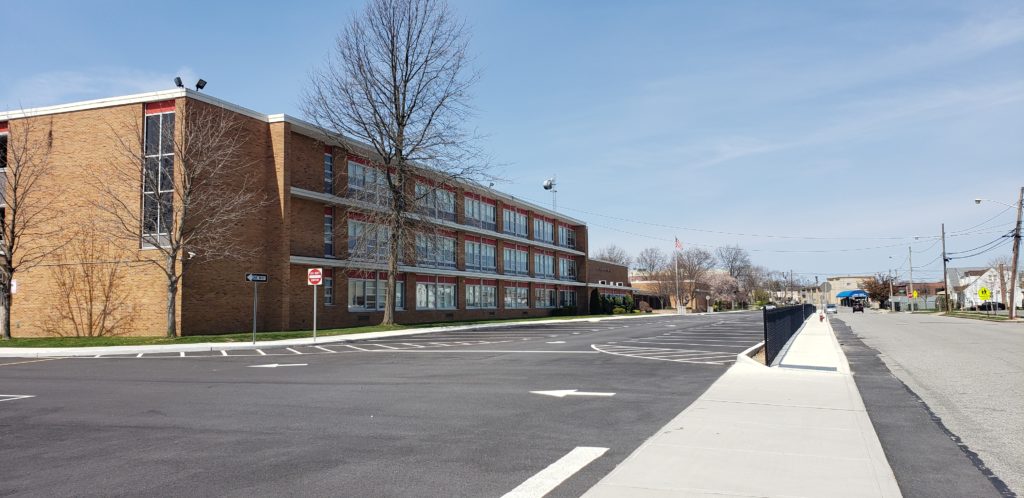
Pictured: Mineola High School sits empty on what would have been a school day Tuesday, as schools throughout New York State are expected to remain closed through at least April 29th. (Photo Credit – Richard Murdocco/The Foggiest Idea)
Still, as projections expect the virus to slow in the coming days, policymakers are beginning to think about what will be necessary to eventually restart the national economy.
Economists currently estimate that consumer spending has dropped roughly 50% since the outbreak first began. “It isn’t like a light switch on and off,” Dr. Anthony Fauci, director of the National Institute of Allergy and Infectious Diseases, said in an interview with a Wall Street Journal podcast on Tuesday. “It’s a gradual pulling back on certain of the restrictions to try and get society a bit back to normal.”
Data shows the hardest-hit workers during the pandemic have been those with a high school degree or less, while estimates from the St Louis Federal Reserve suggest that the unemployment rate could exceed the peak that was reached during the Great Depression. In New York State, those on unemployment will get an additional $600 payment.
Dr. Fauci said that there must collectively be a steep drop in the number of coronavirus cases. “You’ve got to make sure you are absolutely going in the right direction.” Then, he said, “you gradually come back. You don’t jump into it with both feet.”
Nationally, the Food and Drug Administration is stressing that the country’s food supply remains robust, and seeks to temper fears about the virus’ transmission through food and it’s packaging. “In terms of the food packaging itself, it’s very unlikely that the food packaging is going to be contaminated at a level that could be an indicator of transmission,” according to Frank Yiannas, the FDA’s Deputy Commissioner for Food Policy and Response, told the Washington Post on Tuesday.
“If you feel so inclined, you can sanitize the exterior of the package and let it air dry but it’s not a practice I personally adhere to,” Yiannas said. “I’m much more interested in hand washing and social distancing.”
UPDATE AS OF 11:45 AM, TUESDAY, APRIL 7TH, 2020:
On Tuesday, New York State Governor Andrew Cuomo said that there have been 5,489 deaths from coronavirus throughout New York State. Nationally, nearly 11,700 have died. With 731 deaths over a 24-hour period, April 6th was the deadliest day for the state since the outbreak first began. Throughout the state, there have been 138,836 identified cases, and both hospitalizations and the number of patients placed within intensive care units have continued to decline.
Even with the expected slow down of the pandemic’s spread, policymakers expect that thousands more will die before the outbreak comes to an end. Even worse, if social distancing rules are relaxed too early, the spread could one again accelerate.
“What we do affects the number of cases,” Cuomo said during a briefing Tuesday, citing the 1918 Spanish Flu pandemic, which saw a six month peak where a total of 30,000 people died within New York alone. “Social distancing is working. That’s why you see the number of cases going down. To the extent we see a flattening or a possible plateau, but we have to keep doing it. It takes an effort.”
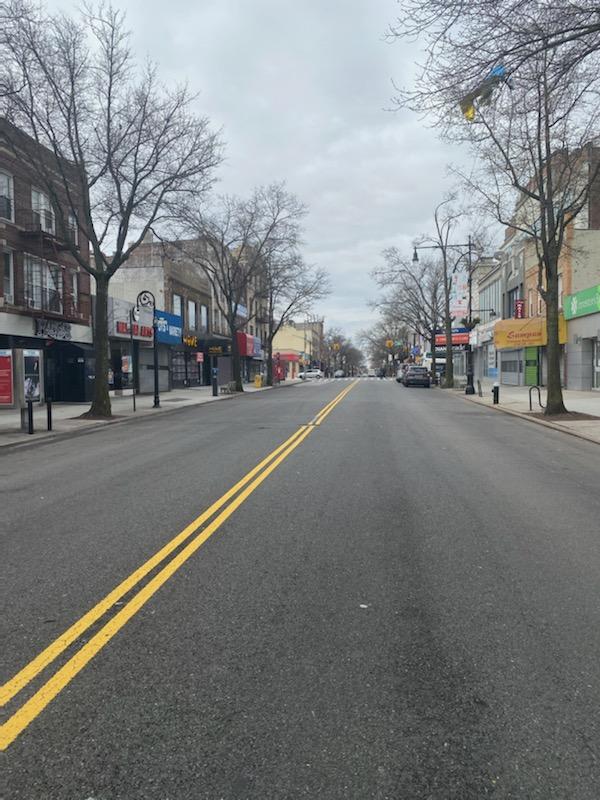
Pictured: An usually empty Steinway Street in Astoria. Queens has been home to some of the hardest-hit areas by the coronavirus throughout New York City. (Photo Credit – Caitlin A. Harley/Freelance)
Cuomo, noting that he’s been in contact with the governors of both Connecticut and New Jersey, said that while vigilance must remain, now is the time to start preparing for the eventual restart of life. “When we get to that point, how do we restart our economy and get everything up and running as quickly as possible?” Cuomo asked rhetorically, adding that when the tri-state region eventually is ready for a return to normalcy, the availability of testing will be a key indicator as to when that can happen.
Even as the march of the coronavirus slows in New York City, Long Island is continuing to see a rapid acceleration of cases. Suffolk County now has a higher rate of infection than New York City, with nearly 1,000 confirmed cases per 100,000 residents. The city has 815 confirmed cases per 100,000 residents. “I’ve said we are seven to 14 days behind what’s happening in New York City, but we can really see it in the numbers every day,” Suffolk County Executive Steve Bellone said during a television interview Tuesday.
Across the region, the mortuary system remains taxed as the system struggles to handle the surge of deaths from the virus. For example, Long Island had 52 coronavirus deaths on Friday, while the suburbs typically see 61 deaths from all causes per day. To shore up morgue capacity, refrigerated trucks have been brought into both Nassau and Suffolk counties, and the City of New York is allowing crematoria to operate 24 hours a day, seven days a week. There are four crematoria in New York City, and four on Long Island, all within Suffolk County.
Nationally, the primary forecasting model being used by the White House to chart the course of the pandemic now suggests that the country may potentially need fewer hospital beds and ventilators than previously projected. The model also forecasts that some states may reach the peak of the crisis sooner than expected. Surgeon General Jerome Adams said Tuesday morning that due to mitigation measures being taken, deaths in the United States could fall under the range of 100,000 to 240,000.
“That’s absolutely my expectation, and I feel a lot more optimistic again because I’m seeing mitigation work,” Adams said of Washington and California’s efforts during his appearance on the ABC morning show Good Morning America. “Public health officials should be applauded because they’ve given us the blueprint for how we should deal with this in the rest of the country. And I really do believe we will come in under those projections as long as we can continue to do our part for 30 days.”
On Tuesday, the New York Times reported that Peter Navarro, a White House trade adviser, first warned officials within the Trump Administration in late January that the coronavirus could cost the United States trillions of dollars and put millions of Americans at risk of illness or death.
“The lack of immune protection or an existing cure or vaccine would leave Americans defenseless in the case of a full-blown coronavirus outbreak on U.S. soil,” Navarro wrote. “This lack of protection elevates the risk of the coronavirus evolving into a full-blown pandemic, imperiling the lives of millions of Americans.”
According to a new report released by the Centers for Disease Control on Monday, relatively few children have been hospitalized from COVID-19. However, the report notes that children can play a key role in the spread of the virus. “Asymptomatic transmission occurs in maybe 10 to 20% of cases,” Dr. Aaron Glatt, the chief of infectious diseases at Mount Sinai South Nassau Hospital told Newsday.
To better understand why the virus hits hardest in some but not others, scientists around the world are pooling their knowledge to see whether or not genetic variations make people more susceptible. In the past, prior research indicates that some gene variants can render people a higher risk for infections.
UPDATE AS OF 12:45 PM, MONDAY, APRIL 6TH, 2020:
On Monday, New York State Governor Andrew Cuomo said the state had a total of 130,000 positively identified cases, with Long Island accounting for nearly 29,000 cases across Nassau and Suffolk Counties. The death toll statewide stands at 4,758 as of Monday. While fewer new cases are being reported throughout New York City, the number of COVID-19 cases have surged in Nassau and Suffolk counties.
While the number of coronavirus cases continues to climb, New York State officials feel that there may be signs of hope. Over the weekend, the one-day death toll has fallen, while simultaneously, the rate of hospitalizations state-wide have slowed. In the past two weeks, both metrics have showcased the rapid spread of COVID-19 across downstate counties.
To help track emerging viral hotspots, the state has launched a COVID-19 tracker, complete with regularly updated county-by-county information on confirmed cases. You can access the tracker here.
“The possible flattening of the curve is better than the increases we’ve seen,” Cuomo said Monday, noting that the total number of hospitalizations, cases in intensive care units, and intubations have been down as well. The state’s initial projections had estimated a need for 110,000 hospital beds to treat COVID-19, but latest data now suggest a lower bed need of 55,000. “It is hopeful, but it’s also inconclusive. It also depends on what we do,” Cuomo added, stressing the importance of social distancing. “If we are plateauing, we are plateauing at a very high level.”
Cuomo said that non-essential businesses and schools in New York State will remain closed until April 29th. “Public health still demands that we remain on pause,” Cuomo said. “Frankly, there has been a laxness on social distancing that is just wholly unacceptable,” the governor added over displays of images of crowded public spaces across New York City. Due to lack of social distancing, the potential fine is now upped from $500 to $1,000. To help ease pressure on the hospital system, Cuomo will be asking the federal government to ensure that the USNS Comfort can accommodate COVID-19 patients.
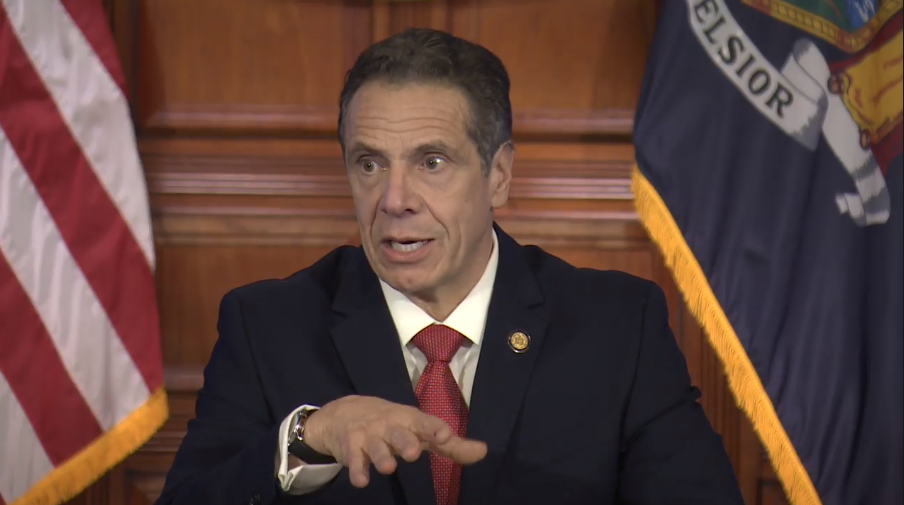
Pictured: New York State Governor Andrew Cuomo addresses the public in Albany on Monday, saying that while the pandemic may be hitting it’s apex soon, it’s critical that social distancing measures remain in place. (Photo Credit – NYS Governor’s Office)
On Sunday, the federal government pledged to send 600,000 N95 masks to New York City, and 200,000 to Suffolk County. “Long Island now has become a hot spot, part of New York. We’re sending a lot of things, a lot of supplies, ” President Trump said Sunday. “Suffolk County is really at the center of the fight against coronavirus now. We have more cases here than just about any other state in the country,” Suffolk County Executive Steve Bellone said during an interview on Fox & Friends Monday.
While signs of optimism are emerging, the weeks ahead are expected to be some of the toughest as new forecasting shows that the crisis will likely reach it’s peak throughout the hardest-hit cities in the country. Areas expected to see a surge in new cases include New York, Detroit, and New Orleans. As the virus hits it’s peak in the region, experts are urging the public to curtail unnecessary trips to further reduce exposure.
The Wall Street Journal has found that the domestic economy is essentially crippled, as lockdown orders are in place for eight in 10 U.S. counties. These counties under lockdown represent nearly 96% of the nation’s economic output.
Nationwide, an internal report from the federal government found that hospitals are facing shortages of COVID-19 testing supplies, personal protective equipment, ventilators and staff. The watchdog report noted that inconsistent guidance from local, state, and federal authorities also have muddied the hospital’s ability to respond to the crisis, amplifying the shortages.
On Monday, The New York Times featured a report written by heath and policy experts that outlined what would need to be in-place before life can return to normal. The report, authored in late March that by health and public policy experts, can be read here. In summary, their criteria was as follows:
- Hospitals in the state must be able to safely treat all patients requiring hospitalization, without resorting to crisis standards of care.
- A state needs to be able to test at least everyone who has symptoms.
- The state is able to conduct monitoring of confirmed cases and contacts.
- There must be a sustained reduction in cases for at least 14 days.
UPDATE AS OF 12:00 PM, FRIDAY, APRIL 3RD, 2020:
Globally, the number of coronavirus cases has soared past the one million mark, showcasing how widespread the virus has become since first being discovered in December. Over half the world’s population is currently under stay-at-home orders, and domestically, the daily fatality rate in the United States has eclipsed the average daily fatality rate of both heart disease and cancer.
In New York State, the number of positively identified cases continues to multiply, with positive cases surging past 102,000, and deaths are over 2,900. Coronavirus hotspots continue to emerge throughout both New York City and on Long Island. Of this total, 57,000 cases are within New York City, and Long Island collectively has over 22,000 cases.
“We don’t have the same amount of resources on Long Island,” New York State Governor Andrew Cuomo said during a briefing from Albany on Friday. “And that has us very concerned.” In the last 24 hours, the increase in deaths related to COVID-19 in the region was the single largest jump since the pandemic first started.
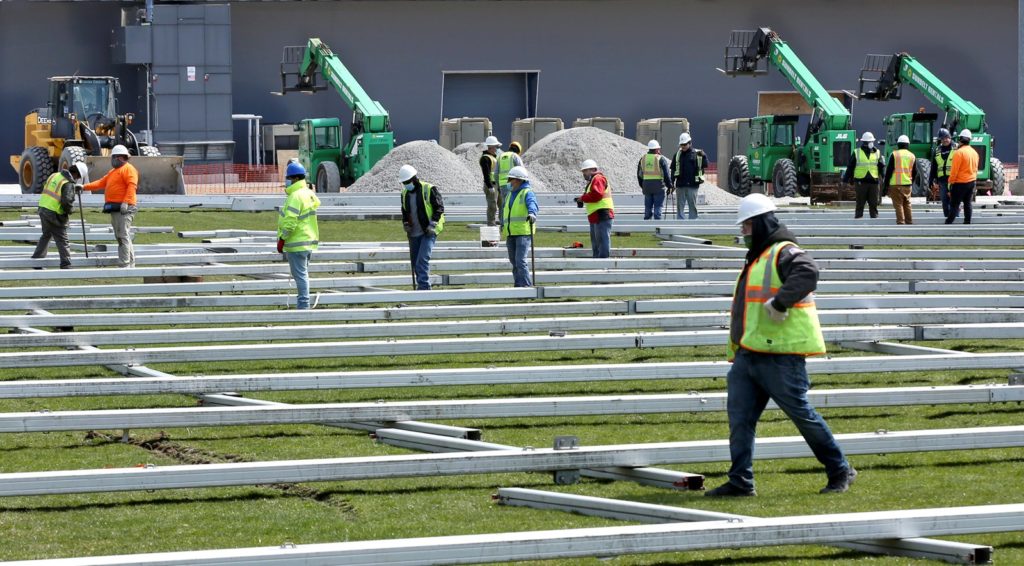
Pictured: Workers rush to build a 1,000 bed field hospital on the campus of Stony Brook University. The facility is expected to be open on April 19th. (Photo Credit – John Paraskevas/Newsday)
According to an analysis of coronavirus infection rates conducted by Newsday, the Long Island region has an infection rate of roughly 680 per every 100,000. The figure is 11% higher than New York City’s infection rate, but the elevated rates may be a reflection of better testing – over 31% more testing has occurred in Nassau and Suffolk Counties.
In a reversal of course, the supplemental field hospital at the Javits Convention Center in Manhattan will now be used for COVID-19 patients, Cuomo announced Friday. Similar to the other field hospitals being set up across the downstate region, the Javits location was originally intended to treat COVID-related illnesses, saving capacity at other hospitals that are being overwhelmed. Shortages of personal protective equipment and ventilators persist in hospitals across the downstate region.
Across Long Island, towns are closing local parks and playgrounds because residents are not following social distancing guidelines, which require people to stay at least six feet away from one another. In Brookhaven, the physically largest town on Long Island, parks and playgrounds have been closed at least a week, while the City of Long Beach had closed it’s boardwalk on March 26th. In the Town of Babylon, parks remain open as of writing, but common areas such as basketball courts and the skate park in Copiague are closed.
While testing in the Nassau/Suffolk region has accelerated, demand continues to overwhelm supply. Long lines of cars swamped the streets around AFC Urgent Care locations in East Meadow, Farmingdale, West Islip, where a new rapid, same-day test for COVID-19 is being conducted.
On Friday, Cuomo said he is going to sign an executive order that takes ventilators and personal protective equipment from hospitals and other institutions that don’t immediately need them now and redistribute them to hospitals that do. “I can’t do anything more than that,” he said, adding that equipment will either be returned or the New York will reimburse facilities.
“When our curve is over, New Yorkers are going to take what we’ve amassed, and go to any community that needs help,” Cuomo said. “Systematize that volunteerism. That’s how we beat the damn virus as it marches across the country,” Cuomo said emphatically. “At this time when we’re dealing with our worst, let’s deploy America at it’s best.”
President Trump said Thursday evening that he signed the Defense Production Act in order to compel St. Paul, Minnesota-based 3M to produce more N95 face masks for health care workers. The Defense Production Act is a Korean War-era law that grants a broad set of executive authorities to ensure that domestic industry can meet national defense requirement. The DPA has been authorized by the executive branch 50 times since first being drafted.
Public health officials will be partnering with Google to use the company’s data to track people’s movement amid the coronavirus pandemic. The initiative, introduced by the company late Thursday, will information collected on users to create reports the tech giant calls “mobility reports” that highlight which counties are abiding by social-distancing measures.
The $349 billion Paycheck Protection Program, tucked within the broader $2 trillion federal CARES act that was recently passed by Congress, has had a rocky start as some of the biggest banks in the country aren’t yet ready to handle the expected deluge of applications from prospective borrowers. Further complicating matters is the fact that details of the program are ill-defined, complicating efforts by lenders to prepare.
In New York, 369,025 unemployment insurance claims were filed last week with the state’s department of labor, an increase of 2,674% compared to last year. Claims have increased by more than 1,000% in each of New York’s labor markets year over year, according to a department release issued Friday.
Nationwide, dairy farmers have taken to dumping their surplus milk, as demand for dairy products, which is typically sold to schools and food service firms, has dried up due to the ongoing pandemic. “We thought this would never happen,” dairy farmer Ryan Elbe told the Associated Press. Elbe’s farm in Wisconsin is dumping around 30,000 gallons of milk a day.
UPDATE AS OF 12:30 PM, THURSDAY, APRIL 2ND, 2020:
On Thursday, the Labor Department said that more than 6.6 million people had filed new claims for unemployment benefits last week.
When added to the 3.3 million claims for the week ending March 21st, a total of almost 10 million people have filed for unemployment benefits in two weeks, with economists estimating that unemployment rates are likely around 10%. Overall, more people filed for unemployed claims than during the first six months of the Great Recession.
New York State has tested over 238,000 individuals, with over 92,000 positively identified cases. Speaking during a briefing from Albany on Thursday, New York State governor Andrew Cuomo said that spikes in positive cases throughout Westchester and Nassau Counties are “troubling.”
“It is a false comfort to say we are a rural community, we don’t have the density of New York City,” Cuomo said. “We have counties in New York State where we have more cows than people.” Statewide, there have been over 2,700 deaths. “In many ways, New York State is a microcosm for the rest of the United states,” Cuomo added.
In New York City, officials created 45 new mobile morgues to accommodate the growing number of dead. Regularly, the medical examiner’s office has room for up to 900 bodies across five facilities within the city. The new mobile units boosts the city’s capacity to handle around 3,500 bodies, and another 85 mobile units are en-route from the Federal Emergency Management Agency.
“When you overwhelm the health system, you also overwhelm the death system,” Patrick Kearns, a funeral director who operates funeral homes in both Queens and Long Island, said to the New York Times.
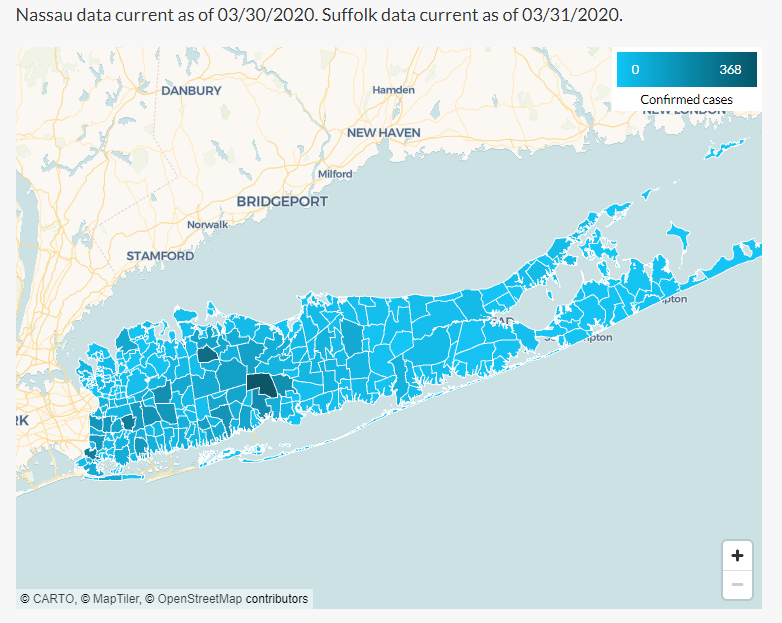
Pictured: A Newsday map that shows coronavirus cases across Long Island, as of the end of March. Overall, the most cases are found in denser communities. (Photo Credit – Newsday)
“The challenge is still at the apex. That’s what this has been still about,” Cuomo said Thursday, mentioning that modeling shows the peak coming anywhere from 7 to 30 days, depending on how effective social distancing is. Cuomo said that the state expects the apex to come on the shorter end of the projected spectrum.
To further prepare, new hospitals are now being built at the Brooklyn Cruise terminal and on Staten Island. To help staff the new facilities, 21,000 health care professionals from out-of-state have volunteered their services. “I will never forget how people across this country came to the aid of New Yorkers when they needed it, and I deeply appreciate it,” Cuomo said. The governor also asked companies nationwide to make personal protective gear for the state, saying they will finance any company’s transition to produce, as well as buy the products, going so far to pay a premium.
As of writing, state policymakers estimate there are six days worth of ventilators in their current stockpile. With rising rates in the suburbs, Cuomo expects resources from other hospitals to be redirected to the rising coronavirus hot-spots. “I can say in confidence, we have researched every possibility, every idea, every measure you can possibly take to find ventilators,” Cuomo said.
On Long Island, two field hospitals at Stony Brook University and SUNY Old Westbury are expected to open on April 19th, adding 2,000 additional hospital beds to the overtaxed hospital system. The beds, similar to the additional field hospitals in New York City and the USNS Comfort, will serve non COVID-19 related illnesses.
Across the region, crime rates have plummeted in the wake of stay-at-home orders and social distancing. The NYPD has reported a 41% drop in felonies last week. In Nassau, major crimes since the beginning of March are down 45%. Nassau Police Commissioner Patrick Ryder told Newsday that such a drop is typical during weather events such as a blizzard. In Suffolk County, crime rates have dropped over 29%.
Retired General Stanley McChrystal, the former head of Joint Special Operations Command, told NPR that watching the spread of coronavirus reminded him of the fight against al-Qaida.
“We should not be fighting COVID-19 as 50 separate fights, 50 separate states and territories and certainly not at individual municipal levels. This needs to be a collaborative national-level fight,” he said.
UPDATE AS OF 1:00 PM, WEDNESDAY, APRIL 1ST, 2020:
Both the rate of infection from coronavirus continues to climb across the New York metropolitan region and the death toll continues to mount, but among the grim news is a glimmer of hope – the daily rate-of-infection has slowed. Officials are expecting the apex of the crisis to hit within a week and three weeks before the virus begins to ebb.
In total, over 83,000 positive cases have been identified in New York, and 220,000 COVID-19 tests have been conducted. 1,941 deaths have been reported as of writing. “If you go on a ventilator, there is roughly a 20% chance you will come off,” New York State Governor Andrew Cuomo said during a press briefing in Albany on Wednesday, adding that the rate of hospitalization state-wide has increased to 14.6%.
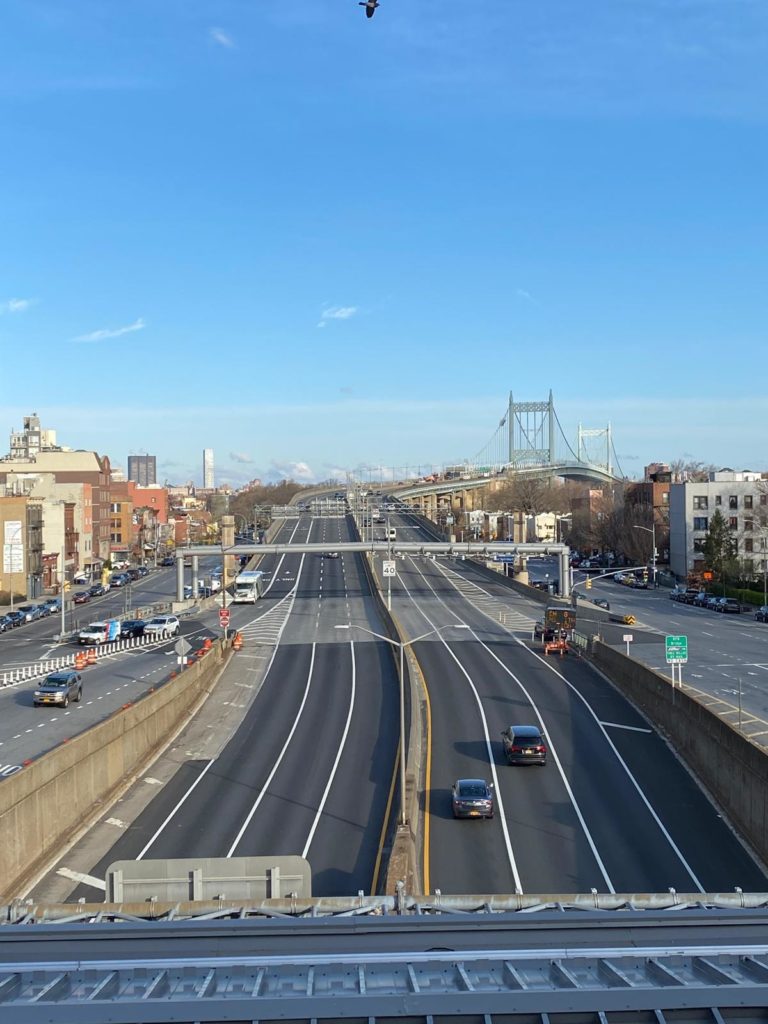
Pictured: The Queens approach to the Triborough/RFK Bridge sits empty during the AM rush Wednesday. Last week, NYS DOT estimated that traffic levels have plummeted over 58% in parts of the region due to the coronavirus pandemic. (Photo Credit – Caitlin A. Harley/Freelance)
The projections being used to shape state policy remain unforgiving.
With high compliance with social-distancing measures from residents, Cuomo said that models forecast that New York will need 75,000 COVID-19 beds and 25,000 ventilators at the apex of the crisis, which is currently expected at the end of April.
Based on the models from the Institute for Health Metrics and Evaluation funded by the Gates Foundation, Cuomo said that 16,000 New Yorkers may die from the coronavirus, with a high death-rate through July. “Look at us today, see yourself tomorrow,” Cuomo told governors of other states. “If you learn how to do it right here, the best we can, then we can work cooperatively all across this country.”
Across New York State, policymakers are grappling with the reality that the virus will continue to swamp resources – but human and economic – for the foreseeable future. In Albany, officials are looking to trim nearly $2 billion from the state budget, putting the spending plan at $173 billion, which Newsday notes is 1.1% lower than last years.
In New York City, the global epicenter of the coronavirus crisis, 500 paramedics and emergency medical technicians, 2,000 nurses and 250 ambulances are heading to New York City to help provide supplemental support to the city’s overburdened medical facilities. A new pop-up field hospital with 68 beds across 14 tents was established in Central Park, with New York City Mayor Bill de Blasio announcing a new 350-bed facility will be established at the U.S.T.A. Billie Jean King National Tennis Center in Flushing. On Wednesday, the governor took action to close all city playgrounds in order to reduce density. Open spaces throughout the city will remain available to the public.
Nationally, the virus continues to spread at an alarming rate. “There’s no magic bullet,” Dr. Deborah Birx, coordinator of the White House coronavirus task force, said on Tuesday. “There’s no magic vaccine or therapy. It’s just behaviors, each of our behaviors translating into something that changes the course of this viral pandemic over the next 30 days.”
The Wall Street Journal has showcased just how wide the economic impact of the virus has been. The S&P 500 has fallen 20% during the first three months of the year, the index’s biggest decline since 2008. Dow industrials have lost 23%, their worst showing since 1987, and the Nasdaq Composite dropped 14%.
Meanwhile, the New York Times reported Wednesday that economists in the White House published a prescient study last September that warned a pandemic disease could kill a half million Americans and devastate the economy.
In hard-hit Italy, authorities believe the country’s coronavirus epidemic is slowing down after three weeks of national lockdown. Italy’s experience with the virus has often been cited by health experts as what is likely to happen in the U.S.
Health experts said on Wednesday that items such as groceries, fresh produce, packages, and even paper carry a low risk for coronavirus transmission. The Centers for Disease Control recommends always washing fresh produce with water, and stressed that the virus does not survive well on mail or materials commonly used for packaging.
On Tuesday, reports surfaced that Major League Baseball is considering kicking off the 2020 season in empty stadiums, in an effort to raise national morale. Currently, the season is officially postponed until mid-May.
UPDATE AS OF 12:15 PM, TUESDAY, MARCH 31ST, 2020:
Pandemic has tightened it’s grip across the nation, with nearly 50% of states reporting more than 1,000 confirmed infections. On Tuesday, experts within the federal government thinks that the nation could record 200,000 deaths, even if social distancing guidelines are closely followed.
In New York State, the number of positively identified cases ticked over 75,000, with 1,550 reported deaths. State policymakers are using five different statistical models that map the spread of coronavirus, which are serving as the data that guides the state’s strategy. As of writing, the models are predicting that the pandemic’s apex currently ranges anywhere from 7 to 21 days. “This is unlike other disasters,” New York State Andrew Cuomo said during a briefing from Albany on Tuesday. “This is ongoing, and the duration itself is debilitating, exhausting and depressing.” Over 43,000 of those total cases are located in New York City.
On Long Island, hot spots in areas such as Woodmere, Huntington, and Brentwood have emerged, in part due to population density and prevalent social gatherings. According to Dr. Robert Redfield, director of the Centers for Disease Control, asymptomatic carriers are also helping fuel the spread. “A significant number of individuals that are infected actually remain asymptomatic. That may be as many as 25%,” Redfield told NPR. “We have learned that in fact they do contribute to transmission.”
“Love sometimes needs to be a little smarter than reactive,” Cuomo said about social gatherings during the pandemic, adding that it takes individual discipline to stay home. “Remember who is vulnerable here, and protect them.”
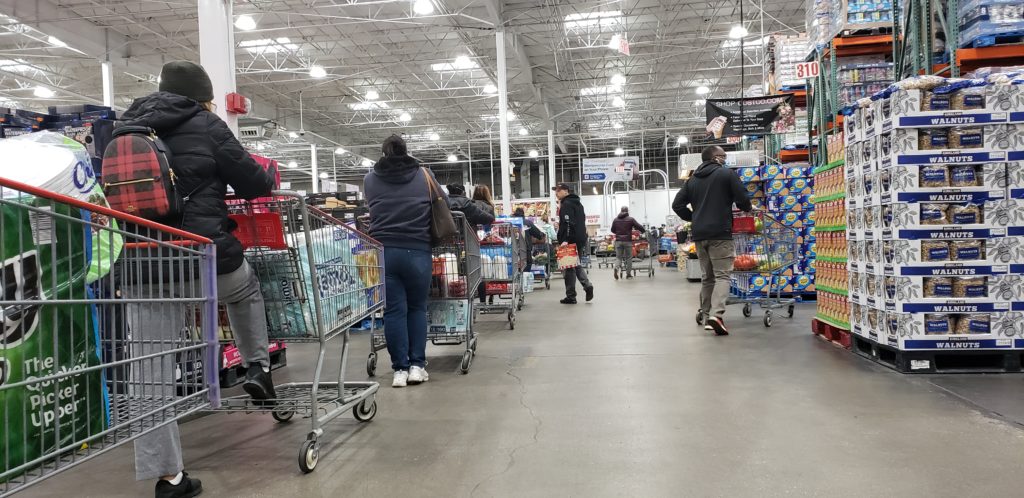
Pictured: Costco shoppers in Commack practiced social distancing on Saturday as they wait to be rung up by workers in protective gloves. (Photo Credit – Richard Murdocco/The Foggiest Idea)
A new COVID-19 testing center has opened at the ProHEALTH Urgent Care in Riverhead, adding to the company’s testing locations at Jericho, Lake Success, and a location in Little Neck, Queens. New York State also operates testing sites at both Jones Beach and Stony Brook University. “This ends when we get a fast-track test,” Cuomo added.
Throughout New York State, there are more than 160 private hospitals and health systems, while New York City has 11 public hospitals. “The distinction of private and public has to go out the window,” Cuomo said, saying that the new federal facilities add a new layer of complexity in terms of coordination. Overall, the governor sees the hospital system as a chain. “It breaks anywhere, it breaks everywhere,” Cuomo stressed, urging the need to act as one cohesive system moving forward.
Across the suburbs, Newsday is reporting that hospitals are rushing to comply with Cuomo’s directive that healthcare facilities increase their capacity by 50% to accommodate COVID-19 patients. In Mineola, NYU Winthrop Hospital is adding beds to areas such as libraries and conference rooms, while hospitals within the Northwell network are converting cafeterias and teaching areas.
Baumann & Sons, one of the Nassau/Suffolk region’s largest school bus companies, is laying off around 900 drivers and other employees due to the prolonged closure of schools. In their latest forecasts, Goldman Sachs is predicting that the economy will contract by an annualized 34% in the second quarter, with unemployment rising to 15% before recovering around mid-year.
After witnessing a growing need for medical equipment, General Motors had mobilized more than 1,000 employees and nearly 100 auto suppliers to start making ventilators. The process of securing design schematics and sourcing parts began weeks ago, and the company is in the process of retooling it’s Kokomo, Indiana plant for production. The automaker expects to eventually produce 10,000 of the machines a month, although only a few thousand will be made in the first several weeks.
On a lighter note, on Tuesday fast-food chain Taco Bell will be to giving a free beef taco to all drive-thru customers amid the coronavirus pandemic.
UPDATE AS OF 2:00 PM, MONDAY, MARCH 30TH, 2020:
In New York State, the number of confirmed coronavirus cases surpassed 66,000 and deaths topped 1,200. Over the weekend, New York State Governor Andrew Cuomo extended the stay-home order for all nonessential workers until April 15th, and President Donald Trump said that the White House would be extending social distancing guidelines through April 30th.
“Anyone who said this situation is a New York City situation only is in a state of denial,” Cuomo said during a briefing Monday afternoon, calling the state a canary in the coal mine as the virus further spreads across the country. “There is no American that is immune. What is happening to New York is not an anomaly,” he added.
On Monday, Dr. Anthony S. Fauci, director of the National Institute of Allergy and Infectious Diseases, warned that more are likely to come. “I wouldn’t be surprised if we saw over 100,000 deaths,” he said.
Under overcast skies, the USNS Comfort arrived in New York to help relieve overburdened area hospitals. This isn’t the first time that the 70,000-ton former super tanker has been docked in local waters – the 1,000 bed hospital ship came to New York days after the September 11th terrorist attacks. The ship is expected to begin receiving patients 24 hours after arriving in the city.
On Monday, Cuomo also said that the new 2,500 bed auxiliary hospital at the Jacob Javits Convention Center is operational. In addition to the auxiliary hospitals being built region-wide, a 68-bed field hospital is being constructed within Central Park. “We now have a doubling of cases every six days,” Cuomo said, noting that while the numbers are still rising, the rate of increase has continued to slow. “If there was ever a moment for unity, this is it my friends.”
“No state, no metro area, will be spared,” Dr. Deborah Birx, coordinator of the White House coronavirus task force, said of the impacts of the virus Sunday as the governors of the states of Maryland, Louisiana and Michigan described worsening conditions within their respective cities. “We remain on a trajectory, really, to overwhelm our capacity to deliver health care,” Louisiana governor John Bel Edwards said of pandemic’s spread.
Nationwide, domestic demand for gasoline fell roughly 20% in recent weeks and as much as 30% in some harder-hit regions. Macy’s, which employs roughly 130,000 people, will furlough the majority of its employees. The department store told staff on Monday that it would continue to pay health benefits and cover 100% of premiums at least through May.
On Sunday, public health experts said that wearing masks in public aren’t especially useful, with Dr. Aaron E. Glatt, chief of infectious diseases at South Nassau Hospital, telling Newsday that healthy people wearing such gear for solitary activities such as a walk around the block or drive in their car are wasting a mask. “The people who must wear a mask are physicians, respiratory therapists, and nurses,” he said.
UPDATE AS OF 12:00 PM, FRIDAY, MARCH 27TH, 2020:
The coronavirus pandemic continues to tighten it’s grip on the New York metropolitan region as hospitals saw a jump in patients requiring treatment within intensive care units. Statewide, there were over 44,000 positive cases as of Friday afternoon, with over 500 deaths.
Speaking on Friday from a newly completed auxiliary hospital within the Jacob Javits Center in Manhattan, New York State Governor Andrew Cuomo said that schools across New York are to remain closed until April 15th. In addition, most residential and commercial building will be temporarily off-limits, except for work on infrastructure, healthcare facilities, and affordable housing.
The USNS Comfort, a naval ship with 1,000 hospital beds, is expected to arrive in New York City on Monday to help add additional hospital capacity in the region. Four additional hospitals are being planned in each downstate county and the five boroughs. Currently, the state has access to 53,000 beds, and needs a total of 140,000. Hospitalizations, which stand at 6,481 as of writing, are doubling every four days, a slower rate. “The rate of increase has slowed, but the number of cases are still going up,” Cuomo said Friday.
The economic pain for New York will continue. On Thursday, Cuomo warned of pending budget cuts as the state faces a $10 to $15 billion in lost revenue. “New York State is basically bankrupt,” Cuomo said during a radio interview late Thursday. “You are going to see education cuts all across the state.”
The Long Island Rail Road is moving towards a reduced schedule on Friday in response to the steep reductions in ridership. According to Newsday, regular weekday capacity will be reduced by about 68%, with around 500 trains running, instead of the usual 740. In Long Beach, the popular 2.2 mile boardwalk was closed indefinitely as of 8 PM Thursday evening due to the crowding.
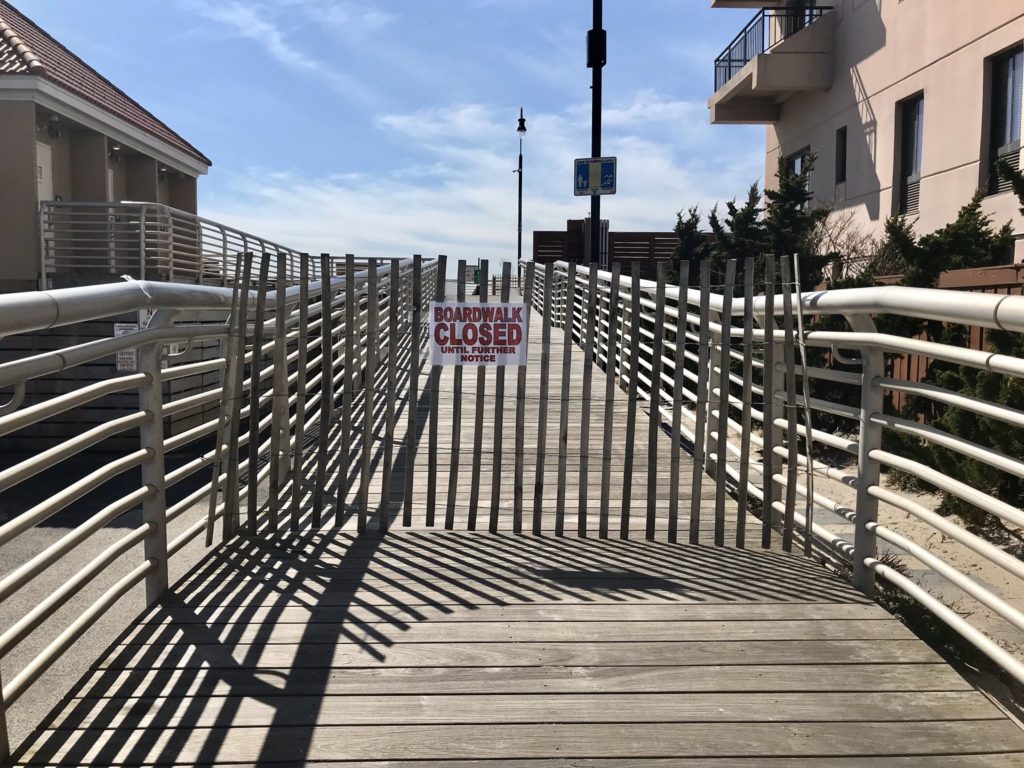
Pictured: A sign and barrier blocking people from entering the boardwalk in Long Beach, New York on Friday. (Photo Credit – Kristin Thorne/WABC)
Governors across the country are now calling for travelers from the New York area to self-quarantine for 14-days. The states enforcing such measures include Connecticut, Maryland, Texas, and Florida. Nationally, health officials are watching new coronavirus hotspots rapidly emerge, including within the cities of Detroit, Chicago, and New Orleans.
President Trump is moving towards loosening social distancing restrictions, which public health experts say are critical towards preventing the spread of COVID-19 across the country. As of Friday, the United States had the most coronavirus cases in the world. “A lot of progress is made, but we’ve got to go back to work,” Trump told reporters on Thursday. “We may take sections of our country, we may take large sections of our country that aren’t so seriously affected and we may do it that way, but we’ve got to start the process pretty soon, so we’ll be talking to you more about that next week.”
According to a recent Washington Post-ABC News poll, roughly 9 in 10 say they are staying home “as much as possible” and are practicing social distancing in order to lessen the risk of getting the virus. Nearly 9 in 10 say they have stopped going to bars and restaurants, and around 6 in 10 say they have stockpiled food and household supplies at home.
In an article for the New England Journal of Medicine, Dr. Anthony S. Fauci, director of the National Institute of Allergy and Infectious Diseases, and co-authors wrote that assuming a large number of asymptomatic carriers of coronavirus, “the case fatality rate may be considerably less than one percent.” Fauci and others went on to suggest that Covid-19 may ultimately be compared to a severe seasonal influenza or a pandemic influenza, rather than a disease similar to SARS or MERS, which had case fatality rates of 10% and 36%, respectively.
To help combat the virus, doctors are looking to an experimental treatment, which takes blood plasma from people who have recovered from the coronavirus, and giving it to the critically ill. Blood plasma can be a rich source of antibodies, proteins made by the immune system to attack the virus. This treatment methodology has been used for decades to treat various infectious diseases, including Ebola.
UPDATE AS OF 12:15 PM, THURSDAY, MARCH 26TH, 2020:
As coronavirus begins to hit hospitals across the New York region the hardest, the economic toll the virus is exacting became clearer on Thursday thanks to the latest jobs figures from the U.S. Department of Labor – nearly 3.3 million people filed for unemployment benefits last week, a far-cry from the previous record of 700,000.
The numbers demonstrate just how deep the economic cuts from the virus have been, driving the Senate to approve measures worth an estimated $2 trillion unanimously. The House is expected to vote on the measure on Friday, Speaker Nancy Pelosi saying she feels certain that there will be a strong bipartisan vote. Before the virus hit, the nation’s unemployment rate was 3.5 percent in February, a half-century low.
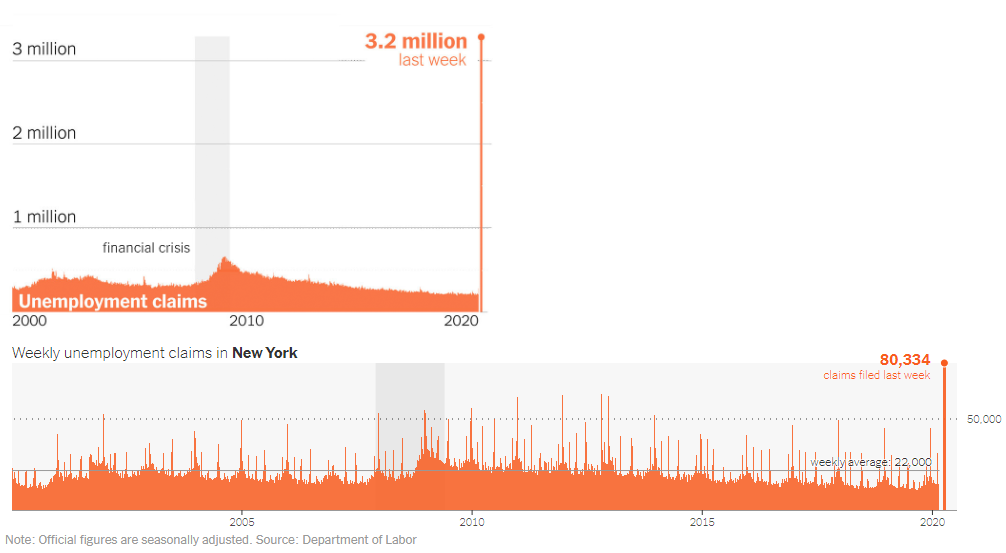
Pictured: Charts that show unemployment claims both nationally (top), and for New York State (bottom). (Photo Credit – New York Times)
New York State Governor Andrew Cuomo said on Thursday that he was disappointed with the stimulus package. “Congressional action failed to meet the governmental need,” Cuomo said Thursday, citing the sizable costs New York State faces. “I was shocked that they were so irresponsible in addressing the state and city need.”
Policymakers estimate that New York State has lost between $9 billion to $15 billion in tax revenue. The bill passed by the Senate gives New York State $5 billion in funds, all of which are earmarked for COVID-19 related expenses.
Across New York, the number of positive cases rose over 37,000.
In New York City, the epicenter of the crisis, doctors are pleading for more support as as refrigerated trucks are stationed outside to hold bodies of the dead. “I don’t have the support that I need, and even just the materials that I need physically, to take care of my patients,” Colleen Smith, an emergency room doctor at Elmhurst Hospital Center in Queens, said to the New York Times in a video. 13 people have died at Elmhurst within the past 24 hours. “It’s America. We’re supposed to be a first-world country.”
In response to the growing need for personnel in the region, the Army has dispatched 200 people to provide medical support from the 531st Hospital Center at Fort Campbell, an Army base that is located along Kentucky-Tennessee border. Since the previous day, an additional 12,000 medical professionals have volunteered their services.
“Almost any scenario that is realistic will overwhelm the capacity of the hospital system,” Cuomo said on Thursday. Cuomo said that the goal is to have an overflow hospital facility with 1,000+ beds in each county in the downstate region, including each of the five boroughs. According to state officials, COVID-19 patients are typically on ventilators from 11 to 21 days, far above the normal average of three to four, which is exacerbating the ventilator shortage problem throughout the state.
On Long Island, the New York State Department of Transportation is estimating that rush hour traffic on Long Island state roads is down anywhere from 33% to 58% along stretches of the Long Island Expressway, the Northern, and Southern State parkways on Monday compared to last year. Nationwide at a mere 10% of it’s normal volume, airline traffic has collapsed.
To those wondering when things would return to normal, Dr. Anthony S. Fauci, director of the National Institute of Allergy and Infectious Diseases, was blunt. “You’ve got to be realistic and you’ve got to understand that you don’t make the timeline,” Fauci told Chris Cuomo on CNN in an interview Wednesday night. “The virus makes the timeline.”
UPDATE AS OF 12:00 PM, WEDNESDAY, MARCH 25TH, 2020:
In the earliest hours Wednesday, both Congress and the White House came to an agreement on the biggest fiscal stimulus package in modern American history. The roughly $2 trillion stimulus measure will send direct payments and jobless benefits to individuals, and much-needed money to states and businesses who have been devastated by the coronavirus.
With it’s ever-ballooning number of cases that double every three days, New York has fast become the national hot-spot of the pandemic. White House officials are now saying that anyone who recently left New York should self-quarantine at home for 14 days in order to prevent the infection of other regions. “We’re starting to see new cases across Long Island that suggest people have left the city,” Dr. Deborah Birx, the White House coronavirus coordinator, said during a briefing on Tuesday.
Nationwide, 28% of coronavirus testing has occurred in New York State, which is now home to over 30,000 positively identified cases. 12% of those who tested positive have been hospitalized, and 3% of that figure are in intensive care units.
According to state officials, the pandemic’s apex is expected to hit the New York region within two to three weeks.
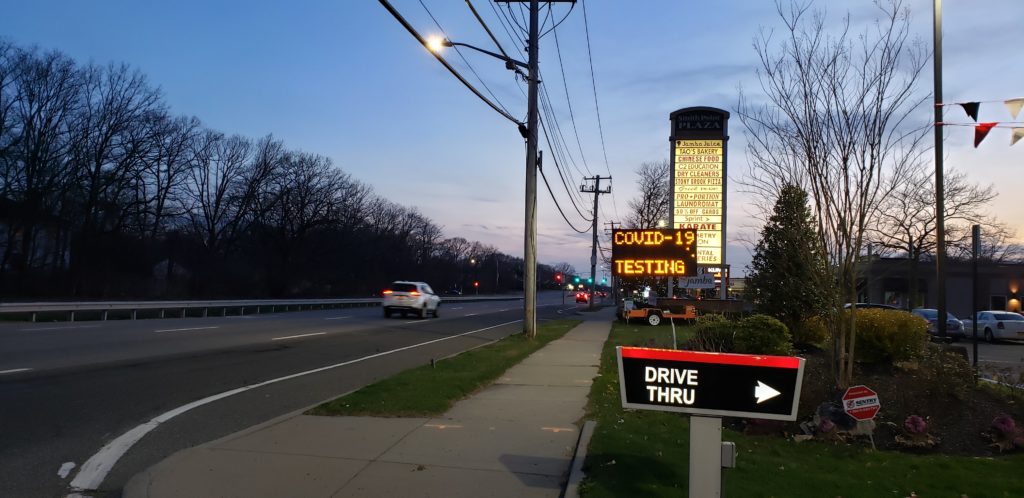
Pictured: A sign on NYS Route 347 in Stony Brook directing people to a nearby COVID-19 testing site. (Photo credit – Richard Murdocco/The Foggiest Idea)
On Tuesday, New York State Governor Andrew Cuomo continued to plead the Trump administration to send much-needed ventilators to the region. “FEMA says we’re sending 400 ventilators,” Cuomo mused Tuesday, before his voice darkened. “What am I going to do with 400 ventilators when I need 30,000?” Shortly after the remarks were made, Vice President Mike Pence said that 4,000 ventilators will be shipped to New York.
“This is our single greatest challenge, is the ventilators,” Cuomo said during a briefing Wednesday. “Send us the equipment that we need, as soon as we get past our critical moment, we will redeploy that equipment to the next hot spot,” he added, saying that he argued for a rolling deployment in terms of allocating supplies, essentially shifting from apex to apex across the country.
Cuomo also noted that the evidence is now suggesting that the density control measures are working in areas such as Westchester, where the rate of new infections has slowed. “The theory is, given the density we’re dealing with, it spreads very quickly, but if you reduce the density, you can reduce the spread very quickly.”
Cuomo estimated that the state can have a potential capacity of around 119,000 beds after the creation of supplemental facilities and converting existing locations to make-shift hospitals. As of writing, over 40,000 New Yorkers have responded to the state’s call for retired health care workers to return to duty, while over 6,100 mental health professionals have volunteered their services.
As the subway continues to operate with limited service due to personnel shortages, Patrick Foye, chairman and CEO of the MTA said Tuesday that subway ridership was down 76%, and on buses it dropped 62%. The commuter railroads saw even steeper drops – the Long Island Rail Road dropped 71%, and Metro-North was down 94%. In response, the agency has moved to the implement the “NY Essential Service Plan,” will reduces service across the board. The plan goes into effect on Friday, March 27th. Foye said on Wednesday that the agency will need more than $4 billion to survive the COVID-19 crisis.
Nationally, President Trump says he would like to restart the faltering U.S. economy by the Easter holiday, which falls on April 12th. Any actions to limit mitigative measures goes against the advice of health experts who warn that current restrictions might need to stay in place for months to avert a rising tidal wave of American deaths.“The virus will surge, many will fall ill, and there will be more deaths,” Dr. William Schaffner, a preventive medicine expert at the Vanderbilt University School of Medicine, told the New York Times.
In an op-ed published in the Wall Street Journal on Wednesday, doctors Eran Bendavid and Jay Bhattacharya, both professors of medicine at Stanford, argued that it’s important to remember that the true fatality rate for coronavirus is the portion of those infected who die, not the deaths from identified positive cases. “A universal quarantine may not be worth the costs it imposes on the economy, community and individual mental and physical health,” they wrote, stressing the need for additional data-backed evidence. “We should undertake immediate steps to evaluate the empirical basis of the current lockdowns.”
UPDATE AS OF 12:00 PM, TUESDAY, MARCH 24TH, 2020:
The “attack rate” of coronavirus, or the percentage of a population that has a disease, is five times higher in the New York metropolitan region than other areas of the country, with one in 1,000 having contracted the virus. 28 percent of tests for the coronavirus in the area are coming up positive, while the rate was less than 8 percent in the rest of the country. In total, there are over 25,000 positively identified cases throughout New York State.
The figures further cement New York as the country’s epicenter of the pandemic. “New York is going first. We have the highest and the fastest rate of infection,” Governor Andrew Cuomo said during his Tuesday press conference. “What is happening to New York is going to wind up happening to California, and Washington state, and Illinois.”
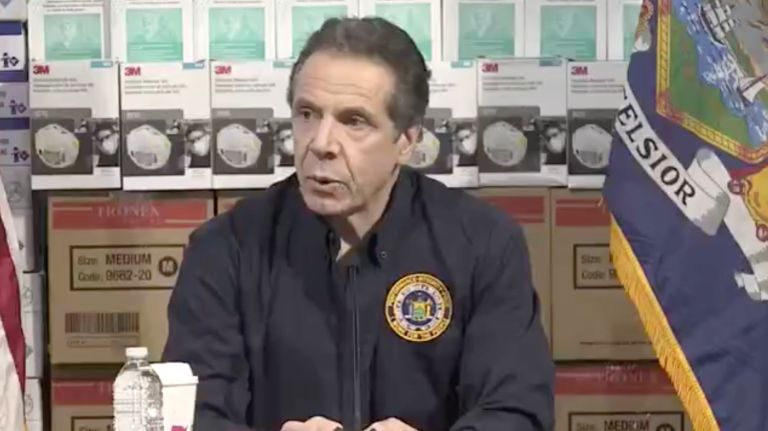
Pictured: New York Governor Andrew Cuomo briefs reporters from the Javits Center in Manhattan on Tuesday. (Photo credit – NYS Governor’s Office)
On Long Island, construction of temporary hospitals at SUNY Stony Brook and SUNY Old Westbury is set to begin, and state officials are saying that the goal is to have them operational in two to three weeks. Both temporary facilities will be able to take in 500 patients each. The soon-to-be constructed facility at the Jacob Javits Center in Manhattan will have a capacity of 1,000.
Across the city, various subway lines are beginning to experience service disruptions due to lack of train crews. Commuter railroads have not seen any disruptions due to coronavirus at this time.
Nationally, President Trump has been showing support for scaling back steps taken to contain the outbreak, countering the advice of health experts who say that extreme social distancing is still necessary to further curb the disease. “America will again and soon be open for business — very soon,” Trump said at the daily White House news conference Monday. “We cannot let the cure be worse than the problem itself.”
Wall Street’s reaction to the prospect of such actions were mixed. “Think of it as a trade: What’s the risk of reopening early?” Adam Sarhan, a CEO of an Orlando-based investment firm, told The Washington Post. “The risk is the number of cases continues to skyrocket, and longer term, you’re just digging a much deeper hole.”
In congress, senate and house leaders have voiced optimism that a deal is at hand, though they acknowledge some hurdles remain. Markets continued to rise sharply in anticipation of a deal, with the Dow Jones industrial average up more than 1,400 points, or nearly 8 percent by midday.
On the state-level, there continues to be growing momentum across the country among governors to issue “stay-at-home” orders, with states such as Hawaii, Illinois, Indiana, and New Mexico joining a growing roster. “Our society must continue to operate — but in an extremely limited way,” New Mexico governor Michelle Lujan Grisham said.
Home buying activity, which typically reaches it’s peak in the spring and summer months, has slowed drastically on Long Island. Before the coronavirus, the region’s real estate markets remained hot thanks to low inventory, low interest rates, and high demand from buyers. With home showings slowing, even buyers looking to seal the deal are struggling to get to the finish line – Closings have become more complicated thanks to the closure of county clerk offices in Nassau and Suffolk counties, and buyers are looking for solutions with attorneys, title company and agents.
While grocery stores have remained mostly stocked as of writing, changes to the methodologies that typically determined levels of inventory have been upended due to the pandemic.
According to reports in the Wall Street Journal, the panic runs on grocery stores has exposed the downsides of the food industry’s push to hold less stock and take delivery from fewer, fuller trucks in order to increase profit margins. In the wake of the virus, grocers and their vendors are now making as much food as they can, and working to deliver it as fast as possible.
UPDATE AS OF 12:15 PM, MONDAY, MARCH 23RD, 2020:
According to statistics released Sunday by New York State Governor Andrew Cuomo, the New York metropolitan region accounts for roughly 5 percent of positively identified coronavirus cases worldwide.
Throughout New York City, 1,800 people have been hospitalized, including 450 in intensive care units. All told, the city reported 12,305 positive cases of coronavirus as of Monday. So far, there had been 99 fatalities, a figure that is expected to climb as local hospitals become inundated with additional coronavirus cases. On Long Island, the totals neared 4,000.
To help supplement existing hospital capacity, Mr. Cuomo said Sunday that the Federal Emergency Management Agency is going to build four hospitals with 1,000 total beds at the Jacob K. Javits Convention Center in Manhattan, with additional sites being constructed at SUNY Stony Brook, SUNY Old Westbury, as well as a location in Westchester County.
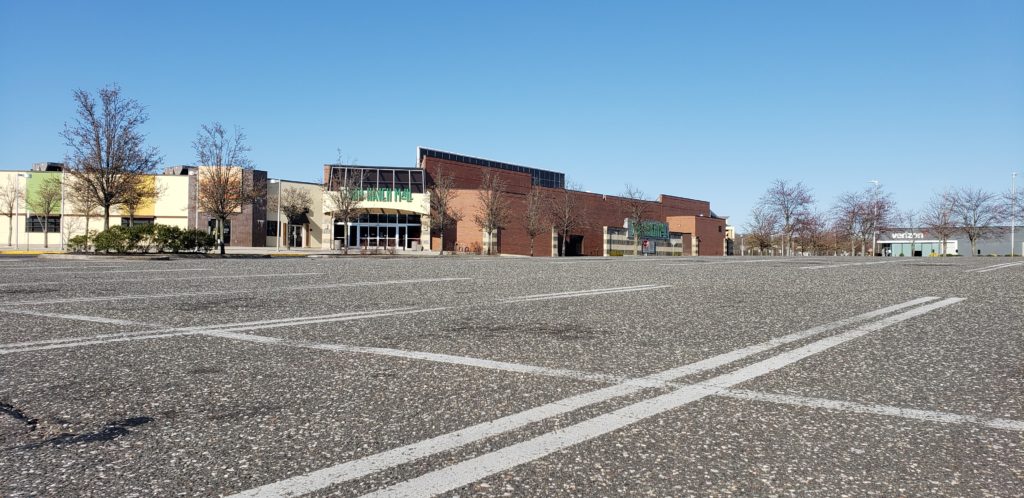
Pictured: A usually busy Smithaven Mall sits shuttered on Saturday as mall operators closed their locations across Long Island. (Photo Credit – Richard Murdocco/The Foggiest Idea)
Across Long Island, a statewide order closed nonessential businesses to the public at 8 p.m. Sunday. According to Newsday, there’s no formal end date to the shut down, though the governor’s executive order expires on April 19th. After that, the governor’s office has said that it would evaluate then whether it needs to be extended.
State-wide, more than 30,000 retired doctors and health care professionals have responded to the state’s call to volunteer their services, and the state is now able to test 16,000 individuals daily, up from 1,000 ten days ago.
As of writing, public transportation was running with normal weekday service. According to MTA chairman Patrick J. Foye, the region’s subways, buses and commuter trains “will operate during the entire pandemic.”
While many local businesses have been struggling, some sectors are booming. “It’s like Christmas in March,” a liquor store employee in Melville told Newsday. “Don’t panic, there’s plenty of liquor and wine in the pipeline,” a manager of another store in Bethpage told the publication. “There’s no need to hoard it. We’re considered an essential service. We’ll still be here.”
In Congress, senate leaders and Trump administration officials are resuming talks on a giant economic stimulus bill, after weekend negotiations failed to produce a deal on the legislation. The negotiations on how to best prop up a hard-hit economy came as the Federal Reserve unveiled a major expansion of lending programs that are designed to keep credit markets functioning.
Nationally, Michigan, Ohio and Louisiana became the latest states to announce stay-at-home orders, and both the Maryland and Massachusetts governors ordered nonessential businesses to close.
Meanwhile, it came to light over the weekend from the Washington Post that U.S. intelligence agencies were issuing warnings throughout January and February about the global danger posed by the coronavirus, according to U.S. officials familiar with spy agency reporting.
UPDATE AS OF 2:30 PM, FRIDAY, MARCH 20TH, 2020:
A wide-ranging executive order from New York’s governor is slated to take-effect Sunday evening that mandates all non-essential businesses are to keep workers home. Non-essential gatherings of individuals of any size for any reason are now banned throughout the state.
As of writing, mass transit will remain operating, and roadways will stay open, and Uber is reporting drastic drops in ridership in the hardest-hit areas.
Between the lockdowns in both New York and California, about 60 million people are essentially ordered to stay at home. The staggering figure amounts to roughly 18% of the U.S. population. “This is the most drastic action we can take,” Mr. Cuomo said, as the number of positively identified cases surges past 7,000, 1,000 of which are on Long Island alone. New York State accounts for nearly half the national cases of coronavirus.
State-wide, the push for creating much-needed additional hospital capacity is on, as the Army Corps of Engineers is helping to build more hospital beds and is examining several potential sites for them.
Home builders are bracing themselves for a sudden drop in demand due to the outbreak and the weakening U.S. economy. Together, both are poised to slow construction and further exacerbate a national housing shortage.
Across Long Island, roadways were quiet, malls were shuttered, and restaurants offered a variety of take-out options to supplement their typical in-house services. “I feel better already,” Newsday’s food critic Scott Vogel said as he chewed a piece of steak, part of a $90 take-out meal he ordered from Huntington’s Prime Steakhouse.
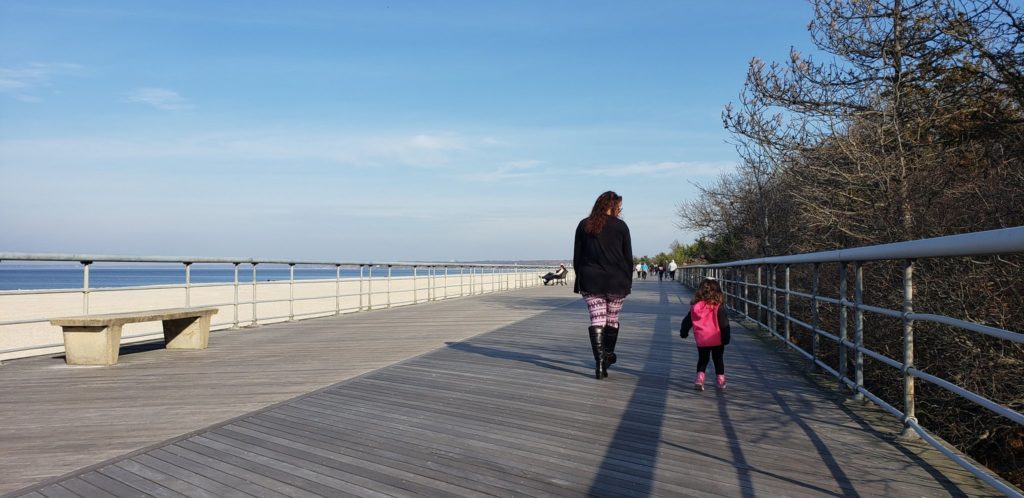
Pictured: On Friday, Long Islanders seeking respite from “stay-at-home” orders due to coronavirus have flocked to the region’s recreational areas such as Sunken Meadow State Park in Kings Park. (Photo Credit – Richard Murdocco/The Foggiest Idea)
On Friday, President Trump said that federal government isn’t considering a national lockdown, like those in Italy and France, but the State Department has now advised U.S. citizens to not travel internationally, and is urging those overseas to return home immediately or remain abroad indefinitely. The borders with Mexico and Canada will be closed midnight on Saturday.
Nationally, borrowers with student loan debt can defer payments, and standardized testing requirements will not be waived. The IRS has pushed the federal income tax deadline to July 15th, a move New York will mirror. In Congress, elected officials are working towards hammering out a $1 trillion+ economic relief package to help soothe volatile markets. The measure includes invoking the Defense Production Act to get ventilators and other medical equipment in short supply quickly made. In hard-hit states like New York, the governor estimates over 30,000 ventilators will be needed in the coming weeks. #GetaFoggyIdea
UPDATE AS OF 1:15 PM, THURSDAY, MARCH 19TH, 2020:
Testing across New York has surpassed 7,500 individuals, the number of positively-identified cases of coronavirus infections state-wide has surged.
As anxious New Yorkers continue to expect a city-wide shutdown, Governor Andrew Cuomo was direct. “It’s not going to happen,” he said about the prospect during a morning press conference in Albany, citing rumors he has heard in recent days.
During appearances on the morning news shows, Cuomo explained further. “‘Shelter in place’ is a scary term for people, especially when they don’t know what it means,” he said. The governor noted he supports the concept of restricting activity in hard-hit areas, but not the language used to communicate such policies, which still allows people to exercise and go out to buy groceries or medicine.
For the hardest-hit homeowners, the governor also announced that he is waiving mortgage payments for 90 days and looking to do the same for ATM fees, credit card interest, and overdraft charges.
Across New York, state-wide density controls placed by the governor’s executive order yesterday were increased from 50% to 75% of the workforce in non-essential services, as shopping malls, amusement parks and bowling alleys in the tristate region will be shuttered, effective Thursday evening 8 p.m..
Newsday reports that locations such as Roosevelt Field in Garden City, Walt Whitman Shops in Huntington Station, Smith Haven Mall in Lake Grove, Westfield South Shore in Bay Shore, Westfield Sunrise In Massapequa, Broadway Commons in Hicksville, Tanger Outlets Deer Park and Tanger Outlets Riverhead will all be shuttered for the foreseeable future.
In the city, where a continuing surge of newly discovered cases is expected, a report has forecast that the five boroughs would need nearly 11 times as many hospital beds more than what is currently available.
Nationally, the White House’s $1 trillion economic relief package is proposing payments of $1,000 for adults and $500 for children, while lawmakers try to enact remote voting for Congress as members are now testing positive for the virus. As of this update, it is unclear if Americans of every income bracket will be eligible for the relief checks, and the payment amounts, but a first set of checks are expected to be issued starting April 6, with a second wave sometime in mid-May.
Across the country, doctors and nurses are pleading for protective gear as they face shortages, and health experts are warning younger Americans that the virus can impact them too, as a new study from the CDC shows that 38 percent of those sick enough to be hospitalized were younger than age 55. In New York, 19% of overall COVID-19 cases in the state have required hospitalization.
In China, where the virus first emerged, no new locally transmitted cases have been reported for the first time since the outbreak began. #GetaFoggyIdea
UPDATE AS OF 12:30 PM, WEDNESDAY, MARCH 18TH, 2020:
The coronavirus has now been found in all fifty states as the pandemic shuts down jurisdictions one-by-one across the country and continues to shock the global economy.
In New York, now considered the national epicenter of the crisis due to the sheer volume of newly discovered cases, Governor Andrew Cuomo announced that the federal government has committed to supplying the skills of the Army Corps of Engineers to assist in creating new hospital bed capacity state-wide. The governor also announced Wednesday that no business can have 50% of their workforce can report for work outside of their home. The executive order will exempt what Cuomo said were “essential services,” including food, pharmacies, healthcare, shipping, supplies, and others.
According to the MTA, ridership on mass transit has plummeted. Subway ridership had fallen 60 percent and that bus ridership had fallen 49 percent on Monday, compared with the same day last year. The drops in ridership were even more drastic on the suburban commuter railroads – 90 percent on the Metro-North Railroad and 67 percent on the Long Island Rail Road.
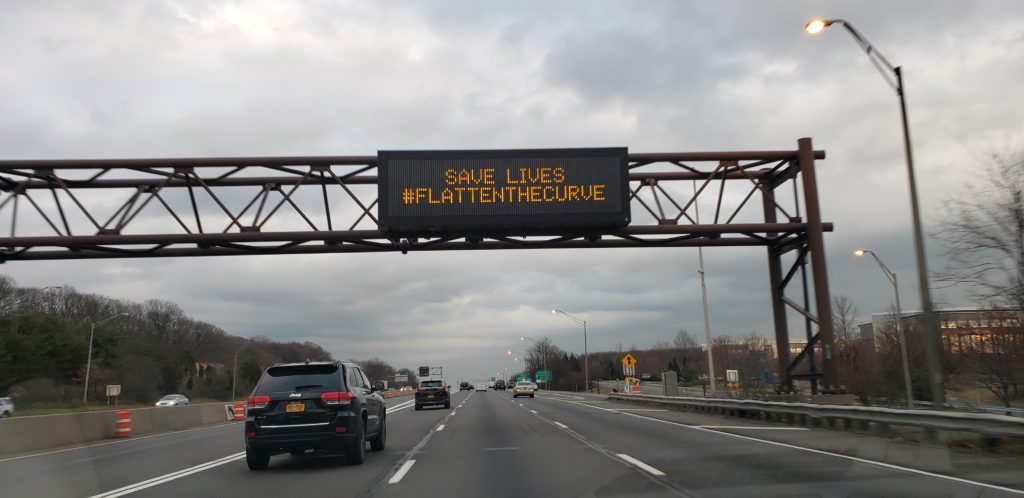
Pictured: Signs on the Long Island Expressway urge commuters to flatten the curve of infections of coronavirus by staying home. (Photo credit – Richard Murdocco/The Foggiest Idea)
While most parks and playgrounds remain open, experts urge caution around outdoor furniture and play equipment, as research shows that the coronavirus can live for days on some surfaces, including plastics. Malls in New Jersey have shuttered to weather the pandemic, while Macy’s retail locations are following suit. Grocer Stop & Shop will be offering shopping hours for seniors over 60 from 6:30 am to 8 am every morning.
Nationally, President Trump has announced that the U.S. border with Canada will be temporarily closed to ‘non-essential traffic.’ The U.S. Treasury is proposing delivering $500 billion in checks directly to millions of Americans, with the first round coming April 6. The effort is part of a broader $1 trillion effort. A hospital ship, the USNS Comfort, will be sent to New York City Harbor to offer supplementary hospital capacity.
A study from China has provided confirmation that coronavirus infections are in fact generally less severe in kids, with more than 90 percent having mild to moderate disease or even being asymptomatic. Infants are at a greater risk of severe illness, and the paper suggests that children may be a critical factor in the disease’s rapid spread. An Italy, a study from the country’s national health authority found that 99% of their coronavirus fatalities were people who suffered from previous medical conditions.
Dr. Anthony S. Fauci, the director of the National Institute of Allergy and Infectious Diseases, has said not to worry about reports that ibuprofen poses health risks for young coronavirus patients. “There really is no solid evidence at all, maybe true; may not, but there’s no good scientific evidence that says ibuprofen can make coronavirus worse,” he said. #GetaFoggyIdea
UPDATE AS OF 12:15 PM, TUESDAY, MARCH 17TH, 2020:
With President Trump calling New York “the number one hot spot” for coronavirus in the country, the state is now home to over 1,000 positively identified cases of the virus. Meanwhile, state and local governments are bracing for a crush of demand on local medical facilities in the coming weeks.
Overall, identification of the virus has further accelerated as testing becomes more widely available, with the state being home to 1,374 positive cases. The state is home to two regional hot spots of the virus’ spread, New York City and Westchester County. Across the boroughs, 644 cases have been found, while the northern suburb is home to 380. On Long Island, Nassau County has 131, and Suffolk County has 84.
Despite a call from New York City Council speaker Corey Johnson to completely quarantine the five boroughs, New York State’s governor Andrew Cuomo stated in a Tuesday morning briefing that he will not take such action at this time. “It cannot happen. No city in the state can quarantine itself without state approval, and I have no interest whatsoever and no plan whatsoever to quarantine any city,” Cuomo said.
Cuomo stressed that if any shelter-in-place measures are enacted, they would be regional and state-wide in their scope, similar to to the bans on local businesses that took effect last night at 8 PM. “To the extent you can, come up with a policy uniformly,” he said of such actions, adding that the curve of infection is not flattening to “a level that which we can sustain,” implying that future mitigative measures may be taken in the coming days. The state estimates that the crisis will peak in about 45 days.
Nationally, the Trump administration is looking to inject roughly $850 billion in fiscal stimulus to help prop up the economy, which has suffered steep successive losses since the virus first emerged. “We are looking at sending checks to Americans immediately,” Treasury Secretary Steve Mnuchin said during an afternoon press conference. “We have to do this now.” The details of the proposal are slated be worked out by end-of-day.
Across the Bay Area, residents and businesses are on lockdown in six counties, with elected officials calling on people to stay home except for essential needs through April 7th. The lockdown orders can be extended based on the evolving situation.
Nationwide, calls have intensified for increased acts of social distancing, which experts argue could prevent the United States from facing an ever-escalating crisis. President Trump urged Americans against gathering in groups larger than 10 people for the 15 days from yesterday, while European nations have enacted countrywide lock downs. There, countries are facing a shortage of critical medical supplies.
Locally, Long Island’s water providers are stressing that the region’s tap water is safe to drink and is readily available to meet present and future demand. Since chlorine is already used by all local water districts to kill bacteria and other pathogens, the coronavirus cannot infect the drinking supplies. “You will always have a public water supply available,” Dennis Kelleher of the Long Island Water Conference, told Newsday. #GetaFoggyIdea
UPDATE AS OF 12:30 PM, MONDAY, MARCH 16th, 2020:
New York State Governor Andrew Cuomo has announced sweeping measures to mitigate against the spread of Coronavirus, including a tri-state agreement that spans New York, New Jersey, and Connecticut that will prohibit gatherings of 50 people or more, as well as shutter bars, restaurants, movie theaters, and gyms, effective at 8 PM this evening.
Take-out services will still be available to residents from bars and restaurants, and critical businesses, including grocery stores, gas stations, pharmacies, and medical facilities will remain open.
Schools across New York City and Long Island are closed until further notice. By end-of-day, all schools in New York State will be closed for a minimum of two-weeks. “If in two weeks, miraculously, everything is fine, I will reopen every school,” Cuomo said during a press conference Monday afternoon.
As of writing, Mr. Cuomo and his counterparts said there were no plans to close public transit or rail service in or between the states.
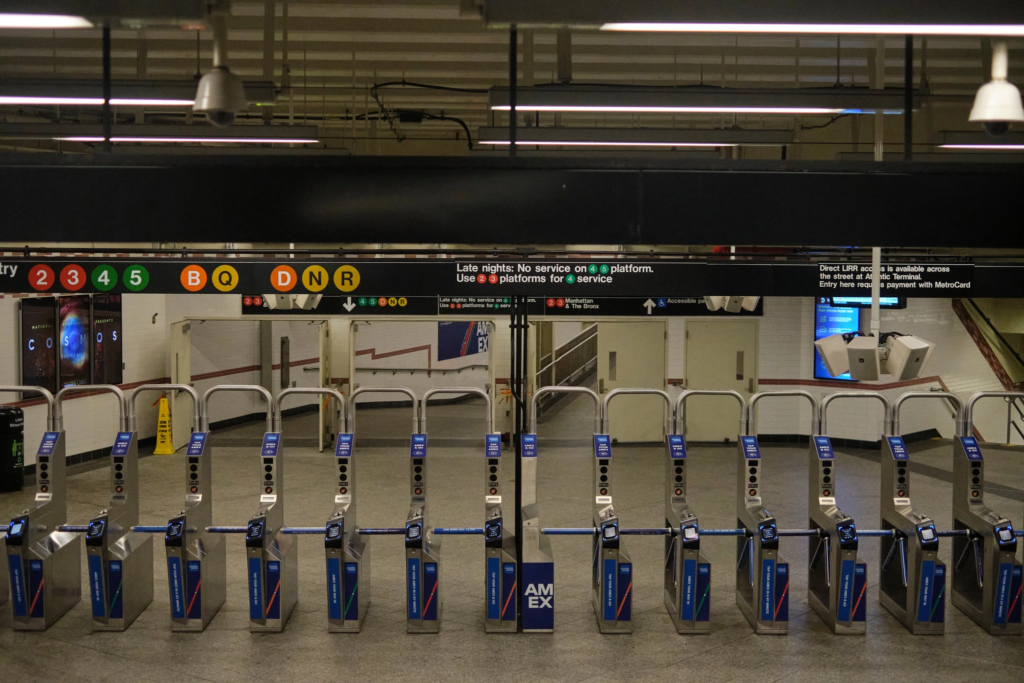
Pictured: Atlantic Terminal in Brooklyn sits empty as commuters avoid mass transit systems. (Photo Credit – John Taggart/The New York Times)
There are a total of 950 cases statewide, with 463 cases in New York City, 220 in Westchester County, 109 in Nassau County, and 63 in Suffolk County. The largest increases of new cases are found in both NYC and Westchester, where the governor says the density of positive cases has helped accelerate the virus’ spread in those areas.
New York has approximately 53,000 hospital beds, and just more than 3,000 intensive care beds. About 80 percent of which are already occupied, and the governor is calling on the federal government for the necessary resources to build more capacity in the coming days. “When you look at the projections, there’s every chance that we could be Italy,” the U.S. surgeon general warned. Widespread social distancing could help change that trajectory, he said.
Meanwhile, rumors circulating of a mandatory national quarantine are completely false, the White House had said.
The virus continues to take it’s toll on financial markets. Despite drastic intervention by the Federal Reserve to lower rates, the move did little to halt the Dow Jones industrial average from dropping 2,250 points at the open. Trading suspended almost immediately, as the market’s internal circuit breakers, which stem losses over 7%, took effect.
So far at the Hunts Point Produce Market, which serves as the largest hub for food distribution within the New York metropolitan area, the supply chain is “steady and normal,” and policymakers have noted that there is no shortage in labor.
For accurate up-to-date information on the latest developments related to the Coronavirus, be sure to read well-established news sources and follow the official social channels of federal, state, and local agencies, including those of the Centers for Disease Control and New York State. #GetaFoggyIdea
UPDATE AS SUNDAY, MARCH 15TH, 2020, 2:30 PM
New York State is now home to a total of 729 confirmed cases of Coronavirus, 329 of which have been found within New York City.
Based on the latest figures as of writing, New York State contains the highest concentration of positively identified cases in the country. So far, three deaths in New York were announced by state officials, and Governor Andrew Cuomo noted Saturday that just over 20 percent of the total cases in New York were of people who were hospitalized.
The spread continues in the immediate suburbs, with Westchester County having a total of 196 cases, while Nassau has 98 and Suffolk has 47. Dr. Anthony S. Fauci, the director of the National Institute of Allergy and Infectious Diseases, cautioned on NBC’s Meet the Press that “Americans should be prepared that they are going to have to hunker down significantly more than we as a country are doing.”
After businesses saw a still-vibrant social scene Saturday night, elected officials in the City are increasingly calling for both the governor and mayor to order closures of restaurant and bars. Across the Hudson in Hoboken, the mayor has effectively closed such establishments and declared a mandatory nightly curfew. The measures being taken under consideration state-wide across New Jersey.
Across Long Island, both Nassau County Executive Laura Curran and Suffolk County Executive Steve Bellone announced that all public and private schools in the counties will close for two weeks beginning Monday. “We felt as part of our containment strategy, that we’ve reached that step to close the schools,” Curran said during a Sunday morning press conference announcing the measure. Meanwhile, Jake’s 58, a popular casino venue in the Village of Islandia, was ordered to temporarily close as well.
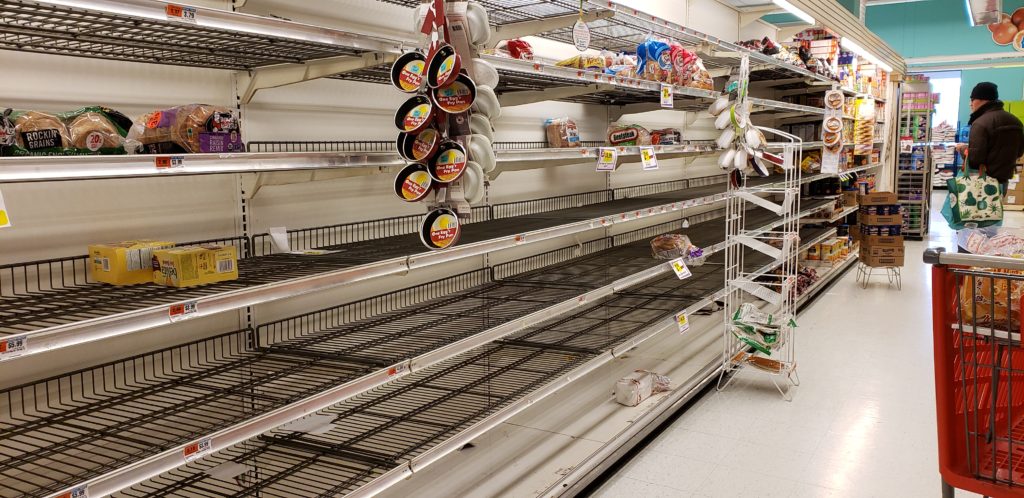
Pictured: A shopper browses an empty bread aisle at the Best Market in Commack, NY. Staff at the store said that deliveries aren’t keeping up with buyer demand. (Photo Credit: Richard Murdocco/The Foggiest Idea)
Nationally, there is confirmation that the virus has further spread, with hundreds of new cases being diagnosed in every state but West Virginia, and Puerto Rico had announced its first confirmed cases on Friday. The White House announced that President Trump has tested negative for Coronavirus. The president was tested after concerns due the prolonged contact with various people who later tested positive for the virus.
Airports across the country are inundated as passengers on U.S. flights returning from Europe are waiting hours to go through enhanced health screenings, and grocery chains and other retailers hit hardest by panic shopping are limiting their operating hours to allow time for thorough cleaning and restocking. On Long Island, all Stop & Shop stores will be open from 7:30 AM to 8 PM, and King Kullen stores will be open from 8 AM to 8 PM.
For accurate up-to-date information on the latest developments related to the Coronavirus, be sure to read well-established news sources and follow the official social channels of federal, state, and local agencies, including those of the Centers for Disease Control and New York State.
UPDATE AS SATURDAY, MARCH 14TH, 2020, 2:00 PM
As new testing becomes available, newly discovered cases of Coronavirus across New York State have increased to a total of 524, with New York City being home to 213 confirmed cases. In the city’s surrounding suburbs, there were 172 confirmed cases in Westchester County, 68 confirmed cases in Nassau County and 33 in Suffolk County.
Earlier Saturday, New York State reported it’s first death from the disease, an 82-year old woman from Brooklyn who had emphysema, and contracted the virus while in she was in the hospital for treatment of that condition.
As of writing, Mayor Bill de Blasio says that New York City public school system is to remain open despite growing public pressure to shutter them, and a state-imposed limit of public gatherings took effect Friday evening at 5 PM. According to the New York Times, the federal Centers for Disease Control has said that other countries that closed schools did not necessarily have more success in curbing the virus’s spread than those that did not.
Commuter railroads and the subways across the region are operating on their normal weekend schedules, and area bridges and tunnels are open to traffic.
Nationally, the Trump administration has declared a national emergency, allowing for a more free-flow of funding and resources to federal agencies to combat the virus. The United States has announced an expansion of it’s European travel ban, widening the scope to include the United Kingdom and Ireland. In congress, the House of Representatives has passed an economic relief bill that dedicates tens of billions of dollars for items such as paid sick leave, unemployment insurance, free testing and other actions. The Senate is expected to vote to pass the measure sometime next week.
The unexpected surges in demand for toilet paper, which is being called “sporadic and regional,” is expected to subside, according to retailers and industry experts. According to reports in the Washington Post, supply will continue to grow as companies keep making toilet paper. Industry data shows that 90 percent of the toilet paper sold in the United States is made domestically.
For accurate up-to-date information on the latest developments related to the Coronavirus, be sure to read well-established news sources and follow the official social channels of federal, state, and local agencies, including those of the Centers for Disease Control and New York State. #GetaFoggyIdea
UPDATE AS OF FRIDAY, MARCH 13TH, 2020, 2:30 PM: Since Wednesday, March 11th, there have been 209 new cases of Coronavirus discovered across New York, bringing the total amount of known cases to 421. As of writing there are a total of 154 known cases in New York City, 158 in Westchester County, 51 in Nassau County, and 28 in Suffolk County. This data is sourced from the office of NYS Governor Andrew Cuomo.
Local officials stress that newly discovered cases are to be expected as testing capacity increases state-wide, but the key issue for policymakers is ensuring that healthcare facilities do not become overwhelmed by patient demand. As the governor stated during his now daily afternoon briefing, the number of positive cases is a direct reflection of the level of increased testing capacity – not the number of people who in-fact have the Coronavirus. “These are not random sample tests,” Cuomo said, noting that health care experts feel the number of those with the virus is likely larger. “I believe they will say it is much more widespread today than you know, and it was here before you knew it,” he added.
As of writing, mass transit systems in the Metropolitan Transportation Authority (MTA)‘s network, including NYC Transit, LIRR, and Metro-North, are open to the public, and fully operational. As per Newsday, the MTA is reporting that LIRR ridership was down 31% Thursday morning as compared to the same day last year, and automotive traffic the region’s bridges and tunnels has fallen by 6%.
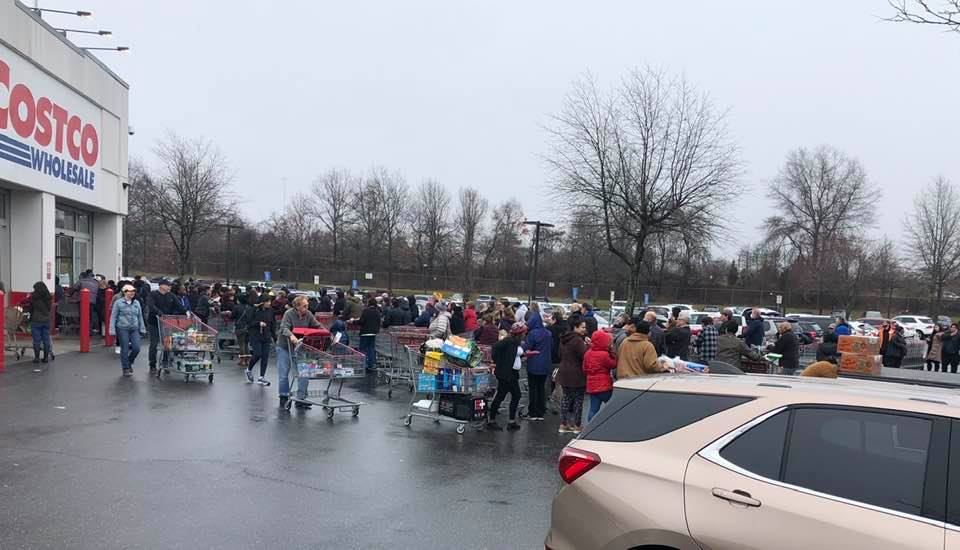
Pictured – Lines of shoppers formed outside of Costco in Commack Friday afternoon, as Long Islanders look to stock-up in response to the Coronavirus. (Photo credit – Dr. Mitchell Cooperman)
According to the governor, the decision to close schools are being made on a case-by-case basis by localities, with various districts on Long Island choosing to close in order to thoroughly sanitize their facilities. (For Newsday’s list of districts that have closed, click here: https://www.newsday.com/
Meanwhile, Long Islanders have taken to their local grocery and warehouse stores, buying self-stable items in bulk quantities. Some chains, such as ShopRite and Stop & Shop, have placed limits on the number of in-demand products people can purchase.
For accurate up-to-date information on the latest developments related to the Coronavirus, be sure to read well-established news sources and follow the official social channels of federal, state, and local agencies, including those of the Centers for Disease Control and New York State. #GetaFoggyIdea

